

Merfyn Owen, Marc Lombard & Britton Ward on the Class 40
- August 13th, 2016
Since I set first set foot on a Class 40 Racing Yacht – the Pogo 40 operated by Sailingisland.de on a fast trip to the Island of Helgoland and back (read it here and here ) – I was fascinated by this class: Seemingly effortless fast sailing with +10 knots even in light breezes, fantastic behavior of the boat beating, reaching and close hauled and a load of space on a 40 feet boat only comparable to +45 feet ordinary boats. Pogo-Virus had me.
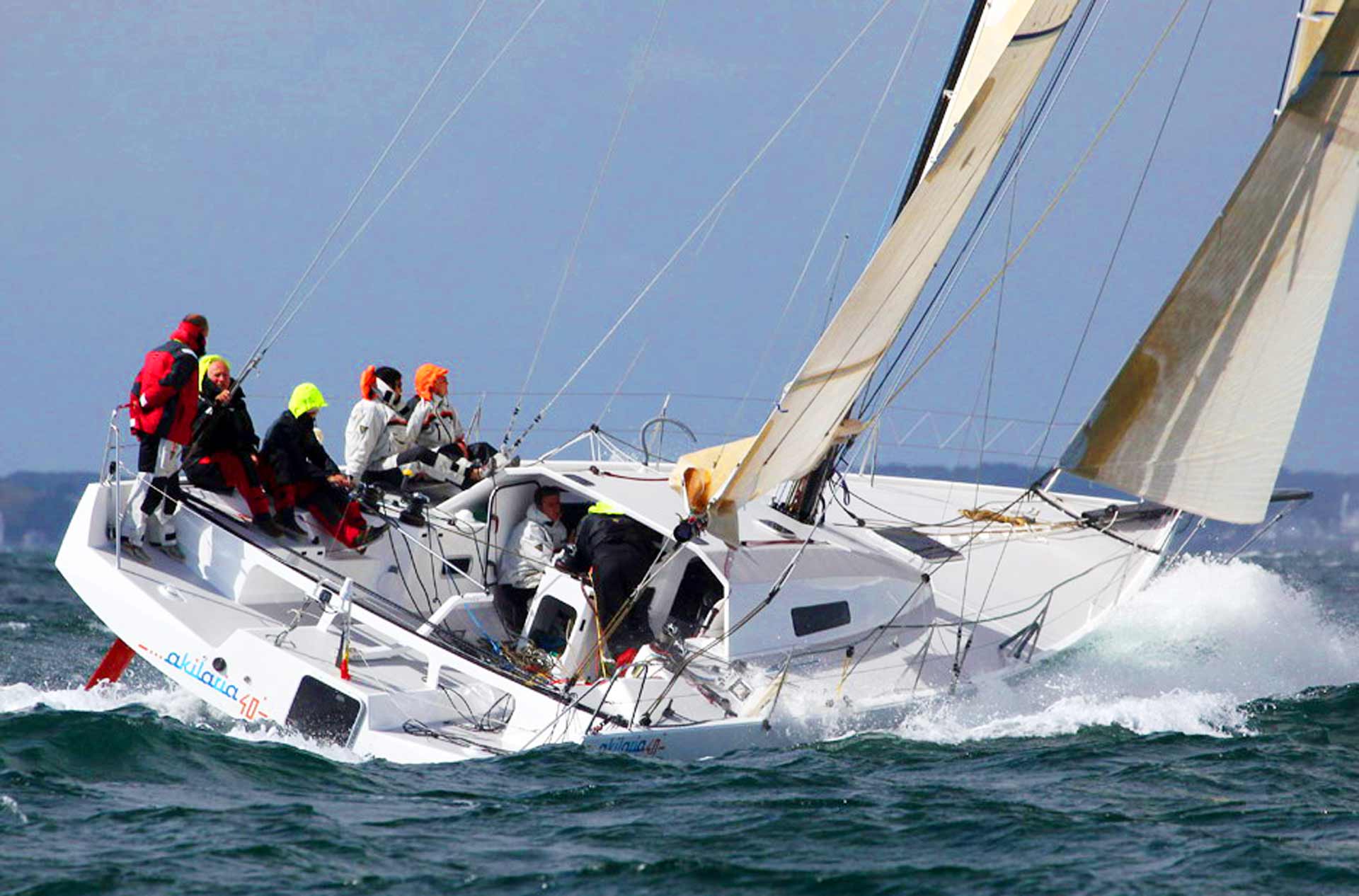
Competition is tight and there are a handful of yacht designers and brands offering their ships to both professional and Corinthian sailors. I talked to Merfyn Owen of Owen Clarke Design , Marc Lombard on behalf of the well-known Akilaria Class 40-boats and Britton Ward of renown Farr Yacht Design Bureau in the States on their Kiwi 40 FC-designs.
“We felt we could design a better boat than Pogo Structures.”
I first asked the three designers when and why their design bureaus entered the Class 40 competition.
Marc Lombard: “We first started to design Akilaria Class 40 boats in the year 2005. This was after the creation of the Class Box Rule and Pogo Structures did sell a lot of Pogo 40/1. We felt, we would be able to design and build a lighter boat with a better shape within that rule by keeping it simple to build on a production basis in the same way. First Akilaria hit the waters in 2006 and this RC1-version has been built 22 times in total. From 2009 we did 12 boats of the RC2 and starting in 2012 we are now having our fifth Akilaria RC3 launched. We are currently on a more “proto development”, which one could call the RC4.”
Merfyn Owen: “Our first Owen Clarke Class 40 was launched in 2005 as well. The last of our designs was launched in 2014 with boat number 17. The first of our fifth generation Class 40 racer design is build in South Africa and boat eighteen been ordered already.”
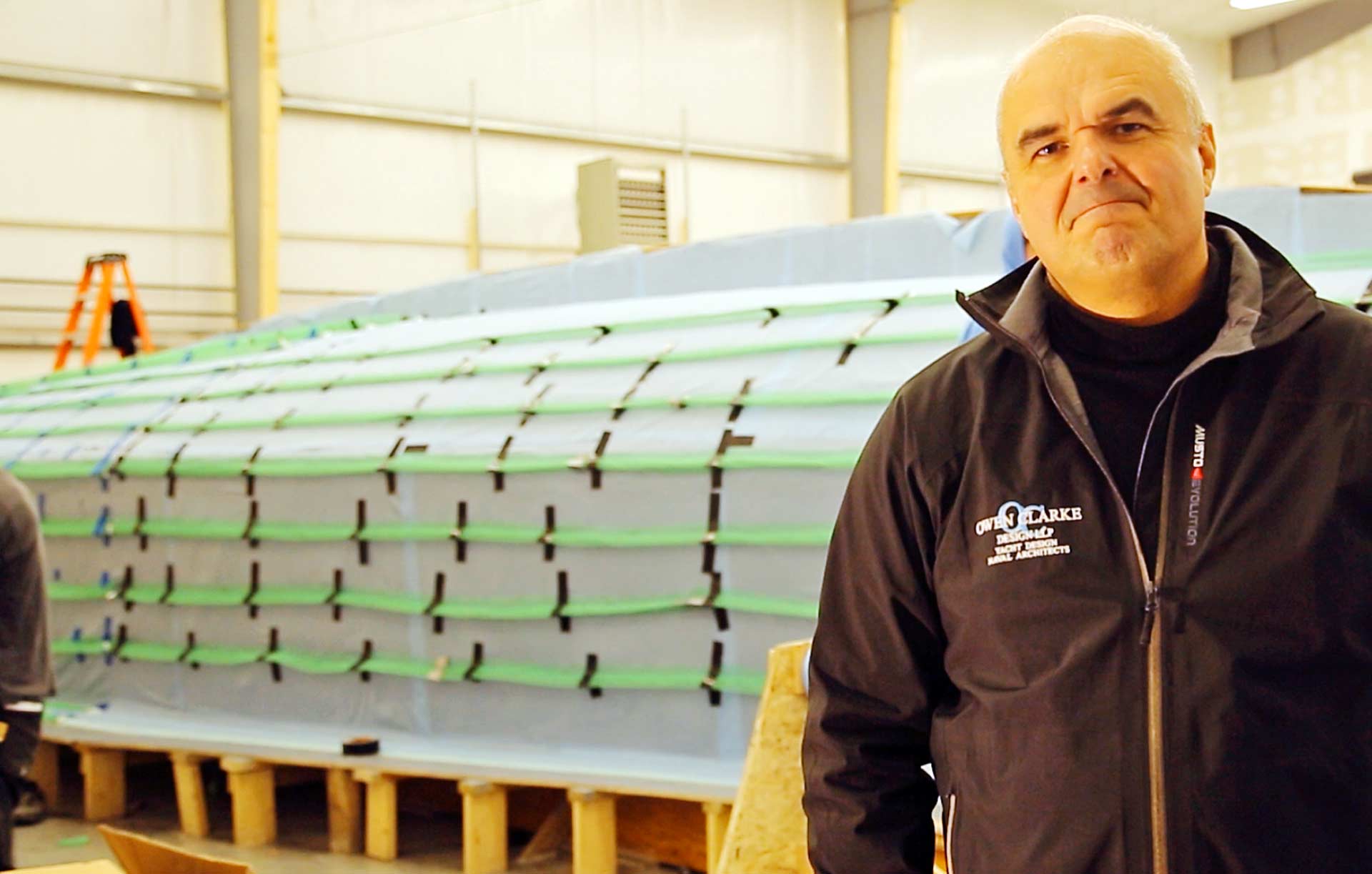
Britton Ward: “In 2009 the class was a rapidly expanding market area and one in which we felt our design capabilities and history were well suited. We began by developing a range of concepts and in October 2009 we contracted with Lapo Ancillotti´s BTBoats of New Zealand to develop a new limited production Class 40 design with the first boat finally launched in August 2010 built by Cookson Boats. The second boat followed in May 2011 and the third Kiwi 40FC was constructed by Hakes Marine in Wellington, launched in January 2012.”
“Corinthians racing alongside Professionals, that´s still one of the great things of the Class 40”
NO FRILLS SAILING.com: “Thanks again, Gentlemen, to spend some time answering my questions. Let´s begin by exploring how and why you three decided to have Class 40 designs produced. What´s the fuzz about the Class Rule and the boats all about? What´s so exciting from your point of view?”
Merfyn Owen/Owen Clarke Design: “This class has been the largest offshore racing class in the world for many years now partly because the rules are stable – with only well considered changes. From the beginning the rules were written to keep a cap on cost and although over the years the boats have become more highly developed and are no longer the racer-cruisers the class began with, limits on construction materials, sail inventory and appendages have kept these boats affordable. Personally I liked very much the fact that it allows Professionals as well as Corinthian sailors to race alongside each other in local and famous international regattas.”

Britton Ward/Kiwi 40 FC: “From its inception the Class 40 rule has sought to promote fast, high performance offshore-capable boats that are well-suited to short-hand-sailing. This is the result of a relatively strict and stable set of rule controls that try to limit build costs and produce equitable performance between different boats. From my point of view, the final ingredient is indeed a diverse calendar of events covering the spectrum between inshore crewed racing, coastal short distance sprints, classic offshore races and trans-atlantics. Many of the boats have completed circumnavigation and we might see another Global Ocean Race for the Class 40´s before too long.”
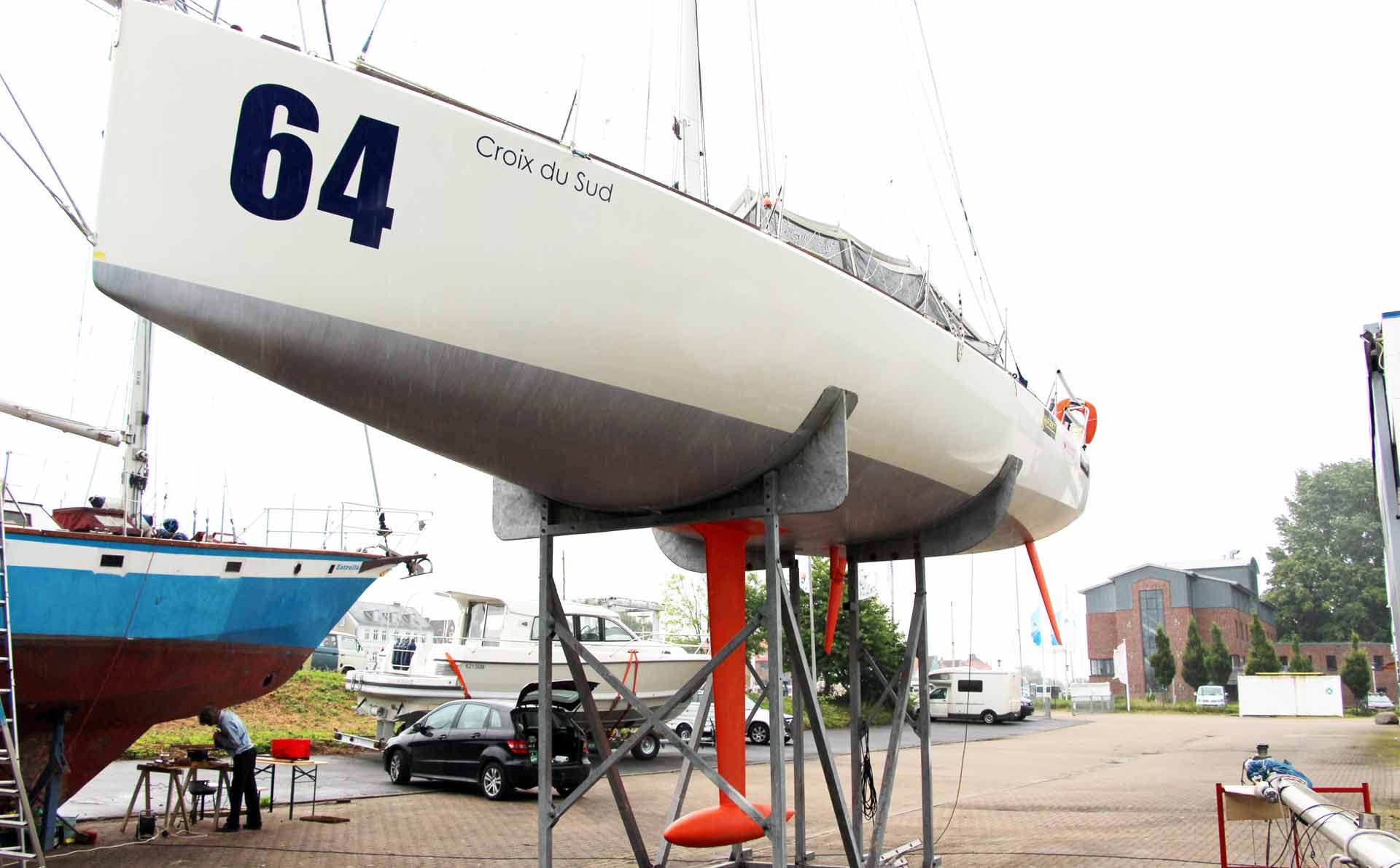
Marc Lombard/Akilaria: “I agree. The great thing with the rule is that by measuring available righting moment and limiting the sailplan area it was possible to design a “production boat” available to a broad number of demanding owners involved in ocean racing. This boat would last a while not being downgraded totally if ne prototypes where to come on the market. I would also agree that the success has come with all the very strong races, partially mixed with IMOCA 60 events attracting many sailors. More than 30 sailors get usually registered in many transat races just on Class 40´s! But on the other hand, what has been true for many years due to the success and more and more professionals entering the game there´s a necessity of constant innovation and progress. The Top 10 of them will always find tricks to have a better machine.”
The Big Name amongst Class 40 Yachts: Akilaria
NFS.com: “Marc, Akilaria is a well know name in Class 40 racing. As you have told us, there´s currently the RC3 third generation of the boat available. Tell us more about the main characteristics of Akilarias and the major developments from iteration to iteration. What´s so special about the RC3?”
Marc Lombard: “With the Akilaria RC1 we tried to build the boats at the minimum allowed weight and at the maximum righting moment. This happened to be “not so easy” with a production boat as you might imagine. But we finally designed a very good hull shape with plenty of available power upwind and very strong oceangoing capabilities in terms of seaworthiness all round. Later, on the RC2 we went for a more optimized construction: A more “regatta dedicated” boat with less freeboard, an optimized sheer line to the rule. On RC2 we also introduced a new optimized keel profile, the option of having lifting rudders in the design, which was also some gain in the total drag in certain sailing conditions. We also went for a more “racy” interior that was totally dedicated to racing, skipping comfort for cruising.”
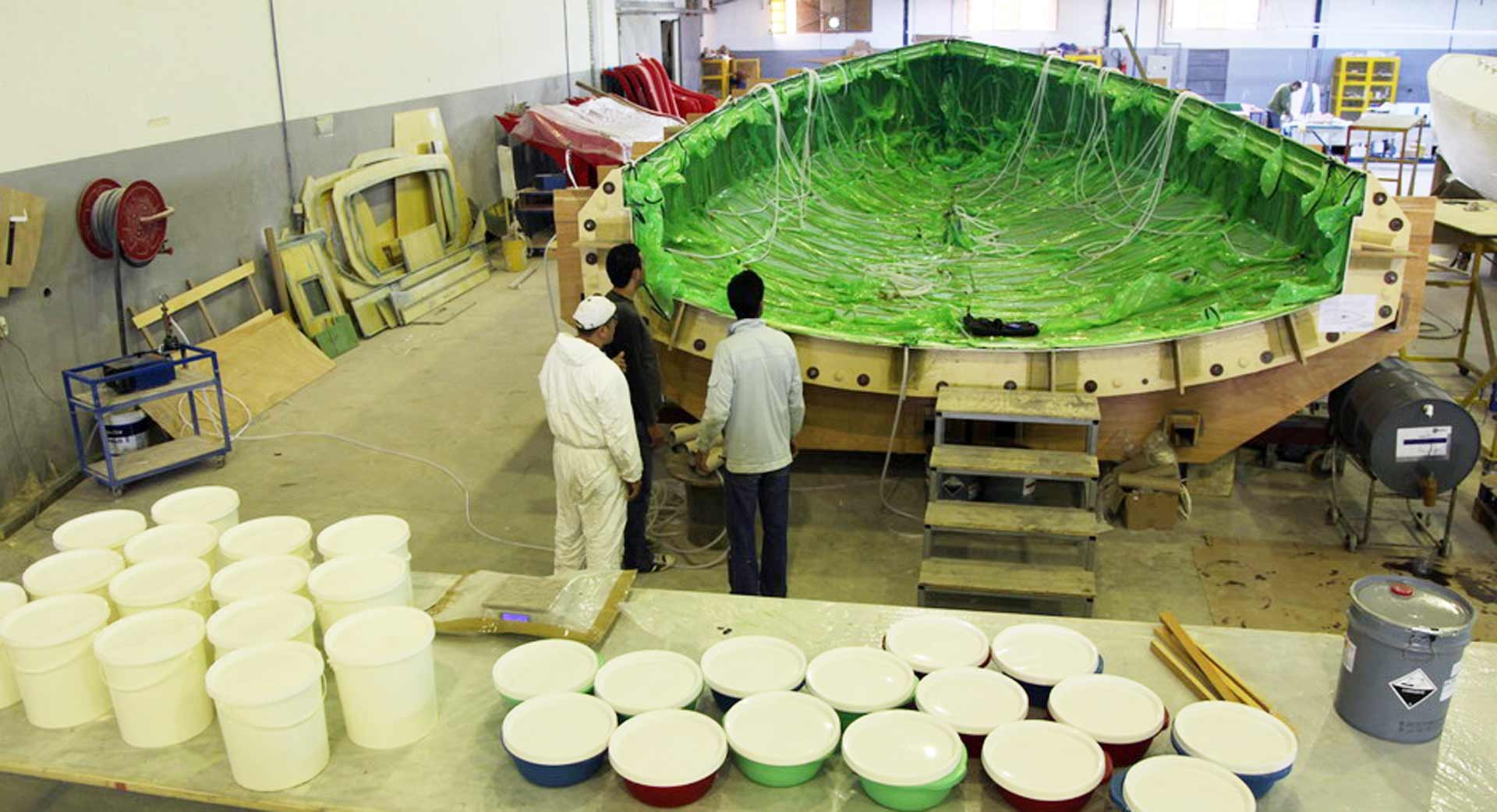
Marc Lombard: “With the RC3 third generation Akilaria we opted for a completely new design, a new hull with more volume of the forward underbody. That was improving the boat for upwind and reaching conditions, we added slightly more freeboard which in fact was again closer to RC1-design which was so seaworthy. Also, lifting rudders again was offered as an option, but overall the RC3 offers a much more comfortable deck plan, totally dedicated to single and double crew sailing with very good protection and ease of maneuvering. Last not least, a very optimized sailplan came through as a necessity, as the class became more professional. What´s special about RC3? It is very close to real prototype design, built as “one off”, with similar performances, but with a price that stays within the “production boats”-range. To make it clear, this is a boat that can be sailed with a budget of around 350.000 euros – compared to the latest “one off protos” where budget is closer to double of that price.”
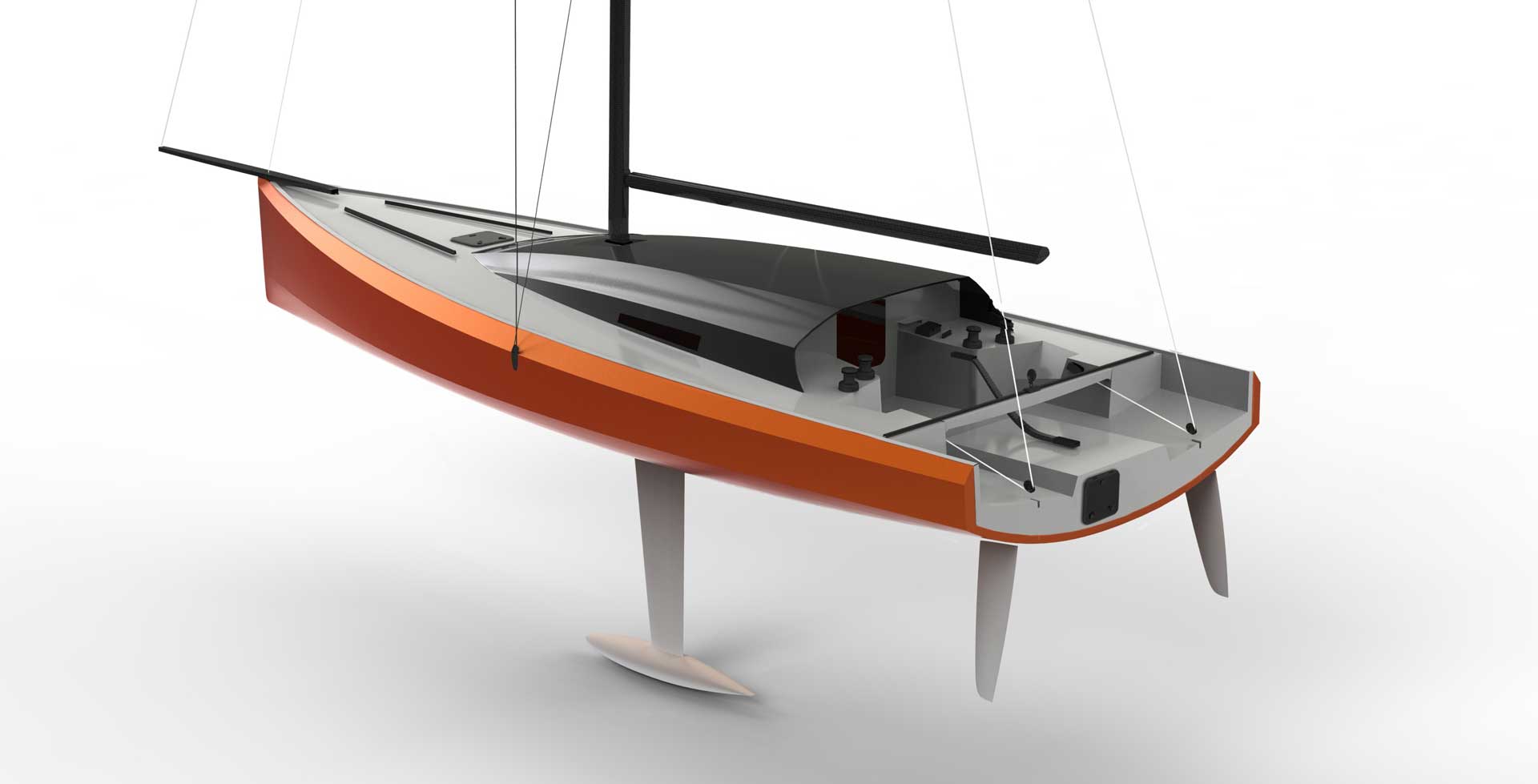
Marc Lombard: “Most exciting features of an Akilaria? RC1 and RC2 I would say are very, very strong seaworthy boats. The RC3 has a very good “all round performance” but with high points up and downwind. The very latest protos can be slightly faster on a reach, but overall the RC3 still performs very well. Strength of the construction is constantly improving and the boats are sailed increasingly harder. As a logical result few boats have encountered problems. For example, when the sailors keep all the speed upwind in very rough weather, facing huge waves. But as a general statement, boats are designed to withstand more loads that what is required in classification society and CE regulation. Much stronger than regular production cruisers.”
Close Competition and Highly Praised Boats: Owen Clarke Design Class 40
NFS.com: “Merfyn, your brand is well known in the class and elsewhere to being able to produce highly capable racing designs. I personally was able to roam about on two of your Class 40 boats and was impressed by the impression these yachts made in terms of rigidity and sturdiness of the design. What´s characterizing an Owen Clarke Class 40 boat?”
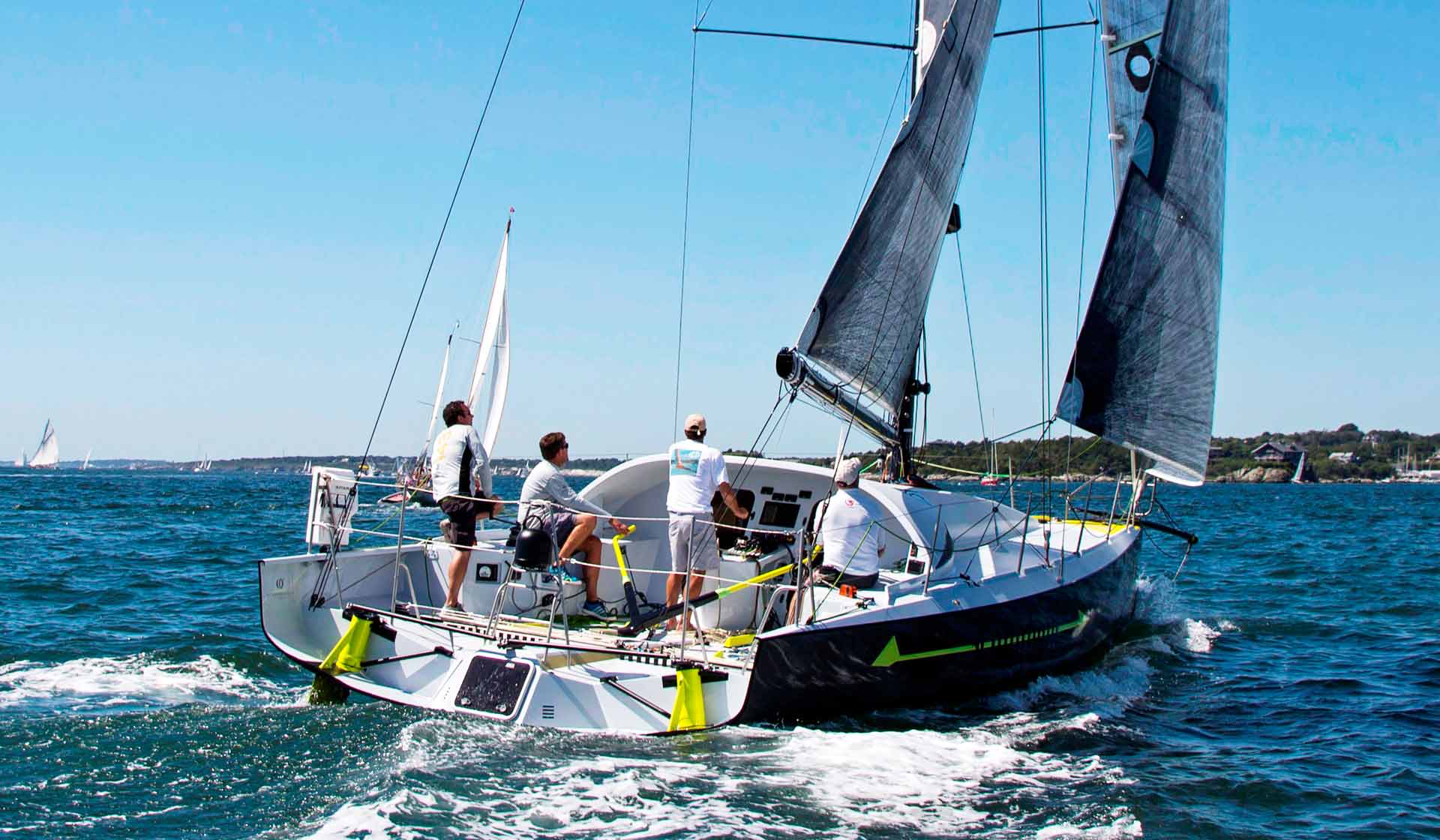
Merfyn Owen: “Race winning potential of course has to be a given for any race boat. Feedback has always been however that our boats are very well balanced, easily driven and very fast/easy to handle in big seas. Reliability has been a feature of the class, with relatively few serious incidents given the millions of miles the boats have sailed so far. A number of Owen Clarke boats have now completed well over 50.000 miles and in the ten years our boats have been racing we’ve had only one dismasting, which has been the most serious incident to date. So in short, I think our boats are known to be fast, reliable and with very good handling characteristics. Our boats have all been polyvalent designs. That means, they are not optimized for any one condition.”
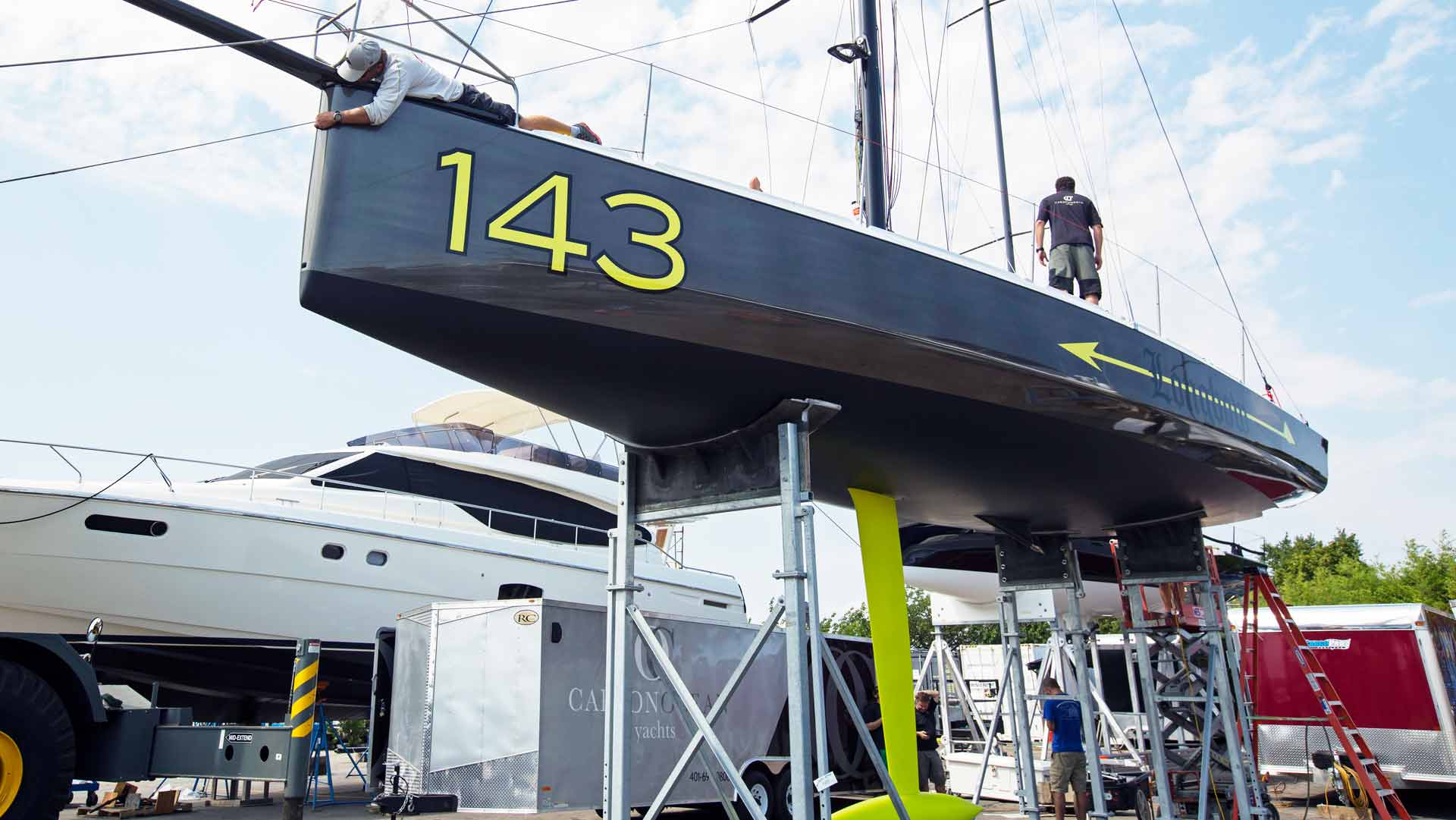
Merfyn Owen: “As we’ve never had a professional race team involved on our 40´s our boats have been designed for owners to win on a variety of courses, not just optimized for one transatlantic race every one or two years. Feedback from sailors have our boats as the best – or at least as quick as the quickest – in upwind and downwind VMG conditions. With the new crop of reaching orientated boats like the Mach 40 and Tyker 4 we’re addressing this to some extent with our new 5G design by winding up the dial in terms of reaching performance to some extent sacrificing some of the upwind and downwind advantage we’ve had in the past. The 5G remains however a polyvalent design in conception.”
NFS.com: “How do you improve the design?”
Merfyn Owen: “We are constantly learning from the sailors. Of course we do sail the boats a lot ourselves, so on the water experience is key. Also the rules change from time to time and new technology becomes available and is quickly introduced into the class. We also use weather databases and routing technology to optimize our boats for particular courses or events when this is applicable. For example, most recently Boat #143 LONGBOW was the first Class 40 to be optimized for races on the east coast of the United States.”
Smallest Fleet, Huge Brand: Farr Design´s Kiwi 40FC
NFS.com: “Though United States-based Farr Design Bureau is one of the world´s leading yacht design capacities, the Kiwi FC40 hasn´t entered the circus in large numbers yet. What are the Kiwi´s main characteristics and will make her easily distinguishable from other designs?”
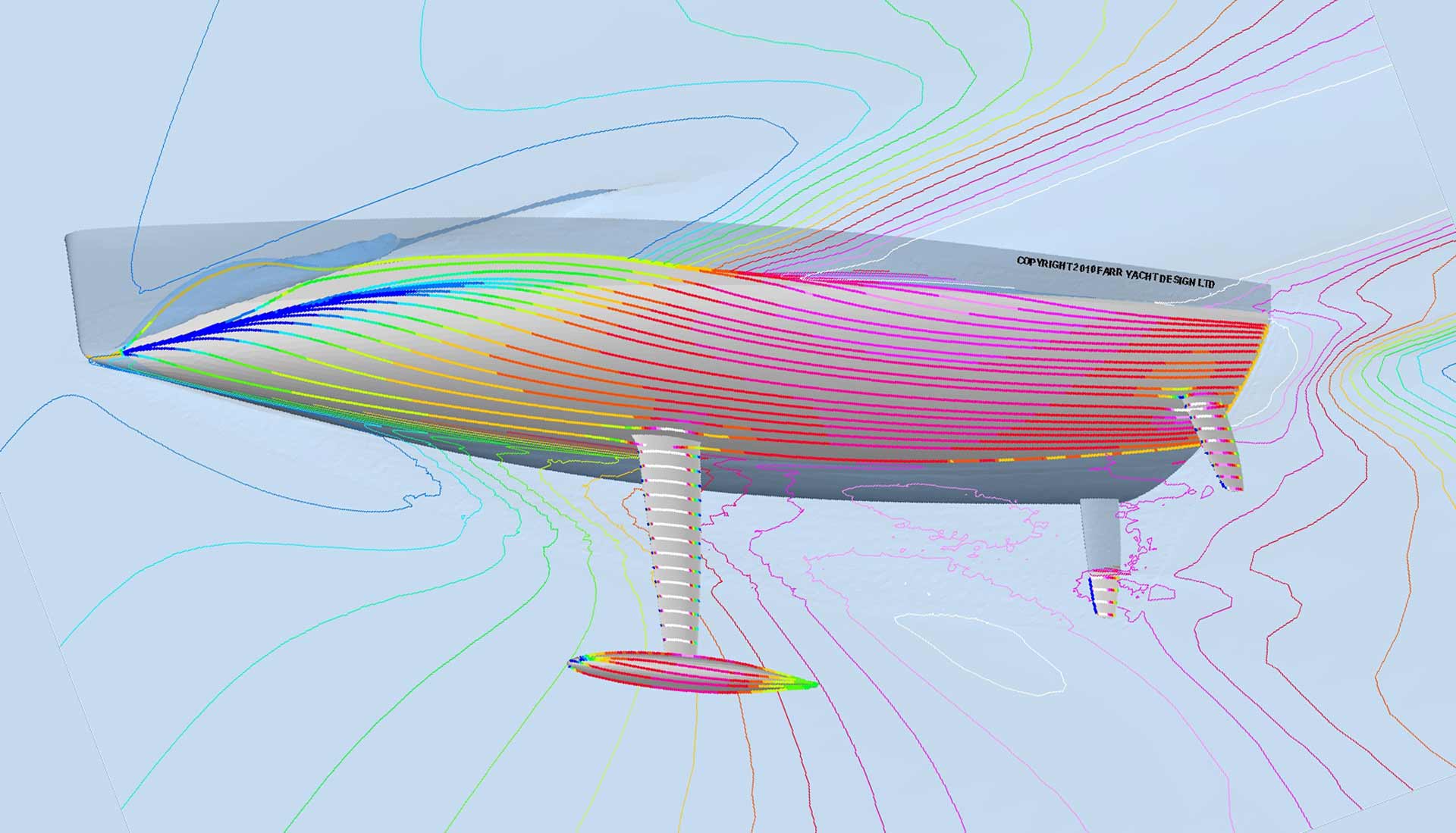
Britton Ward: “The Kiwi 40FC was one of the first Class 40’s to benefit from a comprehensive research program including extensive CFD simulation. The resulting hull shape has a number of signature features that are now seen in all the latest generation of other boats too. The boat features a pronounced, almost full length chine with very evenly radiused sections below to minimize wetted surface and provide a hull with a very even and consistent heel response in drag and helm load. The transom immersion levels and chine placement were carefully tuned relative to expected heel angles and water ballast weight additions to avoid excessive drag in light airs but maximize effective length when sailing at heel and speed. A lot of focus was placed in developing a hull that would achieve a dynamic bow up attitude when sailing at heel and speed so we see an LCB of the hull that is reasonably aft, and an aft placed keel and rig. In effort to maximize effective length forward and provide dynamic lift the Kiwi 40FC features a full stem and waterline ending – something now commonplace on new Class 40 and IMOCA 60 designs.”
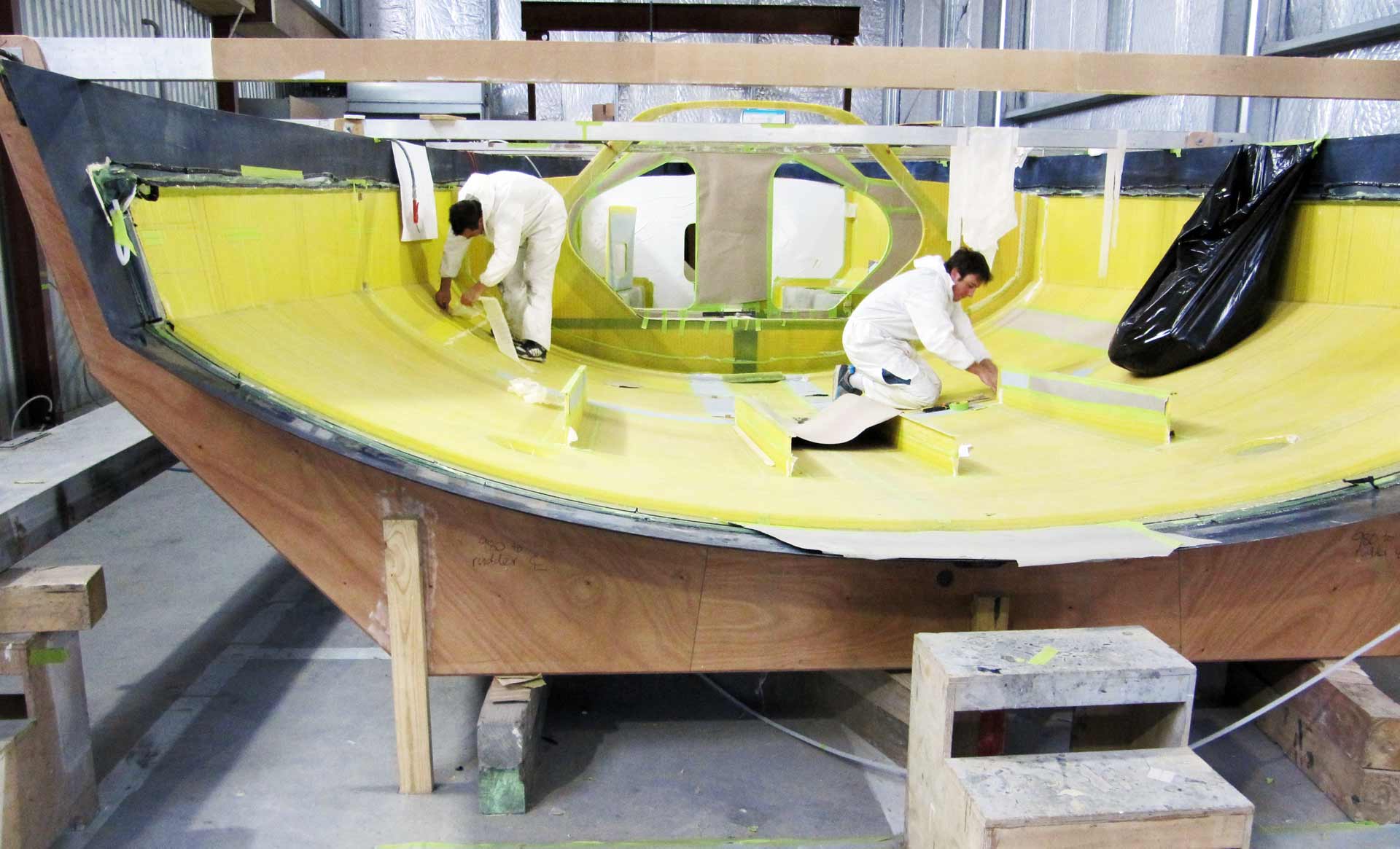
Britton Ward: “What our boats makes special is the fact, that unlike many of the latest designs that have been focused exclusively on distance races, the Kiwi 40FC was developed from its inception as a dual purpose boat – suitable for small crewed inshore racing and offshore singlehanded racing. This required some compromises and allowance for design options and keel changes to re-mode the boat for different purposes. To this day the Kiwi 40FC is regarded as having perhaps the best all-around performance on different points of sail. Kiwi 40FC´s have completed circumnavigations and competed in multiple Fastnet races, transat races, US Atlantic Cups and many other races where podium places have been achieved. To date we have had no reports of any significant damage.”
On the Owners of Class 40 Racing Yachts.
NFS.com: “Who is buying these boats?”
Marc Lombard: “Our customers are sailors who want super sensations of ocean racing without a need of huge sponsors – but on a highly competitive boat.”
Merfyn Owen: “In terms of owners we have a wide spread of nationalities, although we’ve never had a new boat built for a French client. Our new boat clients have been American, British, Scandinavian, German to name a few. Used boats have gone on to be purchased by South Africans, Australasian and – at last – French too.”
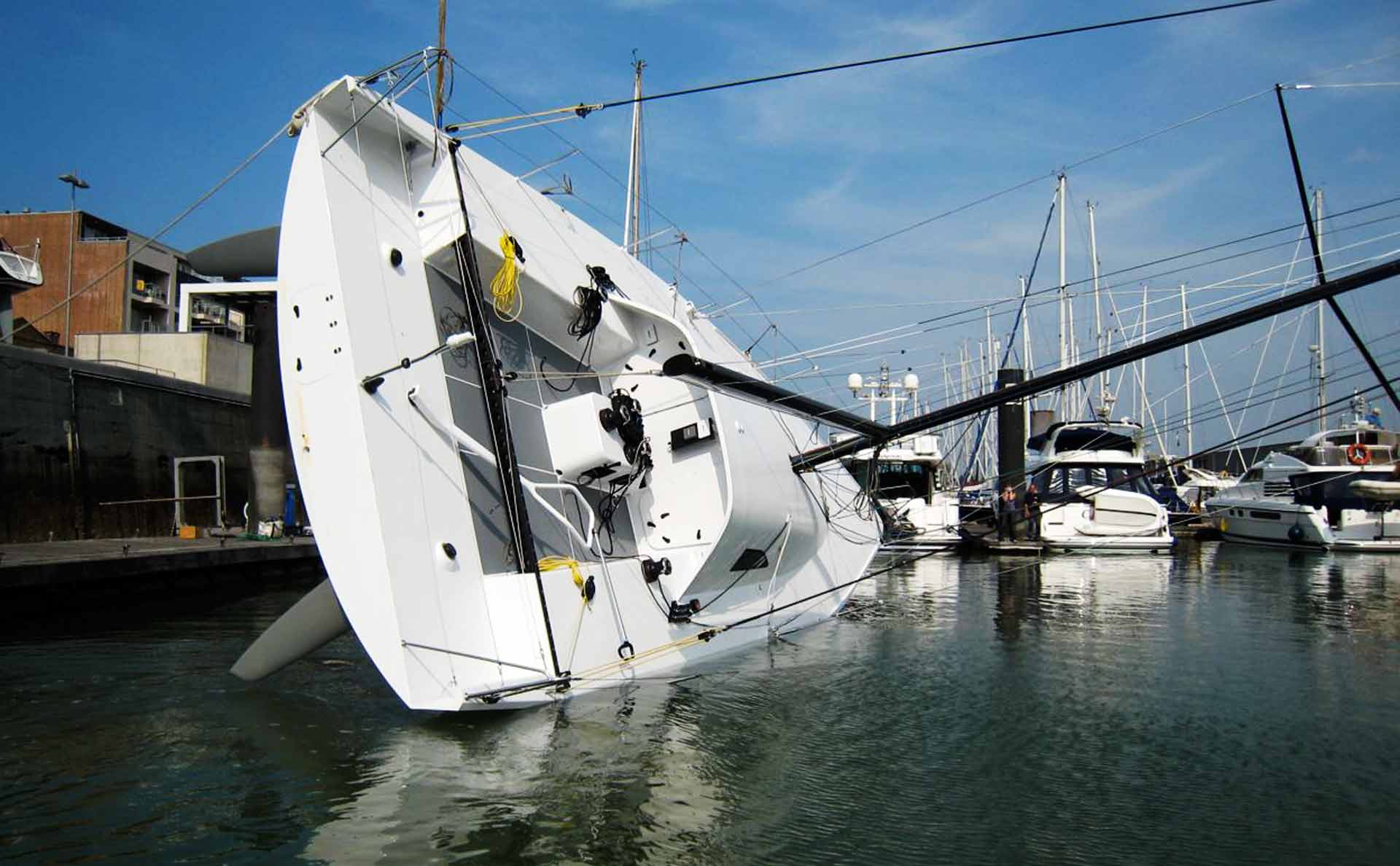
Britton Ward: “Kiwi 40 FC boats were originally bought by private owners with a broad range of experience levels and intended racing programs. All three of our boats are still being raced competitively”
On Improvement of Class 40 Racing Yachts & The Future of the Class
NFS.com: “Where would you say is most room for improvements for your respective boats and the Class 40 in general? Are there any follow-ups of your current designs hitting the waters anytime soon and what can be expected from the Class 40 in – let´s say – five years?”
Britton Ward: “Over the intervening years we have continued to monitor the performance and developments in the Class 40-fleet and feel there is still a lot of room for innovation and development. We have advanced concepts for a new generation of Class 40’s with further hull refinements and alternate deck and interior arrangements and are continuing discussions with potential partners with the hope of bringing a new generation of Farr Class 40s to the market place in the future. What about the future? Offshore yacht design is advancing rapidly with continued improvements in construction methodologies. The continued evolution of canting keels and the advent of dynamic stability foil systems has also advanced. How many of these technologies are permitted in the Class 40 is a question the Class will have to continually wrestle with. One of the reasons for the class’s success to-date has been its adherence to cost-restriction and its accessibility to both Corinthian and Professional sailors. If the class stays true to these principles then I expect the Class 40 typeform to evolve gradually with top performance being achieved by those teams that combine the best sailing with excellent design, refined sails and top quality construction.”
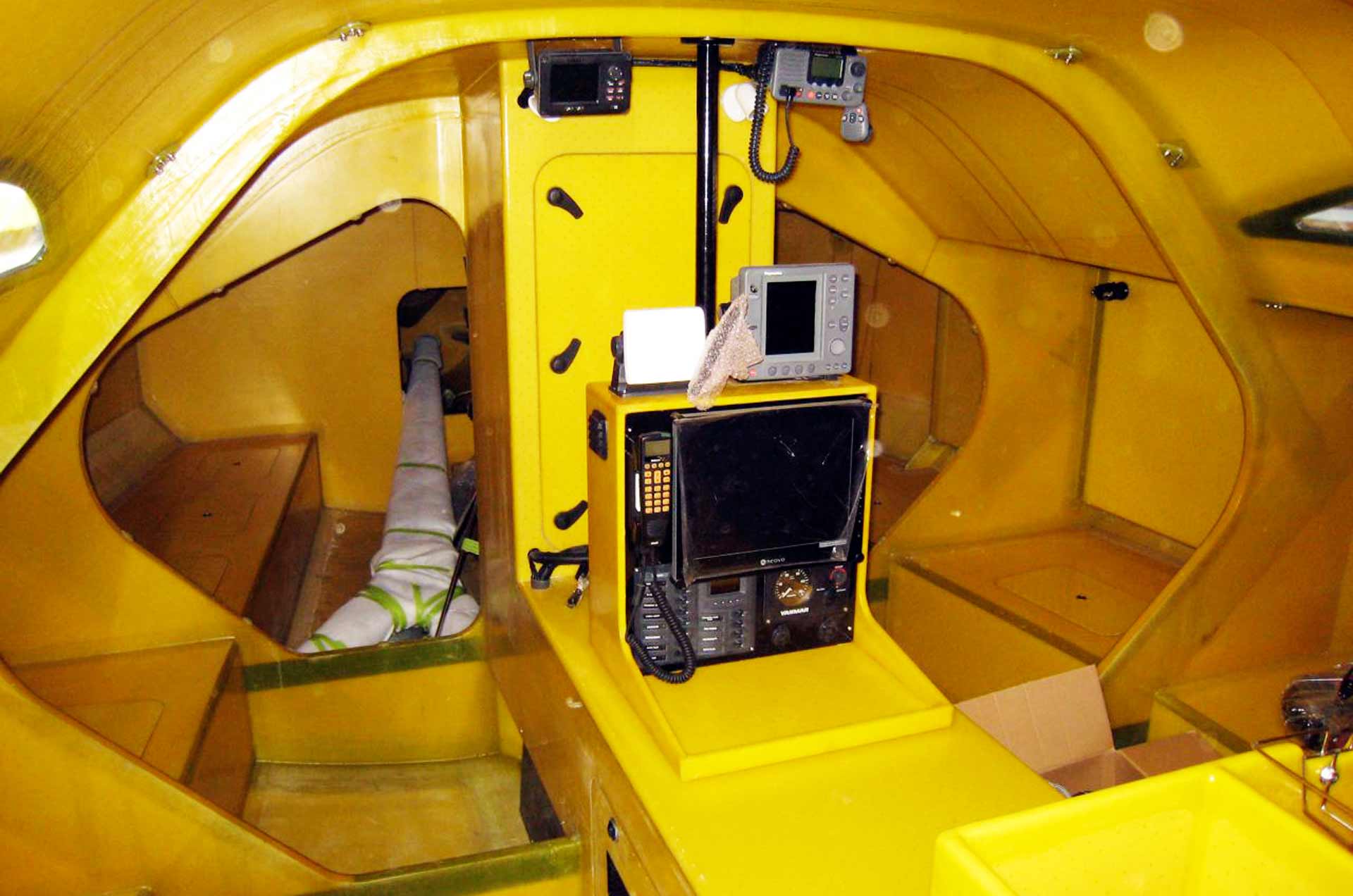
Merfyn Owen: “Providing the rule remains stable it will be a progressive change in the boats nothing radical. You may not even see a great physical difference and for sure some of the boats that exist now will still be on the podium in five years time.“
Marc Lombard: “We are working on an Akilaria RC4 right now, but from my point of view, evolution of the class leads to the fact that we will probably build less and less boats of the same model. This will make the boats become much more expensive, unless something is really done to limit the sailing budgets. Boats are improving all the time, but if you ask me, if nothing serious is done about limiting the budgets adapting the class rules, we could see less than ten boats on a future starting line. For sure, we are at a crucial timing about future development. As on Classe Mini 650 creating or limiting the entry to boats having a minimum of production could maybe a solution. That´s a difficult problem I would say. The class needs progress to be attractive, thus there´s a necessity of new designs, but in the same time we need “not to progress too fast” to stay within reasonable budgeting limits.”
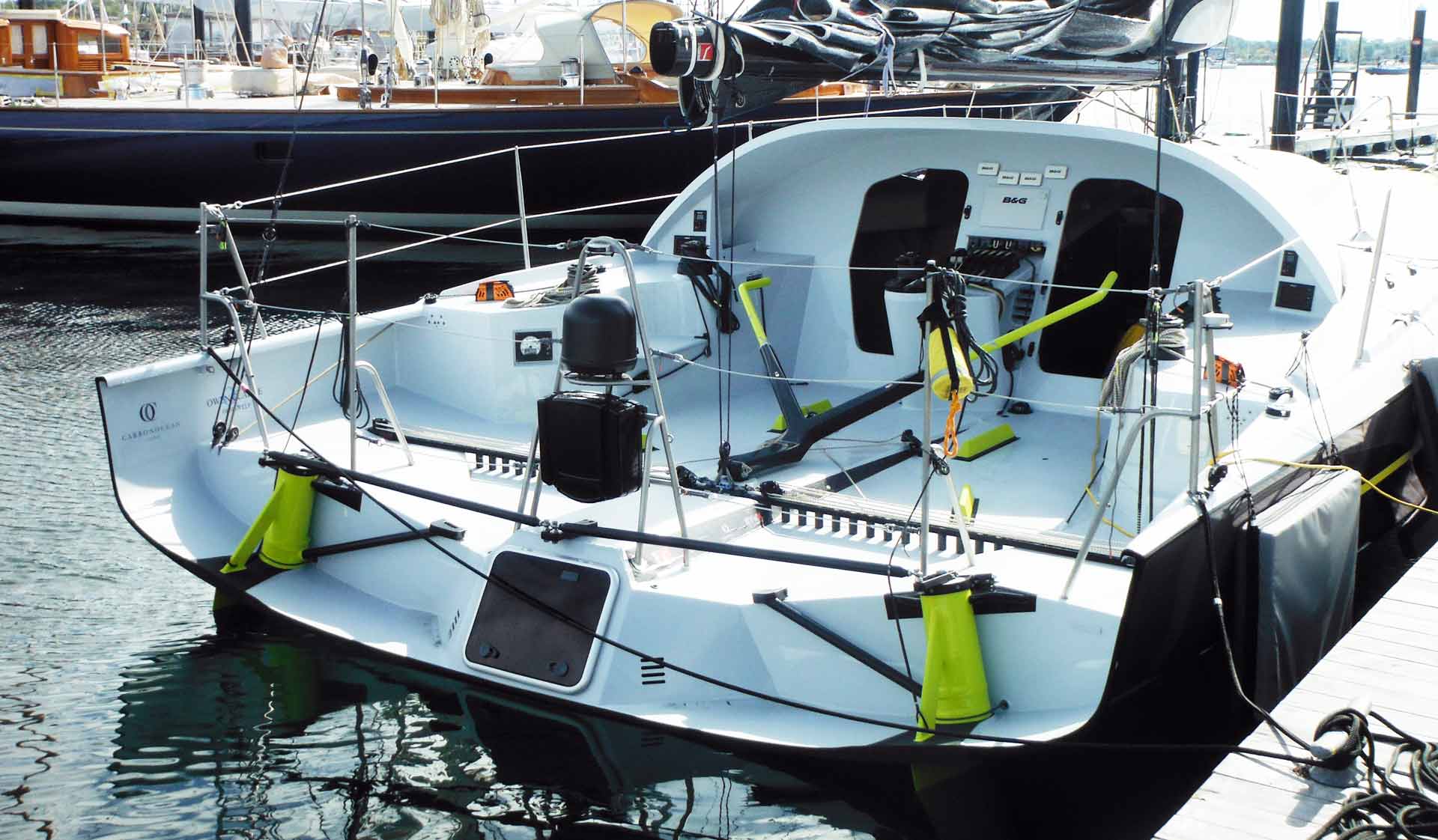
NFS.com: “Gentlemen, thank you very much for providing some answers on Class 40 and giving an intimate insight in your respective boats, constructions and points of view.”
This is how I´ ve experienced my very first sailing with a Class 40 racing yacht
Another interview with Yacht Designer Marc Lombard on his legendary Figaro 2 racing yacht
British young professional Lizzy Foreman on IMOCA 60-sailing
- Advertising
- Find the Magazine
- Good Jibes Podcast
- Boat In Dining
- Sailboat Charters
- Business News
- Working Waterfront
- Youth Sailing

- General Sailing
- Maritime History
- Sailing Records
- West Coast Sailing
The Cult of the Cal 40
The classic 1960s ocean racing legend.
The Cal 40 is a roughly 39-ft 4-in fiberglass production racing and cruising sailboat, of which about 155 were built in Costa Mesa, California, starting in 1963. The first mass-produced sailboat that was capable of sustained surfing on waves, the Cal 40 dominated ocean racing during the 1960s like no other design before or since. It’s the original longboard, a Southern California surfing machine that is capable of sustained 15-knot downwind speeds.
The Boat That Changed Everything
This breakthrough design ushered in dramatic changes in offshore racing, from the moment that Cal 40 #2, Conquistador, won the 1964 Southern Ocean Racing Conference, the marquee big boat series at the time. “Wooden ships and iron men” had been replaced by fiberglass boats and kids, as Cal 40s, sometimes crewed by teams of teenagers, crushed the competition in the Bermuda Race, the Transpac and many others.
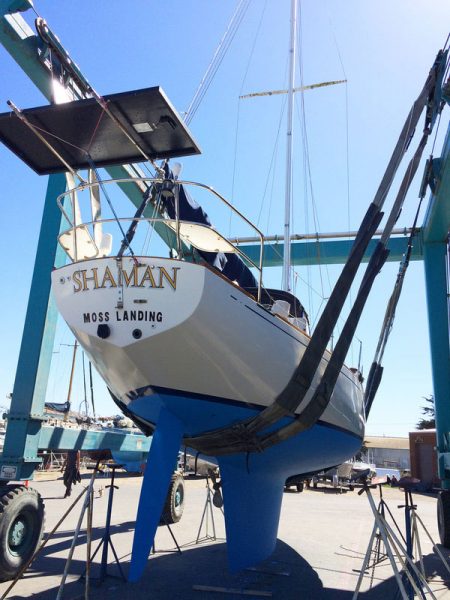
The Cal 40 was created as the combined work of three men. George Griffith, a successful racing sailor and member of the Los Angeles Yacht Club, reportedly drew the outline of a new kind of racing yacht hull on the back of a napkin, and showed it to his friend, naval architect C. William Lapworth. Griffith observed that sailing dinghies, like the International 14 class, were extremely maneuverable with their rudders hanging on their transoms, unlike the typical 40-footer of 1962, which was a full-keeled, heavy beast with the rudder swinging on the back of the keel.
Radical Ultralight Hull
Griffith’s sketch showed a flat-bottomed, radically ultralight hull, lithe and canoe-like in shape, but with a brutal, trapezoidal 6,000-pound wing stuck to the bottom. And behind this wing of a keel, way back, was a separate “spade” rudder. The design that Bill Lapworth created, at 15,000 pounds, was considered questionable, radically light and dangerously underbuilt by many of the yachting authorities, not to mention its being built out of the avant-garde new boatbuilding material of fiberglass, referred to as “extruded snot” by the esteemed L. Francis Herreshoff.
Griffith and Lapworth unsuccessfully shopped their design around to several California boatbuilders, experiencing polite rejection until they showed the plans to Jack Jensen, who agreed to build the boat on the condition that Griffith could guarantee orders for at least ten boats.
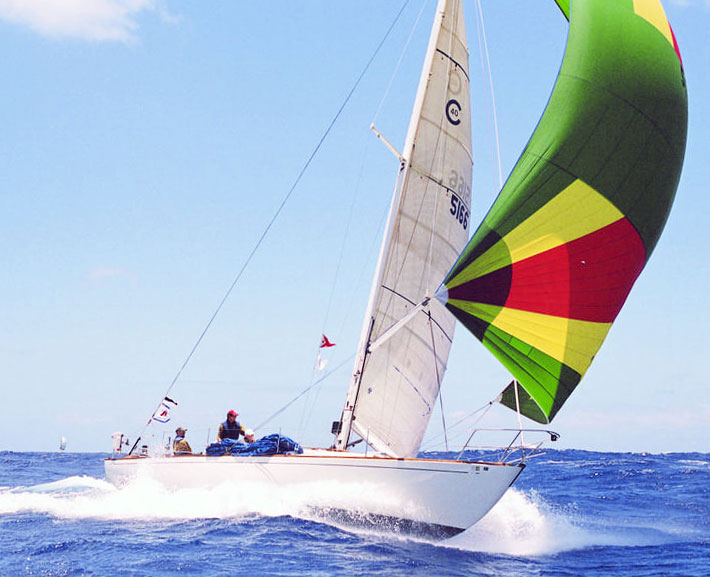
Fast forward to the present, and today the Cal 40 has attained true ‘cult’ status as a design that is sought after, restored and passed down through multiple generations of families. Try searching for Cal 40s that are for sale on Yachtworld and other sites, and you’ll likely come up empty. Folks spend multiple years and a quarter of a million dollars restoring Cal 40s and fitting them out with the latest sails, gear and electronics.
Standing the Test of Time
The Cal 40 has endured because it is not only a relatively quick downwind raceboat, but also a sweet-sailing light cruiser that, in the words of Cal 40 owner Stan Honey , “has no bad habits.” It steers beautifully under autopilot — plus it is rare to find a tiller-steered 40-ft sailboat, especially one with a light helm.
Cal 40s have twice achieved the record of being the biggest one-design fleet ever in the biennial Transpac Race, with 14 boats in 1966 and 2005. And the boat continues to rack up trophies in big ocean races too, as San Francisco Bay-based Cal 40s have continued to place well. Azure, Rodney Pimentel’s Encinal-based program, has been consistently near the top of the fleet in Bay, coastal and Pacific races. Green Buffalo and Red Head , from Richmond Yacht Club, have won at the top level. And no list of modern-era Cal 40 accomplishments is complete without mention of the husband/wife team of Stan Honey and Sally Lindsay Honey onboard Illusion .
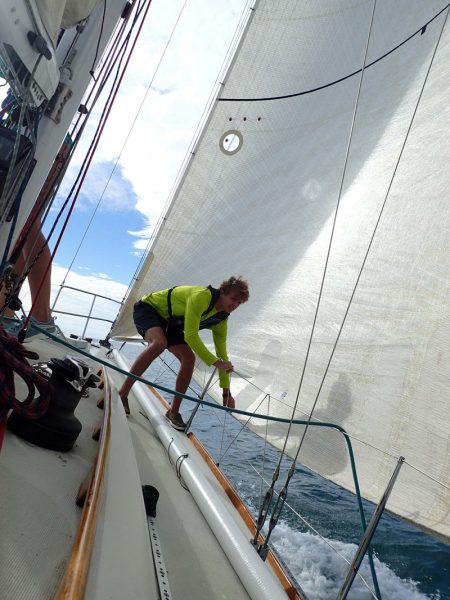
Many Cal 40 restorations are underway, or have happened recently. Fred Cook ’s complete down-to-bare-glass rebuild of Sequoia , documented in a great series of videos, is the most famous one. He’s worked with Cree Partridge, Jim Antrim, Kame Richards and other top East Bay pros to create a virtually brand-new boat.
A Swell Cal 40 Voyage
Perhaps the most well-known Cal 40 belongs to Liz Clark , who has been roaming the Pacific aboard Cal 40 #68, Swell . On what she calls, “a sailing surfer’s voyage of awakening,” Captain Clark has pushed the boundaries of solo cruising and sustainable living, all while attracting notice for her exciting adventures and sponsorship from the likes of Patagonia and North Sails. We have a copy of her excellent narrative, a book called Swell , onboard Shaman .

27 Comments
I own #120, ‘Mahalo’ and have since 2007. Yes, spent lots of $$ but she was in great shape after two Transpacs in ’03 and ’05 as ‘Flying Cloud’. She’s small by modern standards but just a blast to sail. I don’t race but I love to sail a boat well and a 40 is just a joy. She’s a great cruising boat now too.
First I would like to thank Latitude 38 for providing the magazine over the years but its especially great now when away from the water! I did the Transpac last year on Bob Hortons Cal 40 “Highlander” from Tiburon. What a great ride out there on the Pacific, I can vouch for the surfing which became competitive on the boat to see who who get the highest speed, I won by topping out at 18.9 knots on a wave at about 3-4 in the morning!, We could gauge how fast we were going by the noise of the water and how high water was spraying above the lifelines.
I like Cal 40s fine, but not the V drive most of them have.
I remember sailing with Jon Andron and his father Mort on their Cal 40 out of Santa Barbara in 1966-69. I was living aboard my boat GJOA in the SB harbor then. A fast boat ,but many “old school” sailors did not trust the FRP boats and I remember wondering if those boats would just fall apart while racing. How times changed.
We love the Cal40 here on Monterey Bay as well where we have a group of solo sailors we call “The Usual Suspects” who enjoy slugging it out on a regular basis. The Cal40 is extremely well suited for solo sailing/racing with it’s long tiller, accessible trim lines, and ability to easily steer with one’s foot while grinding in the jib after tacking. Just ask Steve Gann on his Cal40, Boomer, who (at 78 yrs young) still has enough tricks up his sleeve to teach us “youngsters” a thing or two!!!
Love Cal 40’s. Sailed in 81 and 85 on Montgomery Street in TransPac. We won it all in 85. The boat is like a freight train on rails downwind in a blow. I have many wonderful memories. I love it that Cal 40’s are still competitive 6 decades later.
How about running some of the old stories about the Cal-40. One such story that comes to mind was about Stan Honey doing the single-handed transpac in his Cal-40. Something about him beating the time of all previous Cal-40’s that had ever done the trip.
Splendid summary, thank you! It is extraordinarily impressive that almost 50 years later the Cal 40 remains an icon: a formidable racing boat that is also a sea-kindly and practical cruising boat without bad habits
It is, perhaps, worth remembering that the Cal 40 did not spring fully formed from George Griffith’s imagination onto that cocktail napkin. The same George Griffith had collaborated with the same Bill Lapworth on a prototype for the Cal 40 which was also built in Cost Mesa. This was the Lapworth 36. George Griffith took delivery of hull #1. It shared many of the same characteristics, and 71 boats were built to become a premiere one design fleet on the West Coast. It too, was radically ultralight by the standards of the day at less than 11,000 pounds. It shared the same rig and sail plan, and many of the same hull and under-body characteristics. The L-36 still had a keel hung rudder so it was the spade rudder that was the quantum leap on the Cal 40. Like the Cal 40, a well maintained Lapworth 36 remains a formidable racing boat as well as a sea-kindly and practical cruising boat without bad habits.
Full disclosure: my Father had #71 built. It is still in our family, and I expect my sons to be sailing her for many decades to come.
So additional articles must follow to describe the “cult” group of Cal 20s, 29s and other Lapworth models such as the Pearson 44, etc…. the man knew how to conceptualize racing vessels way beyond the design of the times.
What about the 40’s hot little sister the Cal 39 (pic in 2-11-18 Lec Lat, Ode to Wet Bottom Girls), or “The Other Woman” Knot A Clew.
Little? I believe the Cal 39 is both longer and heavier. Ask Saildata.com
Unfortunately, SailData.com indicates that only 107 CAL-40’s were built, but I apparently have hull #168 and I believe the above information is correct that 170 were built. Perhaps SailData.com transposed the 7 and the 0 in their count. I have come across a few other errors in their data, albeit they are a very useful source most of the time.
The Cal 39 is certainly a fine yacht, but it is fundamentally an offshore cruiser with good performance rather than a racing design that can also be cruised comfortably.
Guess I could tell a few “old” Cal 40 stories. In the ’67 Transpac (not ’66 as written in the article above), there were 14 Cal 40s on the start line. HOLIDAY TOO, #24, won class and overall, the youngest crew to do so, and a record that still stands despite MORNING LIGHT’s professional attempt at besting it. Before the 2007 Transpac, and movie of the same name, Robbie Haines of the MORNING LIGHT Disney project called me up and wanted all HOLIDAY TOO’s ’67 crew birthdates. I thought this a little strange without an explanation and refused his request. Another memory: Before the 2003 Transpac Stan Honey invited George Griffith and Bill Lapworth aboard ILLUSION for a little visit while tied up at the Griffiths’ dock in Alamitos Bay. As we sat around in the cockpit, a little contentiousness erupted. George told how Lapworth had designed the rig to be 18″ shorter, but George held out for the “tall” rig, saying Lapwoth’s “stump” would have “killed” the boat. Then the subject of who designed the Cal 40’s spade rudder, of which both Lapworth and Griffith claimed credit, arose, and was not resolved before our friendly little reunion broke up. Good times. -skip
Good to read about the history and accomplishments, past and present, of the wonderful Cal 40. My family and I have enjoyed owning Chaparral, hull number 135, for more than two decades and agree whole heartedly with the positive statements and comments about this tried and true class of great sailboats. In over 50 years on the water, Chaparral has proven the point of being an excellent racer and cruiser by performing well in off shore racing, including crewed and single handed Transpacs, as well as sailing around the world in 16 months, with her previous owner, Hans Vielhauer. Cal 40s may be old, but they certainly are good, and so much fun to sail.
Jim Quanci’s beautifully maintained Cal 40 ‘Green Buffalo’ has a few miles and many wins under her keel! I enjoyed following GB out of the gate in the 2012 SHTP, which Jim and GB won. And of course GB has also competed successfully in several Pac Cups, and many Bay races. She’s a Cal 40 worth watching!
Can anyone fill in the history of Sally and Stan’s Illusion? There was a black Cal 40 on the East Coast by that name in the early ’70s – owned by Commodore Montesano and raced by him and Bus Mosbacher. Maybe you’ve enjoyed a famous Montesano Cooler on the lawn at Larchmont. Yup – one and the same. I raced on the East Coast Illusion as a junior and have wondered if it’s the same boat. Thanks for any ideas.
Yes Sally and my Cal40 ILLUSION is the same boat as owned by Bus Mosbacher and Vince Monte-Sano. We sailed ILLUSION around to the East Coast to do the Bermuda Race in 2020 which was cancelled. Our fallback was two terrific summers cruising in Maine. We’ll be racing ILLUSION in the upcoming Newport Bermuda Race in June 2022. Interestingly ILLUSION’s first Bermuda Race was in 1966 raced by Mosbacher and Monte-Sano in which she came second to the Cal40 Thunderbird. The seven Cal40’s swept the results that year.
I am the keeper of hull 147 (I think) under the name EnFin, located on the Great Lakes. Although her specific history has gaps, it’s believed she’s lived in the fresh water of Lake Ontario for all of her life. In my opinion the Cal-40 has the best cockpit and is…. sparse down below. The cramped galley and curved floor can be difficult to get used to, but in a >15kn beam reach she makes it tough for boats far lighter and newer to keep up.
It is the same ILLUSION as owned by Mosbacher and Montesano. Hull number 57. She used to be black. There are half hulls of her in the NYYC Model Room and in Larchmont YC. She used to have sail number 1700, probably because Weatherly, the 12 that Mosbacher sailed in the Cup had sail number 17.
Thanks Stan, that connects the dots and brings back lots of happy memories. Glad to know you’re continuing the fun. Good luck in June. TK
I crewed on an L40 owned by Dr. Ed DuBois out of Marina del Rey back In 1968 and 1969. It was a lot of fun even tough we weren’t very competitive. I’d love to know if that boat is still around. I have no remembrance of the name or numbers of the boat. Ryan Anderson
Was the Dubois L40 also named Duboius? I was best friends with Larry Dubois back then.
I remember racing against Laughing Sally in Puerto Rico early 1970s. Dick Doran was the helmsman. It was the most dominant and professional boat during those days. In 1970 won Antigua.
I’m the current care taker of 1970 built Cal-40 Jubilee. Almost done with a full refit here on the Gulfcoast near the Florida Alabama line. I was really enjoying the ride until starting on the long journey of redoing outside and in. Everything except the engine and transmission have been changed out. About to rig and step the mast soon. Hope to have her ready to go fall of ‘23.
Take good care! I learned to sail on Jubalee in the 80’s in Houston. She’s special. I’ve heard a photo of her was in the Charleston yacht club for a while.
There used to be a small plaque or something on the bulk head commentating a SORC record she set.
I have (should I say am trustee of? lol) a Cal-40 that is apparently Hull# 168, formerly named ‘Callalou’ or ‘Callaloo’, and now named ‘Innisfree’ likely after the Irish poet Yeats’ poem of the same name. I’ll keep her name as is. She needs some deferred maintenance caught up and rehabilitation. The teak is in need of cleaning and oiling and the cockpit backboards will most likely need replacing. The power plant is not original. She has a Westerbeke W-33 now, which was derived from a Perkins block; some parts are interchangeable. The engine starts and runs fine now with a new waterpump. I am eager to get her sailing again as I think she has awesome lines, not to mention all of the Cal-40 history and accolades I am learning more about. Any help with photographs of original cabin layouts, maintenance issues to look for, etc., will be greatly appreciated. Thank you in advance.
Leave a Comment Cancel Reply
Notify me via e-mail if anyone answers my comment.
Messages to the Neighbors Hoisting the Signal Flags "When you live in Sacramento like I do and miss sailing on San Francisco Bay with your buddies (like I do), what else was I supposed to do? I dug deep into my gear box…"
Sponsored Post Westwind Boat Detailing Washing, waxing, varnishing. Serving the entire Bay Area for more than 30 years. “I have never seen the teak look so good."
Commentary Following the Rules, Until You Don’t Today, New Zealand went from its “Level 4” lockdown — the highest, most strict tier — down to “Level 3.” More businesses will be allowed to open, and more activities will be allowed.
Subscribe to the Magazine Take a Break from Junk Mail with Latitude 38 “You are awesome and remind me how much MORE I like/crave/need the print version. I hope you don’t suspend it.”

Published on September 14th, 2014 | by Editor
Made in USA: Owen Clarke Design Class40
Published on September 14th, 2014 by Editor -->
Carbon Ocean Yachts, Bristol, Rhode Island, USA have started to build a new Owen Clarke Design Class40 for an American owner. The design team includes Clay Oliver, engineering by PURE and weather modelling data from Chris Bedford.
“It is exciting to become part of a growing class in the US and we hope to stimulate and encourage others to do so,” commented Matt Baldwin who is representing the owner for the Class40 project. “Carbon Ocean Yachts have an excellent track record, delivering the highest quality on time and budget, and Rhode Island is the best place in the US for a high tech composite project.”
“The team is really excited about the project,” confirmed Carbon Ocean Yachts COY MD, Britt Colombo. “The Class40 scene in the USA is one of the most vibrant, developing classes and we are working with a very experienced team of highly regarded designers and engineers. We have the means and capability of producing an outstanding yacht and the team at Carbon Ocean Yachts is determined to deliver a race winner for the owner and spark interest for more Class40s to be built using the same mold.”
UK designers, OCD and US based America’s Cup designer, Clay Oliver have been working together on a hull development program spanning many months and have eventually arrived at a max. beam design with lines that are unique in the class. Sail wardrobe, ballast tank positions and appendages have all been reviewed on the back of the weather and course data developed during the hull design but the finished design is still work in progress for the client, project and design team.

COY is building the Class 40 in Bristol, Rhode Island and is close to completing the male plug, which will produce the carbon female mould. The hull shell construction drawings have been delivered by PURE, the engineers responsible for Team New Zealand’s last and future AC 72 America’s Cup challenger.
As part of the weather profiling for the yacht OCD used the same software utilised in their larger IMOCA Open 60’s to run computer simulations of design candidates on courses such as the Atlantic Cup and Bermuda Races. Using high resolution weather data provided by Massachusetts based weather forecaster Chris Bedford. Comparing their new designs against existing Class40s whose performance was used as a benchmark and modelling races as far back as 2000. The results of the simulations showed the new design was faster than the current generation of yachts, in the vast majority of conditions.
Lead designer, Merfyn Owen puts his expectations for the latest Class 40 in North America in perspective. “We expect some real innovation and quality in the build from Carbon Ocean Yachts and I’m sure it will be the quickest boat on ‘paper’. However, history tells us that those with current boats need not despair! Wise sailors know and my experience of racing in the class in the US, for the last five years, tells me that especially in short-handed sailing, once the hull gets wet; experience, local knowledge, preparation and good old time on the water are all great levellers.
We’ve been designing racing boats for US owners for more than ten years but it’s really exciting for me and important for Owen Clarke Design to be working with Carbon Ocean Yachts to create this new racing yacht and for it to be built in the United States. It’s great news for Class40 in the US, that an owner has the confidence in the future of the US Class to invest in a new boat and the tooling to produce it.”
For more information visit: www.carbonoceanyachts.com
Report by Louay Habib. Photo credit: Carbon Ocean Yachts/ Billy Black.

Tags: Carbon Ocean Yachts , Chris Bedford , Class40 , Clay Oliver , Owen Clarke Design
Related Posts
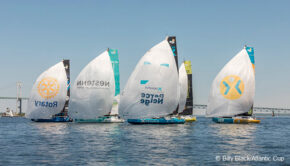
Leg 2 complete for Atlantic Cup →
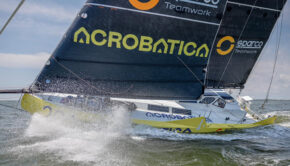
Leg 1 complete for Atlantic Cup →
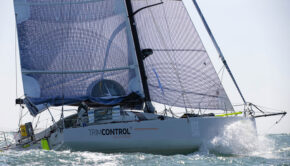
Countdown to 2024 Atlantic Cup →
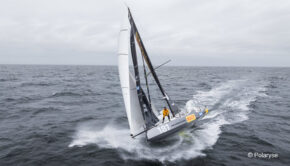
Italy wins Transat CIC Class 40 title →
© 2024 Scuttlebutt Sailing News. Inbox Communications, Inc. All Rights Reserved. made by VSSL Agency .
- Privacy Statement
- Advertise With Us
Get Your Sailing News Fix!
Your download by email.
- Your Name...
- Your Email... *
- Name This field is for validation purposes and should be left unchanged.

- New Sailboats
- Sailboats 21-30ft
- Sailboats 31-35ft
- Sailboats 36-40ft
- Sailboats Over 40ft
- Sailboats Under 21feet
- used_sailboats
- Apps and Computer Programs
- Communications
- Fishfinders
- Handheld Electronics
- Plotters MFDS Rradar
- Wind, Speed & Depth Instruments
- Anchoring Mooring
- Running Rigging
- Sails Canvas
- Standing Rigging
- Diesel Engines
- Off Grid Energy
- Cleaning Waxing
- DIY Projects
- Repair, Tools & Materials
- Spare Parts
- Tools & Gadgets
- Cabin Comfort
- Ventilation
- Footwear Apparel
- Foul Weather Gear
- Mailport & PS Advisor
- Inside Practical Sailor Blog
- Activate My Web Access
- Reset Password
- Customer Service

- Free Newsletter

Ericson 41 Used Boat Review

Mason 33 Used Boat Review

Beneteau 311, Catalina 310 and Hunter 326 Used Boat Comparison

Maine Cat 41 Used Boat Review

Tips From A First “Sail” on the ICW

Tillerpilot Tips and Safety Cautions

Best Crimpers and Strippers for Fixing Marine Electrical Connectors

Thinking Through a Solar Power Installation

Getting the Most Out of Older Sails

How (Not) to Tie Your Boat to a Dock

Stopping Mainsheet Twist

Working with High-Tech Ropes

Fuel Lift Pump: Easy DIY Diesel Fuel System Diagnostic and Repair

Ensuring Safe Shorepower

Sinking? Check Your Stuffing Box

The Rain Catcher’s Guide

Boat Repairs for the Technically Illiterate

Boat Maintenance for the Technically Illiterate: Part 1

Whats the Best Way to Restore Clear Plastic Windows?

Mastering Precision Drilling: How to Use Drill Guides

Giving Bugs the Big Goodbye

Galley Gadgets for the Cruising Sailor

Those Extras you Don’t Need But Love to Have

UV Clothing: Is It Worth the Hype?

Preparing Yourself for Solo Sailing

How to Select Crew for a Passage or Delivery

Preparing A Boat to Sail Solo

On Watch: This 60-Year-Old Hinckley Pilot 35 is Also a Working…

On Watch: America’s Cup

On Watch: All Eyes on Europe Sail Racing

Dear Readers

Chafe Protection for Dock Lines
- Sailboat Reviews
Though now an old and dated design, the Cal 40 was a hot boat when new, and she carries that legacy.
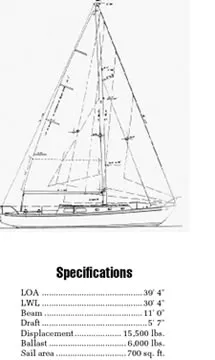
Thunderbird, a Cal 40 owned by IBM president T. Vincent Learson, took first in fleet over 167 boats in the 1966 Bermuda Race. Because this was the first computer-scored Bermuda Race, Learson got a lot of gaff about the IBM computer that had declared him the winner—and about beating out his boss. Thomas J. Watson, IBM’s chairman of the board, sailed his 58′ cutter, Palawan, second across the line, but ended with second in class, 24th in fleet, on corrected time.
In fact, the computer scoring system was not especially kind to Learson. Both he and Watson would have fared considerably better under the old system that calculated scores from the NAYRU time allowance tables. Thunderbird’s victory was a legitimate win, another in a stunning series by Cal 40s that was establishing the boat as a revolutionary design. The first Cal 40 was built for George Griffith in 1963. That winter, hull #2, Conquistador, took overall honors in the 1964 Southern Ocean Racing Circuit (SORC). The Transpac races of 1965, ’66, and ’67 all went to Cal 40s. Ted Turner’s Cal 40, Vamp X, took first place in the 1966 SORC. In the ’66 Bermuda Race, five of Thunderbird’s sisterships finished with her in the top 20 in fleet, taking five of the first 15, four of the first nine places. And so on. In their first few years on the water, Cal 40s chalked up an astonishing record.
The 40 was the fifth in a line of Cal designs that C. William Lapworth did for Jensen Marine of Costa Mesa, California. Lapworth had already designed a series of moderately successful racing boats, the L classes, including an L-24, L-36, L-40 and L-50, when he teamed up with Jack Jensen. The Cal designs were built on concepts he had tried in his Lclass boats. The first Cal was the 24, Jensen’s first boat, launched in 1959. The Lapworth-Jensen team then produced a 20, 30, and 28 before getting to the Cal 40, which proved to be a successful distillation of Lapworth’s thinking up to that time.
Aspects of the boat that departed from the conventional wisdom were her light displacement, long waterline, flat bilges to encourage surfing, fin keel and spade rudder. The masthead rig is stayed by shrouds secured to chainplates set inboard of the toerail, a then unusual innovation that allows a reduced sheeting angle. The success of the design helped legitimize fiberglass as a hull material, establish Jensen Marine as a significant builder of fiberglass boats, and propel Lapworth to the forefront of yacht design.
Three decades have passed since Lapworth drew the Cal 40. In that time, using computers to score races has become commonplace—boat measurers and designers would be paralyzed without them. The CCA Rule, the NAYRU tables and the Portsmouth Yardstick have been replaced by IMS, IOR, and PHRF, with the effects of their parameters expressed in the shape, size and weight of new boats. New building materials and techniques have changed the meaning of terms such as “light displacement,” “long waterline,” “fin keel,” and “fast sailboat.” Today the Cal 40 is a dated design, having been surpassed in her revolutionary features by her descendents. She remains among the esteemed elite of racing yachts, but she is not especially light, long on the waterline, or fast compared to current designs.
The Cal’s builder was transformed by time, as well. Jensen Marine was bought by Bangor Punta Marine, and the Cal production line was moved to Florida about the time that the Cal 40 went out of production in 1972. For the next decade, the company’s name and address shifted between combinations of Cal, Bangor Punta and Jensen in California, New Jersey and finally Massachusetts, where it joined O’Day under Bangor Punta’s umbrella in the early 1980s. After 1984 the company was called Lear Siegler Marine, Starcraft Sailboat Products, and finally emerged as Cal, a Division of the O’Day Corporation, in Fall River, Mass. Cal and O’Day ceased production in April, 1989.
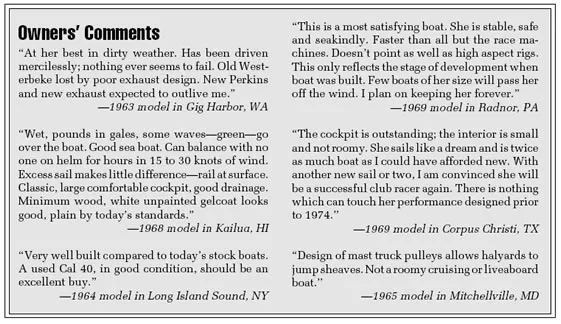
Construction The construction of the Cal 40 is typical of Jensen Marine boats of the 1960s. The hull is solid hand laid fiberglass with wooden bulkheads and interior structures. Strips of fiberglass cloth and resin secure the wooden structures to the hull, but this tabbing is rather lightweight and has been reinforced in some Cal 40s where it has failed. If it has not been reinforced, it probably needs it.
Because saving weight was a priority in building the Cal 40, the reinforcement provided by the bulkheads and furniture is critical to hull stiffness. Failure of the bonding can be a significant structural concern.
The hull-to-deck joint is an inward-turning hull flange, upon which the deck molding is bonded, then through-bolted and capped with a throughbolted teak toerail. This is a strong type of joint, but there is some complaint of minor leaking along it in a few boats. The leaks are most likely one result of the relatively light construction of the hull skin, which has a tendency to “oilcan” in heavy weather, creating stresses at the joint.
The deck, also a solid fiberglass layup, has reinforcement designed into it during layup, so no interior metal backing plates are provided under winches, cleats, and other hardware. PS generally recommends backing plates behind high-stress hardware as a matter of course. We found little indication of trouble with leaking or working of most of the fittings, but one owner said that his lifeline stanchion bases had to be reinforced. This would be an area to inspect carefully.
Colors and non-skid surfaces are molded in, but due to the age of any Cal 40, the finish will look tired unless it has been renewed. A good Awlgrip job will do it wonders, and is probably warranted for this boat unless it is in general disrepair.
The deck and cockpit of the Cal 40 we inspected have numerous cracks in the gelcoat in corners and other stress areas. Check these areas closely—they are unsightly, but in most cases are not a structural concern.
Ballast is an internal lead casting dropped into the keel before the insides were assembled. If there is evidence that the boat has suffered a hard grounding, invesitgate the ballast cavity to see that it was properly repaired. It should not have a hollow sound when rapped, and there should be no cracks, weeping, or other evidence of moisture inside. Due to the construction sequence, major repairs could be awkward.
Wiring was also installed prior to the interior, which makes it quite inaccessible in some areas. What may be of more concern is that it is low enough in the boat to get wet if the last watch forgot to pump the bilges and the boat heels over to her work. That’s what happened to one owner, who lost all the electricity on the boat when approaching Nova Scotia’s Bras d’Or Lakes after an all night sail. Fortunately, dawn arrived in time to avert a navigation problem. They anchored in the harbor and found that the electrical system worked fine, once it got dry again. Before the next season rolled around, the boat’s entire electrical system had been replaced in elevated, accessible locations. The implication is that you should look carefully at the wiring in a Cal 40 before you make any decisions. If it has been replaced, try to learn who did the work and how well qualified he/she was for the job. If it has not, you may have to work the cost of rewiring into your acquisition expenses. We would suspect the worst until proven otherwise.
You might expect wheel steering on a boat this size, but the stock Cal 40 came with a big tiller. The boat is well enough balanced to be controlled with a tiller, and many helmsmen prefer it to a wheel, which masks feedback from the rudder and makes sensitive steering more difficult.
The cockpit is roomy, but properly designed for offshore work with relatively low volume, a bridgedeck and small companionway. The tiller sweeps the cockpit midsection, allowing the helmsman to sit fairly far forward, a help to visibility.
Winch islands are located aft of the helmsman, where there is room for the crew, but it also makes the sheets accessible to the helmsman for shorthanded sailing. The teak cockpit coaming has cutouts giving access to handy storage bins.
The aluminum mast is stepped through the deck to a fitting that meets it at the level of the cabin sole. The shroud chainplates are secured to a transverse bulkhead at the mast station, and then tied into an aluminum weldment in the bilges. This weldment also supports the mast step. While chainplates have been an area of concern in some designs, because they can work under the large loads they carry, our indications from Cal 40 owners are that the chainplate/shroud/mast step attachments have served well.

Sailing Performance The Cal 40 is in her element in heavy air, especially off the wind. Her long waterline and flat bilges help her get up and go on reaches and runs, surfing in heavy air. On the wind, the flat hull forward pounds in waves and chop, which slows the boat somewhat and is irritating. Owners agree that she sails best with the rail in the water. She is not dry on the wind, so a dodger is a welcome feature.
The masthead sailplan allows relatively easy reduction of headsails to suit heavier conditions, and Cal 40 owners extol the survivability of their boats. “Simple rig, nothing breaks, strong, easy to use,” is a typical comment. Despite her stellar racing record, the Cal 40 is only ordinary in performance by today’s standards. She carries a PHRF rating between 108 and 120 seconds per mile, depending on the region. That’s about the same as a C&C 38 or an Ericson 36, both IOR designs of the late 70s. Compared to a mid-1970s design such as the Swan 38, the Cal 40 is a bit slower on the wind and in light air, a bit faster off the wind and in heavier going, about equal in speed overall. It’s not surprising that these boats perform alike if you look at the length of their waterlines and their displacements.
In comparing the Cal 40 to boats of her own vintage one sees what all the fuss was about. The Columbia 40, for example, is a 1965 Charles Morgan design, an “all-out racer” with a 27′ waterline, displacement of 20,200 pounds, and a PHRF rating of about 170. Or look at the Hinckley 41: 29′ on the water, 18,500 pounds, PHRF about 160.
The Cal 40’s waterline is almost 31′, but she displaces one or two tons less than the Columbia or the Hinckley, and rates nearly one minute per mile faster under PHRF. In that context, she is indeed a fast, light displacement boat with a long waterline. Just look at her “fin keel” and you can see the progression. Compared to a full keel with attached rudder, it is small. Compared to a modern fin keel, it hardly seems small enough to qualify for the name. If Cal 40s win races today, it’s because they are well sailed, not because the boat is the fast machine on the race course.
Interior In the 60s, “accommodations” tended to imply the number of berths in a sailboat, and the more the better. It also included the notion of a basic galley with sink, stove, icebox, and a table of sorts, plus a head with toilet and sink. Space age electronics had not arrived in the galley or the nav station, nor had space arrived in the concept of the main saloon.
Inside, as elsewhere, the Cal 40 is well designed and functional, but she speaks of her own era. The layout is very traditional, with a V-berth forward, separated from the main cabin by a head and hanging locker. Pilot berths and extension settees port and starboard provide sleeping for four. The dropleaf table seats four, six if you squeeze. Next aft is the galley to port and a nav station to starboard, consisting of a chart table over the voluminous icebox. The galley has a usable sink next to the well for a gimbaled stove with oven.
Flanking the companionway steps are the entrances to the quarterberths, known affectionately as “torpedo tubes,” which gives you an impression of their dimensions. They extend from the main cabin through to the lazarette, which allows good circulation of air. In fact, on a return trip from Bermuda, one seasick sailor found great solace between tricks at the helm by climbing into one of the cocoon-like torpedo tubes, where he was washed with a fresh breeze from the dorade vent on the lazarette cover. The fact that the quarterberths flank the engine compartment doesn’t matter as long as you are under sail, but it’s a different story when under power.
So you have sleeping accommodations for eight, which is too many people on a 40-footer, except perhaps when racing. The extension transom berths, however, do not lend themselves to use under way. The interior, not spacious by modern standards, fills up fast with extra bodies aboard. Owners tend to convert some of the berths to storage space. The pilot berths are especially tempting for that use, but since they are also the most comfortable berths on the boat, the quarterberths are often sacrificed for storage.
One of the best features about the Cal 40’s interior is the dining table. Set slightly to port, it is supported by a sturdy sole-to-overhead stainless steel post at each end with a 4′ 4″ gimbaled mahogany tray between them above the table. The posts make excellent handholds, and the gimbaled tray can serve for everything from salt and pepper holder to bookshelf to diaper-changing table. The table has a drop leaf to port and to starboard, so it can be set up for use from the port settee without blocking fore-and-aft passage through the boat.
Engine A variety of powerplants will be found in Cal 40s. Some early hulls were equipped with Atomic 4 gasoline engines. Later hulls got Graymarine 4-112 gasoline or Perkins 4-107 diesels. It’s likely that the original engine will need to be replaced if it has not already been done. Even the newest Cal 40s are rather old, and the early models have passed the quarter-century mark.
Boats in our files have Volvo MD2B, the Perkins, Pathfinder 50, Westerbeke 4-108, and Pisces 40 from Isuzu listed as replacements for the original engine.
The engine is located under the cockpit, between the torpedo tubes, which allow access to both sides, but are not especially convenient, particularly if the area has been turned into storage space. Better is the companionway ladder, which removes to expose the front of the engine. That can be an inconvenience, too, if the engine needs some attention while under way.
Used for the minimum requirements of a racing yacht, primarily getting in and out of port, you can probably make do with any of the engines. If the boat is to be used for cruising, with greater demands to be made on the engine, the Atomic 4 would likely be inadequate.
Generally the boat will do about six or seven knots under power, depending on the power plant and propeller. We suspect that many Cal 40s will have folding propellers, good for racing but not the best for powering, especially in reverse. The spade rudder set well aft confers good maneuverability under most conditons.
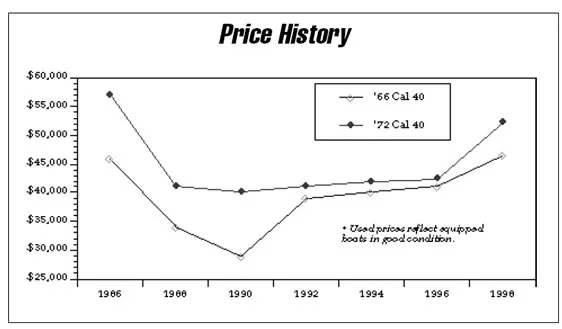
Conclusions The Cal 40, a hot racing boat when new, carries that legacy with her into maturity. Generally, the boats have been raced hard, some cruised hard as well.Owners have tended to be the type to add gear and modifications to keep the boat comfortable and competitive. The boats are likely to have a large inventory of much-used sails.
Because of her age and dated design, a Cal 40 may be available for much less money than a newer boat offering comparable quality and performance. Prices will vary according to the condition of the boat and gear, but will likely fall in the range of $40,000 to $50,000. If the boat has lots of add-ons in the galley and nav station, modern racing hardware, renewed standing rigging, new finish on the topsides, and the bottom is in good condition, it might fetch something higher. One performance extra to look for is a special (non-factory) fairing job on the keel and rudder that was available when the boats were young.
On the other hand, it should not be a surprise if there are areas that require attention, and you should calculate the cost of the work into the price you are willing to pay. Twenty or 25 years of hard sailing will take its toll. Significan’t expense could be incurred if the boat needs new wiring, an Awlgrip job on the topsides, extensive reinforcement of the interior furniture tabbing, a new engine, or new rigging. If racing is in your plans, new sails might be scheduled in as well.
This would be a good boat for a handy do-ityourselfer. Over the years, most of the boat’s problems have been solved more than once by other Cal 40 owners, many willing to share their wisdom. You would probably have a choice of solutions, and indications of which worked best.
Although there is not currently an active owners association, there persists a loose fellowship among present and former owners. If you buy a Cal 40, you will acquire a modest boat, with good pedigree and performance, and—should you desire them—a few new friends, as well.
RELATED ARTICLES MORE FROM AUTHOR
Leave a reply cancel reply.
Log in to leave a comment
Latest Videos

What’s the Best Sailboats for Beginners?

Why Does A Sailboat Keel Fall Off?

The Perfect Family Sailboat! Hunter 27-2 – Boat Review

Pettit EZ-Poxy – How to Paint a Boat
Latest sailboat review.

- Privacy Policy
- Do Not Sell My Personal Information
- Online Account Activation
- Privacy Manager
- THE PRINCESS PASSPORT
- Email Newsletter
- Yacht Walkthroughs
- Destinations
- Electronics
- Boating Safety
- Ultimate Boat Giveaway

Revisiting the Classic Cal 40
- By Herb McCormick
- November 20, 2023
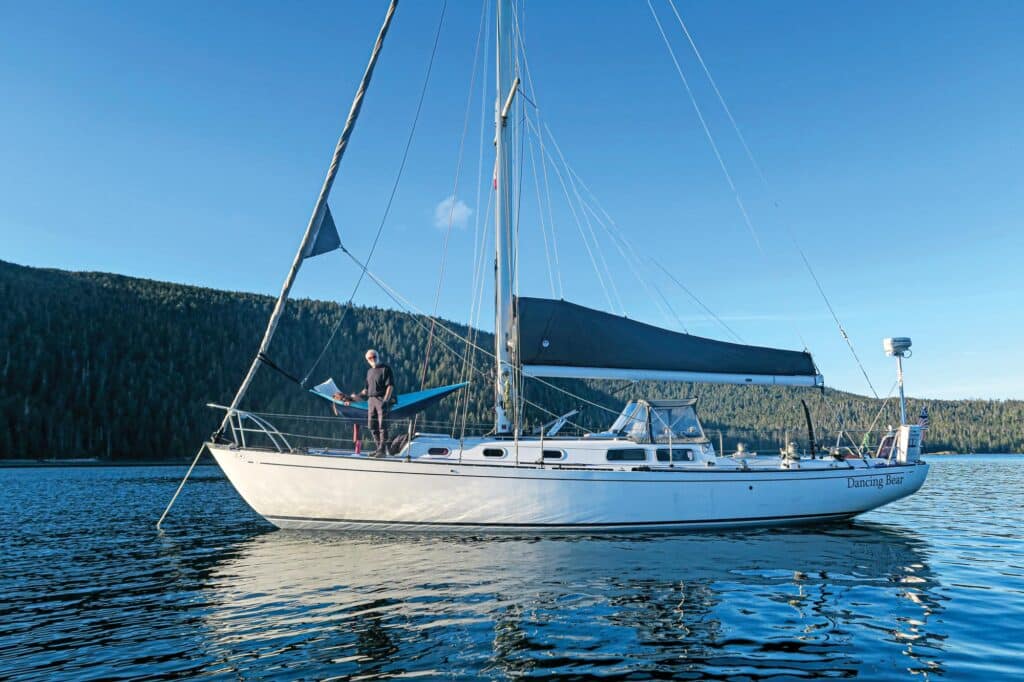
You never forget your best day of sailing. Mine came in the waning miles of the 2005 Transpac Race from Los Angeles to Honolulu, screeching down the Molokai Channel under spinnaker toward Diamond Head in 30 knots of pumping trade-wind breeze, hanging onto the tiller for dear, lovely life while surfing at 14 knots aboard a Cal 40 called Dancing Bear. The sun was searing, the wind was howling, and the deep, blue Pacific Ocean was all the more striking set against the stunning backdrop of the green volcanic islands.
This remembrance, however, is not about me. Instead, it honors the legendary Cal 40, a William Lapworth design originally launched in Southern California in 1963 that has provided scores of fellow offshore sailors with rides they’ll always hold dear. Though I do recall my first thoughts to a fellow shipmate soon after crossing the finish line: “God, I love a boat that’s better than I am.”
All this came back to me last summer, when I joined Dancing Bear’ s owner and skipper, accomplished Pacific Northwest sailor Mark Schrader, for a cruise northward from Anacortes, Washington, and up the coast of Vancouver Island. It’s a far different venue and excursion than the Transpac, but one that made me appreciate the Cal 40 in a new light. This is one versatile vessel.
From the outset, the Cal 40 was considered a radical, ultra-light design, displacing just 15,000 pounds with 6,000 pounds of ballast and a flat, canoe-shaped hull that was ideal for prolonged downwind surfs. What really separated it from other boats of its era—hulls with long overhangs and deep, full keels from prominent East Coast yacht designers like Sparkman & Stephens—was the fin keel and detached spade rudder, greatly reducing the boat’s wetted surface. A similar appendage was employed in the winning America’s Cup 12-Metre Intrepid, but that was four years later.
Read Next: An Ocean Sailor Tries Freshwater Racing
The Cal 40’s production run lasted eight years and produced 108 boats, which are still highly sought-after. There’s no question that the boat has reached cult status and that it remains highly competitive. Indeed, the overall winner of the 108-boat fleet in the 2022 Newport Bermuda Race and the recipient of the coveted St. David’s Lighthouse Trophy was Sally and Stan Honey’s Cal 40, Illusion.
Yes, the Honeys are world-class sailors—Stan is a renowned professional offshore racer and navigator, and Sally is a two-time Rolex Yachtswoman of the Year—and they recruited an all-star crew after Illusion had undergone a full refit. Still, Illusion was almost 60 years old. The Honeys purchased the boat in 1988 and spent the ensuing decades racing and cruising it. They decided to campaign it one final time in 2022. Their victorious attempt, covering the 635-nautical-mile voyage in 87 hours, included a textbook crossing of the Gulf Stream and a top-speed burst of 22 knots, both of which were winning highlights.
My own trip last summer on Dancing Bear was a decidedly more mellow affair, but we also scored our own personal highlights. For me, one of those was taking the helm on a cold, funky overnight passage from the coast of British Columbia across the Hecate Strait to the archipelago known as Haida Gwaii, formerly the Queen Charlotte Islands. The sensation of driving a solid craft offshore, nestled deep in the cockpit on a tiller-steered boat, is rare and wonderful. In the wind and waves, everything balanced and in harmony, I fell in love with the Cal 40 all over again.
- More: October 2023 , Sailboats , Sailing , Sailing Yachts , Silent Running , Yachts
- More Yachts
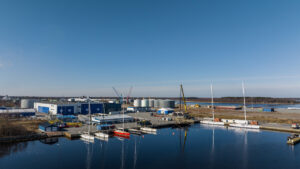
Luxury Yacht Giants Unite: Nautor Swan and Sanlorenzo Group Merger
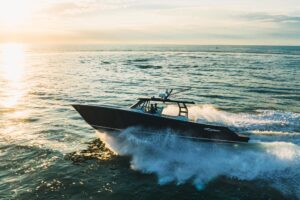
Halo 470 Reviewed
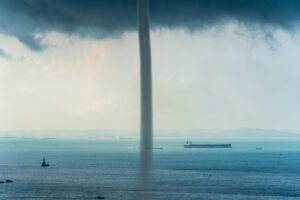
Superyacht Collision, Sinking Incident, Takeaways and Lessons
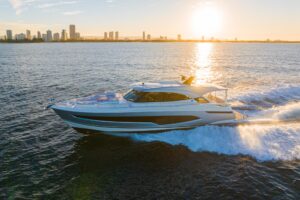
Riviera to Unveil 6800 Sport Yacht at Fort Lauderdale International Boat Show
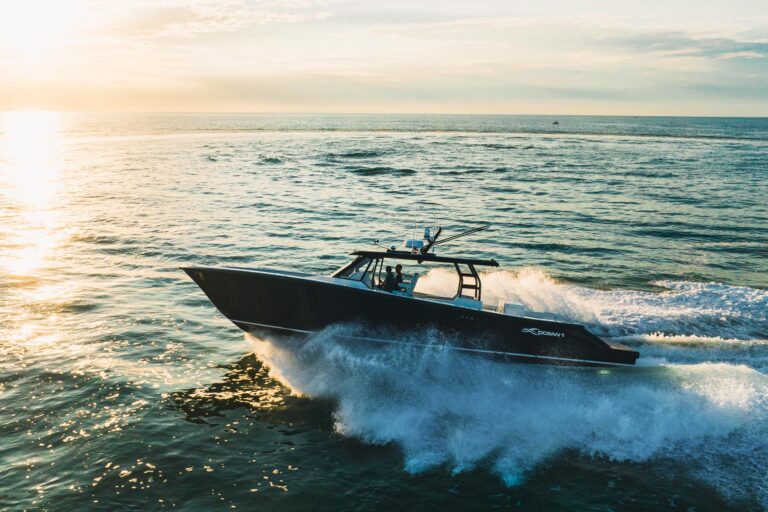
KVH Expands Its Hybrid Network with OneWeb’s LEO Satellites
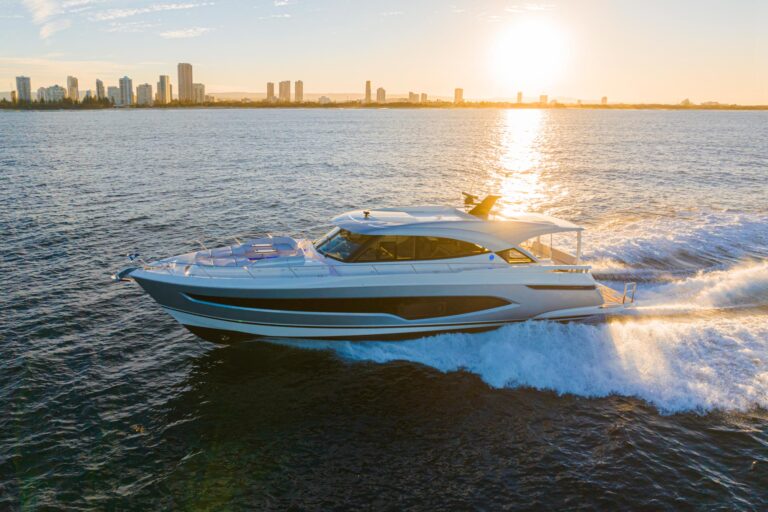
- Digital Edition
- Customer Service
- Privacy Policy
- Terms of Use
- Email Newsletters
- Cruising World
- Sailing World
- Salt Water Sportsman
- Sport Fishing
- Wakeboarding
You are using an outdated browser. Please upgrade your browser to improve your experience.

Orca 40 (Class 40)
Design number: year: 2008.
The first Humphreys design to the Class 40 box rule is the Orca 40 series built by Ocean Tec in Slovenia. The design is available in two versions – performance racing (optimised to hit Class 40 minimum weight and maximum righting moment) and an interchangeable standard racing / fast cruising version (with removable, modular interior units).
The Orca Class 40 has been engineered by Applied Structural Analysis Ltd (ASTA) and is built using a 3D infusion process, resulting in an extremely robust, yet lightweight structure. While competitively priced in line with several production Class 40s, the Orca 40 is very much a semi custom design. There are a wide range of customisable options with each new boat, including fixed or articulating bow sprit, deck layout and geometry (including central pod and pit winch, central mainsheet pod and winch, etc).
Please click here to visit the Ocean Tec website. If you have any further questions please contact HYD .


- Presentation
- Board of Directors
- Races open to Class40
- Championship
- Class40 selection
- Minutes of the Executive Meeting
- Class rules
- Appendix to class rules
- FFV/world sailing documents
- Constitution and internal regulation

3 fiche(s). Page 1/1
- 15 sept. CIC Normandy Channel Race
- 29 sept. Med Max I Occitanie - Saïdia Resorts
- 19 oct. Middle Sea Race

1 fiche(s). Page 1/1
New Class 40 for 2015 from Owen Clarke Design
The all new Owen Clarke Design (OCD) Class 40 is for a new owner in the United States.
She is a fully custom (although built in female production tooling) Class 40, now under construction at Carbon Ocean Yachts (COY) in Bristol, Rhode Island.
Design development began in the Spring of 2014 which has allowed Owen Clarke a good deal of time as well as resource to apply to a design that is signific antly different in a number of areas to what has been seen before in this class.
Source : www.owenclarkedesign.com

Display the whole heading

- AROUND THE SAILING WORLD
- BOAT OF THE YEAR
- Email Newsletters
- America’s Cup
- St. Petersburg
- Caribbean Championship
- Boating Safety
- Ultimate Boat Giveaway

Class 40 Mighty Mites
- By James Boyd
- May 23, 2023
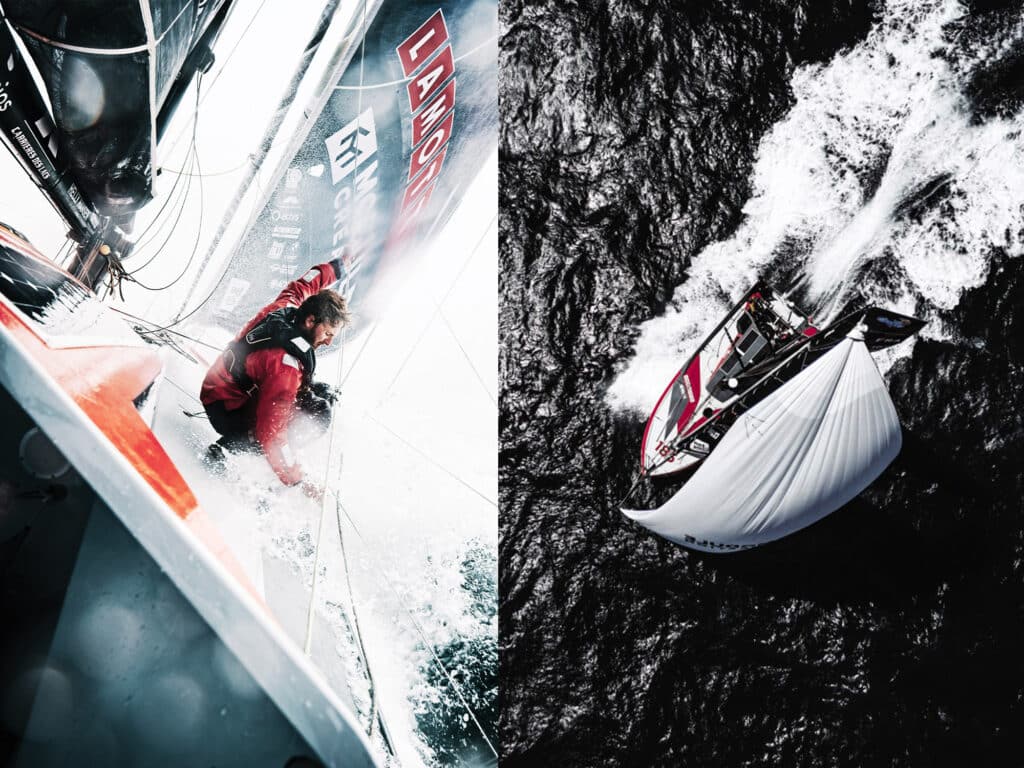
For sailing fans visiting from outside France, the Route du Rhum is a cultural shock, barely to be believed even once seen. It is France’s oldest singlehanded race, first held in 1978, and run every four years from St. Malo in northern France 3,500 miles across the North Atlantic to Guadeloupe. The fleet of 138 boats that assembled for the start in November 2022 was incredible, with an estimated value of 260 million euros—from the implausible 100-foot Ultime trimarans to a record fleet of 38 IMOCA 60s and a similarly impressive fleet of 55 Class40s. Dock sides are crammed with spectators, many hoping to catch a glimpse of the top skippers—some are genuine sports stars. Had the 2022 start not been delayed, French President Emmanuel Macron was to have attended. It’s that much of a big deal.
In the days and hours before the Route du Rhum started, more than 1 million people passed through its race village in St. Malo. In this environment, even non-French amateurs, such as the two US Class40 skippers, Alex Mehran and Greg Leonard, gained celebrity status with relentless autograph signing, selfies with fans and press interviews. Usually outshone by the bigger, higher-profile boats, the Class40 is the most successful 40-footer of all time. While the Farr 40 never topped more than 40 boats at a world championship, this is the second Route du Rhum in which more than 50 participated. To date, 192 Class40 hull numbers have been allocated.
While “Open 40s” once competed in the OSTAR and Around Alone, the Class40 came about independently. Born in France in the early 2000s, two designs defined the class: the Pogo 40 and the Jumbo 40. But the success and longevity of the Class40 is due to its highly constrictive box rule, drafted by a group that includes wise French sailor and journalist Patrice Carpentier, which remains robust 18 years on.
The box rule’s basic parameters are a maximum length overall of 39 feet, 11 inches; max beam of 14 feet, 9 inches; draft of 9 feet, 10 inches; average freeboard of 3 feet, 6 inches; max mast height of 62 feet, 4 inches; max working sail area of 1,238 square feet; minimum displacement at 10,097 pounds; and max water ballast of 1,653 pounds per side. Most brutal are the materials limitations: Carbon fiber, aramid, honeycomb cores and pre-preg resin are forbidden from the construction of the hull, deck, interior structure and fittings; go down below on one and, joyously, thanks to the GRP construction, it is not coffin black.
Carbon fiber is permitted for the mast, boom and bowsprit, while standing rigging must be steel rod. Sails are limited to eight, and all but two and the heavy-weather jib must be polyester and nylon. A single fixed keel and as many as two rudders are permitted, but daggerboards and foils are banned, as are canting, rotating masts, mast jacks, and adjustable or removable forestays. However, complex kick-up rudders are permitted. (Although their effectiveness to kick up in a collision is allegedly dubious.) Over the years, displacement and average freeboard have slightly reduced, but the biggest rule amendment has limited “how scow” Class40 hull shapes can be. While the latest foiling Protos in the Classe Mini (the “flying bathtubs”) are fully flat-bowed, Class40 has two max beam limits just short of the bow to prevent this. Naturally, costs have risen, but the rule has successfully limited them; today, a top Class40 costs 700,000 to 800,000 euros.
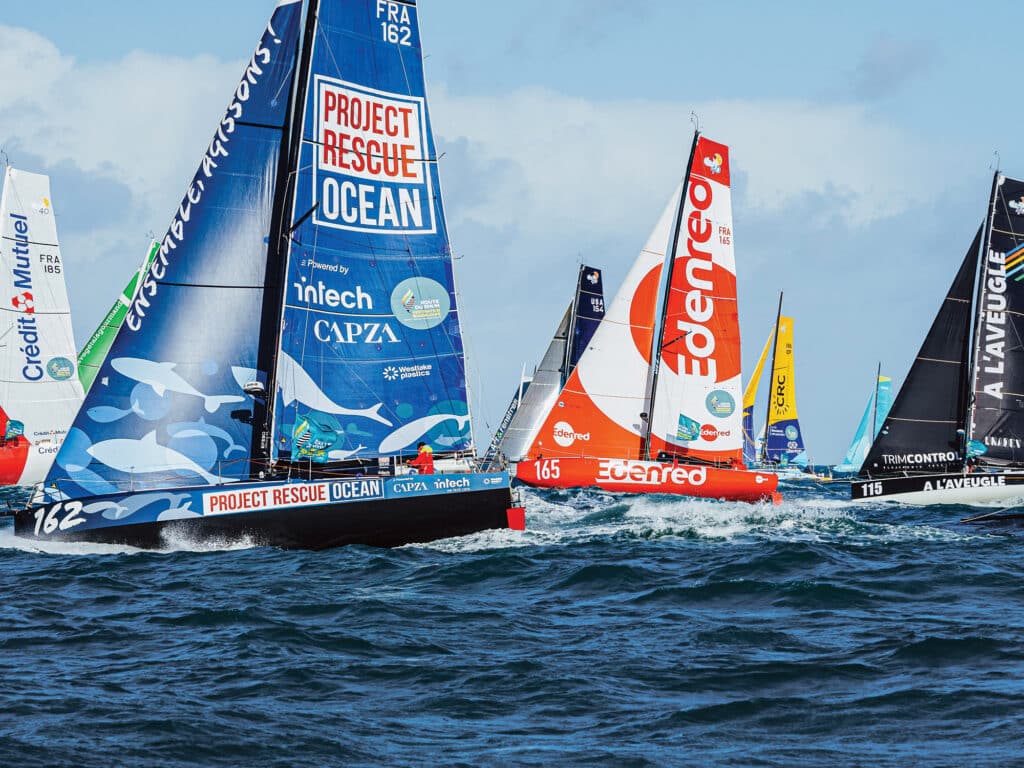
Those sailing the Class40s in the early days were a mix of pros and amateurs. Today professionals on sponsored boats are the majority. As for aspirant French pro sailors, the Class40 has become a significant stepping stone between from the Classe Mini and Figaro circuits to the IMOCA.
As skipper of Groupe SNEF , leading Mini and Figaro skipper Xavier Macaire says: “The transatlantic races like this [Route du Rhum] are very interesting to us, and the boat is not very expensive. The Class40 is easy to maintain and prepare, and is not a complicated boat like an IMOCA where you need 12 guys. With this, you need two or three, not full time. It is an easy, fast boat.”
With more top pros like Macaire joining, 30 new Class40s have been launched in the last four-year cycle. The most recent Route du Rhum podium, for example, comprised two-time Solitaire du Figaro winner Yoann Richomme ( Paprec Arkea ) and Mini Transat winners Corentin Douguet ( Queguiner-Innoveo ) and Ambrogio Beccaria ( Allagrande Pirelli ) of Italy.
Of the French classes, the Class40 and the Mini remain the most cosmopolitan, with entries from other European countries, notably Italy at present, while the United States, Australia and South Africa were also represented in the Route du Rhum. Far from being put off by the pro element, Americans Alex Mehran and Greg Leonard were thrilled to be on the same starting line. “It is such a privilege to race against some of the top offshore sailors in the world,” says Leonard, who hails from Florida. “It is like playing football against a first team in the NFL—it is that level of quality. There are not that many sports you can do that in.”
Both American skippers came to the Route du Rhum from similar paths. With his Mach 40.3 Kite , Leonard is a professional economist originally from Texas. He campaigned a J/120 for many years with his remarkable son Hannes, who raced his first doublehanded overnighter with his father at age 13. Now 18 and with thousands of race miles under his belt, both in the US and Europe, he is a Class40 expert. For his father, the Route du Rhum was his first singlehanded race.
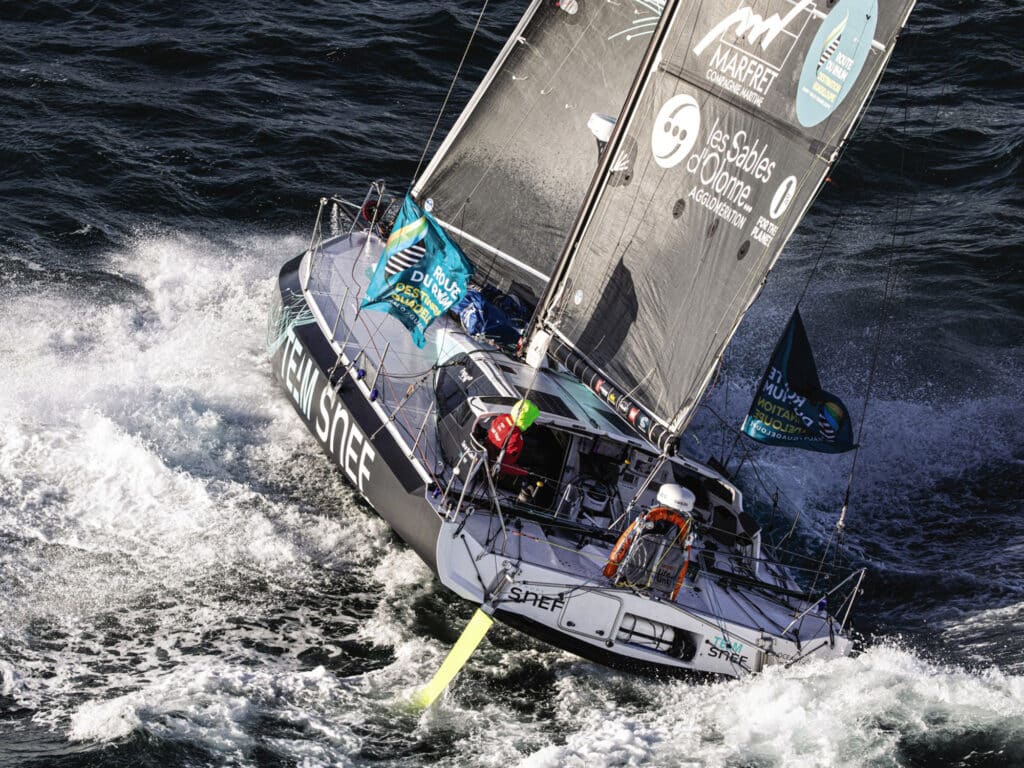
Over the years, several top shorthanded sailors, notably British Vendée Globe skippers Mike Golding and Miranda Merron, have raced with him, also coaching him. He is very enthusiastic about the Class40: “They are beautiful boats, such fun to sail. When we delivered her to St. Malo, we had 28 to 40 knots just aft of the beam, and we just hung in the low 20s boatspeed, and it was finger-light steering.”
Mehran skippers Polka Dot , which has the perfect pedigree, being Yoann Richomme’s 2018 Route du Rhum winner—a Lift V1 design. Growing up as part of the St. Francis YC Laser squad and subsequently a Brown collegiate sailor, he met Welsh Class40 designer Merfyn Owen in 2009 and raced one of his designs. Remarkably, he won his first major singlehanded race, the 2009 Bermuda 1-2. He subsequently graduated to an Owen Clarke-designed Open 50, in which he set a record in 2012’s singlehanded Transpac. He then went off, had four kids, and developed his commercial real estate business before getting the itch once more last year. He competed doublehanded with Owen in the 2021 Transat Jacques Vabre on an old Class40, but as Mehran puts it, “We needed to get something scow.”
He too has been receiving coaching from Merron and Golding, among others. According to Mehran, one of the most difficult things to explain to those back home is less the offshore-racing fever that afflicts French fans, but that their skippers are not multimillionaires. Instead, they come from a wide age group and all have commercial backing to either buy a secondhand boat or—if they are higher-profile, more accomplished or just plain lucky—build a new one. So, returning to the Route du Rhum podium, Paprec’s business is waste disposal (admittedly, its owner races his own Wally 107), Arkea is banking and insurance, Queguiner is building materials, Innoveo is an app-development platform, and Pirelli makes tires (its CEO has a Wally 145).
Over the last two decades, the Class40s themselves have evolved, despite Draconian design limitations. What started as cruiser-racers with fitted-out interiors became racer-cruisers and are now refined pure racers. They may not be black inside, but the build quality of the latest-generation designs is of the highest standard, and it seems no longer possible to buy a cruiser-racer.
A delight of the Class40 is that no one designer is dominant; eight different designs make up the 30 boats built over the last four years. Pogo Structures, last of the original builders, is on its fourth version of its Pogo 40, the S4, designed by Emirates Team New Zealand’s naval architect, Guillaume Verdier (who also designed Structures’ scow-bowed flying Proto Mini).
The man who developed the first blunt-fronted scow Mini, David Raison, produced the Max40, built by JPS in La Trinité-sur-Mer. Also built by JPS are Sam Manuard designs—the Mach 40.4, such as the 2021 Transat Jacques Vabre winner Redman , skippered by Antoine Carpentier (nephew of the original rule’s writer), and now its evolution, the Mach 40.5, of which two competed in the Route du Rhum.
In 2020, VPLP made its first foray into the class with the Clak 40, built by Multiplast, of which four raced in the Route du Rhum, the top finisher being Martin le Pape’s Fondation Stargardt. Etienne Bertrand, another successful Mini designer, had two Cape Racing Scow 40s in the race, while Allagrande Pirelli , believed to be the most expensive of the latest crop and campaigned by last year’s Mini Transat winner, Ambrogio Beccaria, is an all-Italian affair designed by Gianluca Guelfi and built by Sangiorgio Marine Shipyard in Genoa.
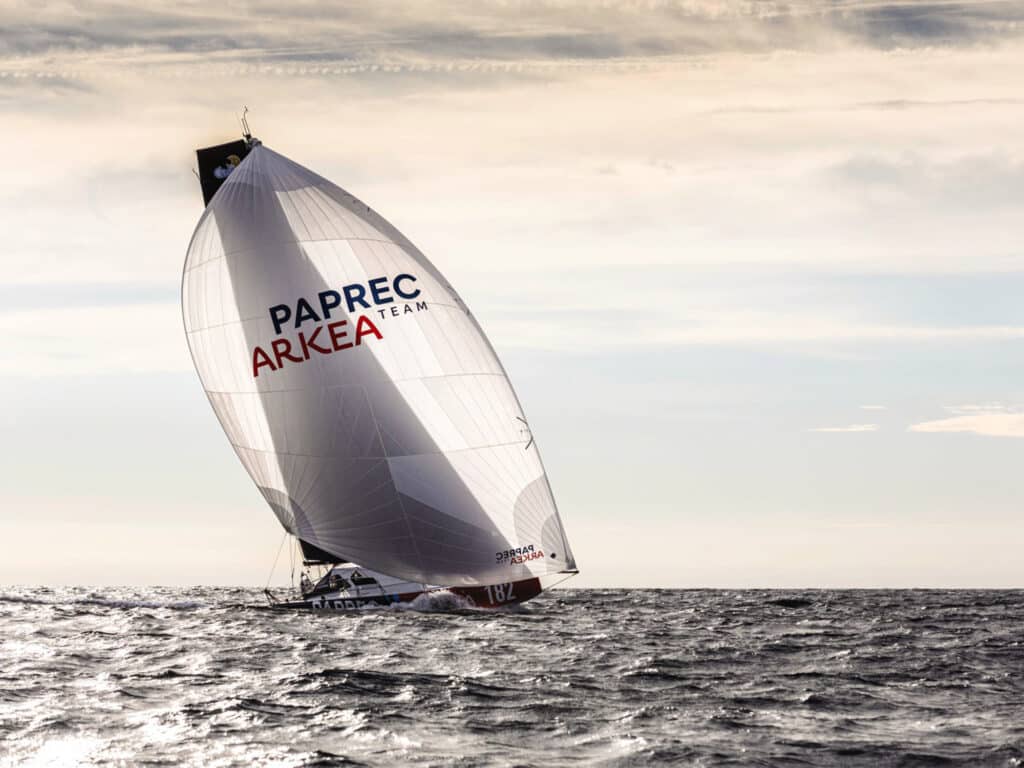
However, after the recent Route du Rhum, nosing in front in the design race is Marc Lombard with his Lift V2s, of which seven were racing, including Yoann Richomme’s winner, Paprec Arkea . Lombard is one of the longest continuous players in the Class40, and has worked with Tunisian manufacturer Akilaria on its RC1, RC2 and RC3 models since 2006, of which 38 were built. His latest designs have been the Lift, introduced in 2016; Veedol-AIC , one example, took Richomme to his first Route du Rhum victory. The Lifts were custom-built with a hull and deck made by Gepeto in Lorient, but finished off by the V1D2 yard in Caen, and were more precisely engineered and built than the Akilarias. They were superseded this cycle by the Lift V2, the most popular of the new Class40s, with seven competing.
For Richomme, the Route du Rhum was a small distraction from having a new IMOCA built. He entered the Route du Rhum to defend his title and stay race-fit. If the first Lift was an early scow, the present one is at the limit, to the extent that it has a bump in the hull 2 meters aft from the bow at the limit of where the Class40 rule restricts the max beam to prevent such extreme scowness.
The scow bow provides more righting moment, but it also does interesting things to the boat’s hydrodynamics. “With a pointy bow, the keel is more angled and creates more drag,” explains Richomme, who is also a trained naval architect. “When a scow heels, the hull is almost parallel to the keel, so sometimes when we go over the waves, we can feel the keel shudder when it is producing lift. The chine is low and therefore very powerful, and when we heel, it makes for a very long waterline length. Also, we have very little rocker, whereas other [new] boats have a lot, which creates a lot of drag so they don’t accelerate so well when they heel.”
The Lift V2 “is a weapon reaching,” Richomme says. “We can hold the gennaker higher than we used to. Last time, I didn’t even take one. But with the power going up, so have the loads, and we are having problems with the hardware. I have broken two winches already.”
A downside of the big bow and straight chine is downwind, where the technique seems to be preventing the bow from immersing. Paprec Arkea is typically trimmed far aft, including the stack and the positioning of the 1,653 pounds of water ballast (most new boats have three tanks each side), while its engine is 19 inches farther aft, and the mast and keel 11 inches farther aft than they were on his previous boat. They are 77 pounds below the minimum weight, which Richomme admits may be too extreme—during training they broke a bulkhead.
Otherwise, their increased cockpit protection is most noticeable on all the new designs (although not to IMOCA degrees), while most have a central pit area with halyards fed aft from the mast down a tunnel running through the cabin. On Paprec Arkea , a pit winch is mounted just off the cockpit sole. With the main sheet and traveler lead there as well, Richomme can trim from inside the cabin.
Most extraordinary about the scows is how fast they are. Anglo-Frenchman Luke Berry, skipper of Lamotte-Module Création , graduated from a Manuard Mach 40.3 to a 40.5 this year and says: “It is a massive improvement both in speed and comfort. Reaching and downwind, we are 2 knots faster, which is extraordinary.”
The top speeds he has seen are 27 to 28 knots. “Most incredible are the average speeds—higher than 20.”
This effectively turns yacht-design theory on its head, with waterline length and hull speed having less effect upon defining the speed of a boat that spends so much time planing. On the Mach 40.5, the waterline is just 32 feet, with a length overall of 39 feet. Compared to the Lift V2, it has more rocker, supposedly making it better able to deal with waves.
Nowhere is the speed of the latest Class40s more apparent than where they finished in the Route du Rhum in comparison to the IMOCA fleet. Paprec Arkea arrived in Guadeloupe ahead of 13 IMOCAs, or one-third of the way up the IMOCA fleet. Richomme says he used to sail on a Lombard-designed IMOCA 20 years ago, when they would make 10.5 knots upwind. “On a reach, I reckon we are faster than them now. We can do 20 to 22 knots average speed.”
Ugly seems to be quick, but when it comes to the Class40, beauty is in the eye of the beholder of the trophy.
- More: Class 40 , Offshore Racing , Print March 2023 , Racing , Sailboat Racing
- More Racing

Rivals Flush American Magic Facemask Rule Enquiry

The Reemergence of Jimmy Spithill

Running Tide Runs Swiftly Still

Mistakes And Misfires On the Final Day of Cup’s Preliminary Regatta

Emirates Team New Zealand Remain the Bullies of Barcelona

Start-Box Sparring in Barcelona on Day 2 of Preliminary Regatta


Real-time Wind Overlay Feature Added to Cup Broadcast

- Digital Edition
- Customer Service
- Privacy Policy
- Terms of Use
- Cruising World
- Sailing World
- Salt Water Sportsman
- Sport Fishing
- Wakeboarding
- Event calendar
- Annapolis Sailboat Show
- Fort Lauderdale International Boat Show
- Miami International Boat Show
Oceanis 30.1
Oceanis 34.1, oceanis 37.1, oceanis 40.1, oceanis 46.1, oceanis 51.1.
- Oceanis Yacht 54
- Oceanis Yacht 60
- FIGARO BENETEAU 3
- Heritage Sailing Yacht
- Flyer 7 SUNdeck
- Flyer 7 SPACEdeck
- Flyer 8 SUNdeck
- Flyer 8 SPACEdeck
- Flyer 9 SUNdeck
- Flyer 9 SPACEdeck
- Antares 7 Fishing
- Antares 8 Fishing
- ANTARES 11 FLY
- Gran Turismo 32
- Gran Turismo 36
- Gran Turismo 41
- Gran Turismo 45
- Swift Trawler 35
- Swift trawler 41 Sedan
- Swift trawler 41 Fly
- Swift Trawler 48
- Swift Trawler 54
- Grand Trawler 62
- Heritage Powerboats
- Future Owners
- A REMARKABLE ANNIVERSARY
- Our History
- Our Architects and Designers
- Our philosophy
- Our Innovations
- Your way to ownership
- Tests and Awards

- Description
- Key Features
Specifications
Following in the wake of her elder sister the Oceanis 46.1, this 40-foot cruiser, with a new hull design by Marc Lombard , offers unrivaled deck volume and interior space , with zero concessions to performance. The Oceanis 40.1 is available in different layouts, drafts and rig options , adapting to the most demanding sailor’s cruising requirements and satisfying their need for comfort and pleasure under sail.
NAVAL ARCHITECT : Marc Lombard
INTERIOR & DECK DESIGN : Nauta Design
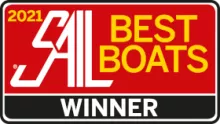
YouTube est désactivé. Autorisez le dépôt de cookies liés aux vidéos pour accéder au contenu.
Exterior design
How can you enjoy life at anchor as much as while sailing? With the innovative flared hull design of the Oceanis 40.1, BENETEAU has broken new ground but made no concessions. The result is a hull that has true speed potential and is stiff under sail. Above the waterline, her deck plan and ultra-spacious interior by Nauta Design is unheard-of on a boat this size. You cannot help feeling that you are aboard a 45 foot cruiser!
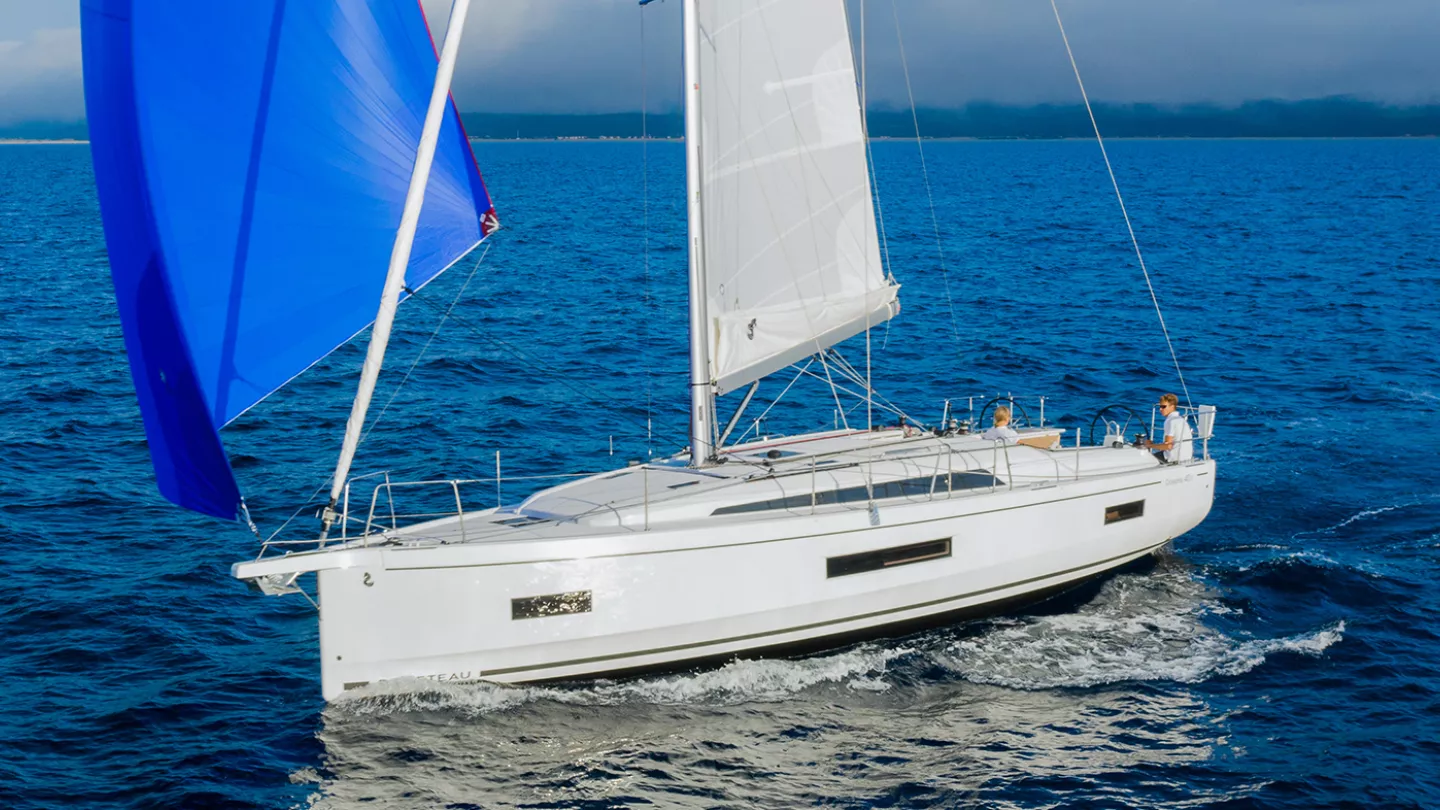
Interior Design
With your choice of either a walnut or white oak , the styling of the interior by Italian designer Nauta is remarkably bright and excels in the skillful arrangement of the living spaces. She is available with two, three, or four cabins, and a C-shaped galley to the starboard that offers an abundance of storage and a spacious countertop. On the port side, there is a large salon with a table, complete with a removable bench. A chart table at the foot of the companionway provides ample working space. Everything is modular, so that everyone can live the way they want and enjoy sailing wherever the wind takes them.
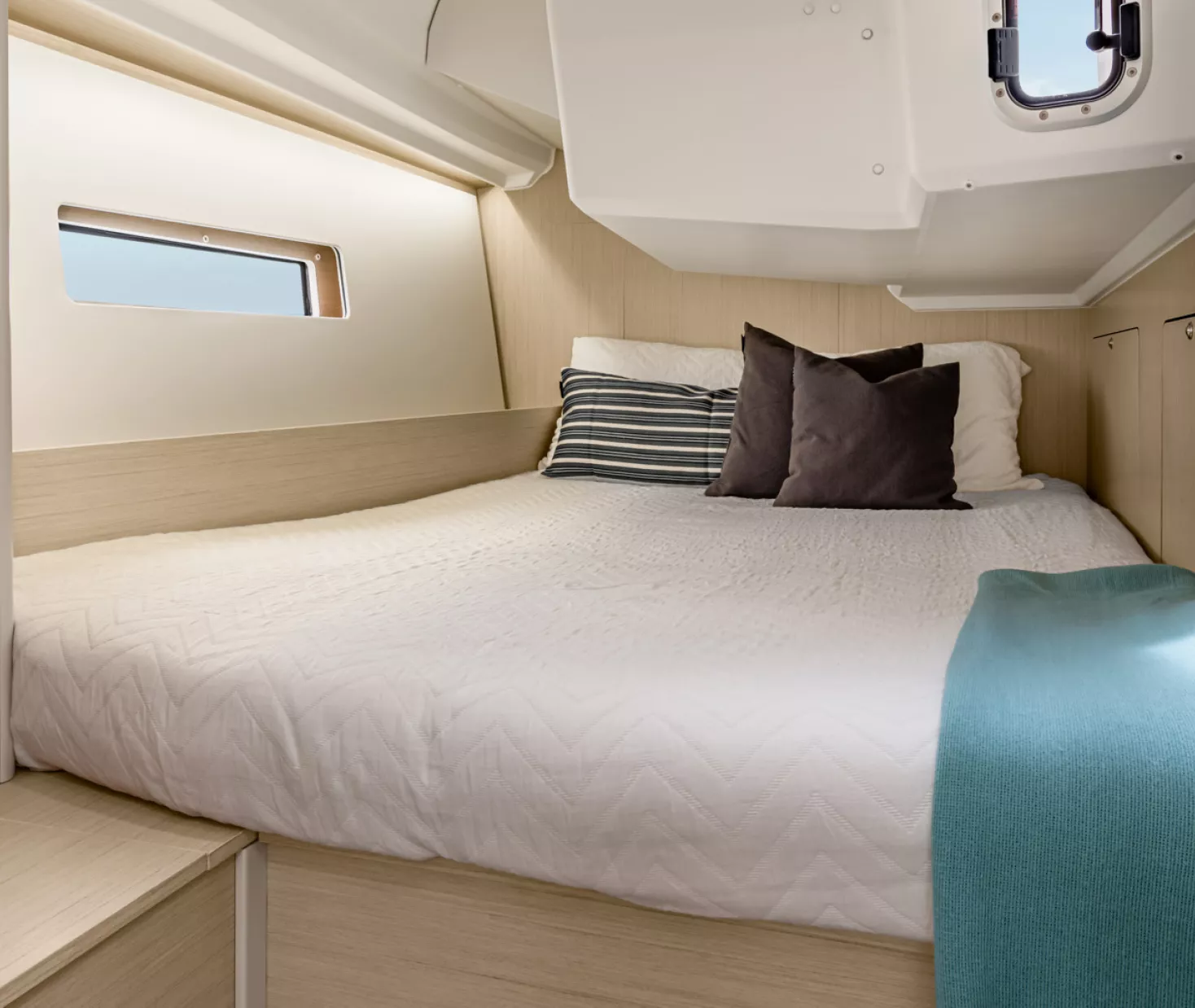
40 FEET OF SPACE!
The philosophy of the Oceanis 40.1 is to make sailing and mooring pleasurable. The strengths of this cruiser, studied in detail by the architect Marc Lombard and the BENETEAU design office, are unrivalled interior space, a huge deck plan, and the ability to clock up miles when you are cruising.
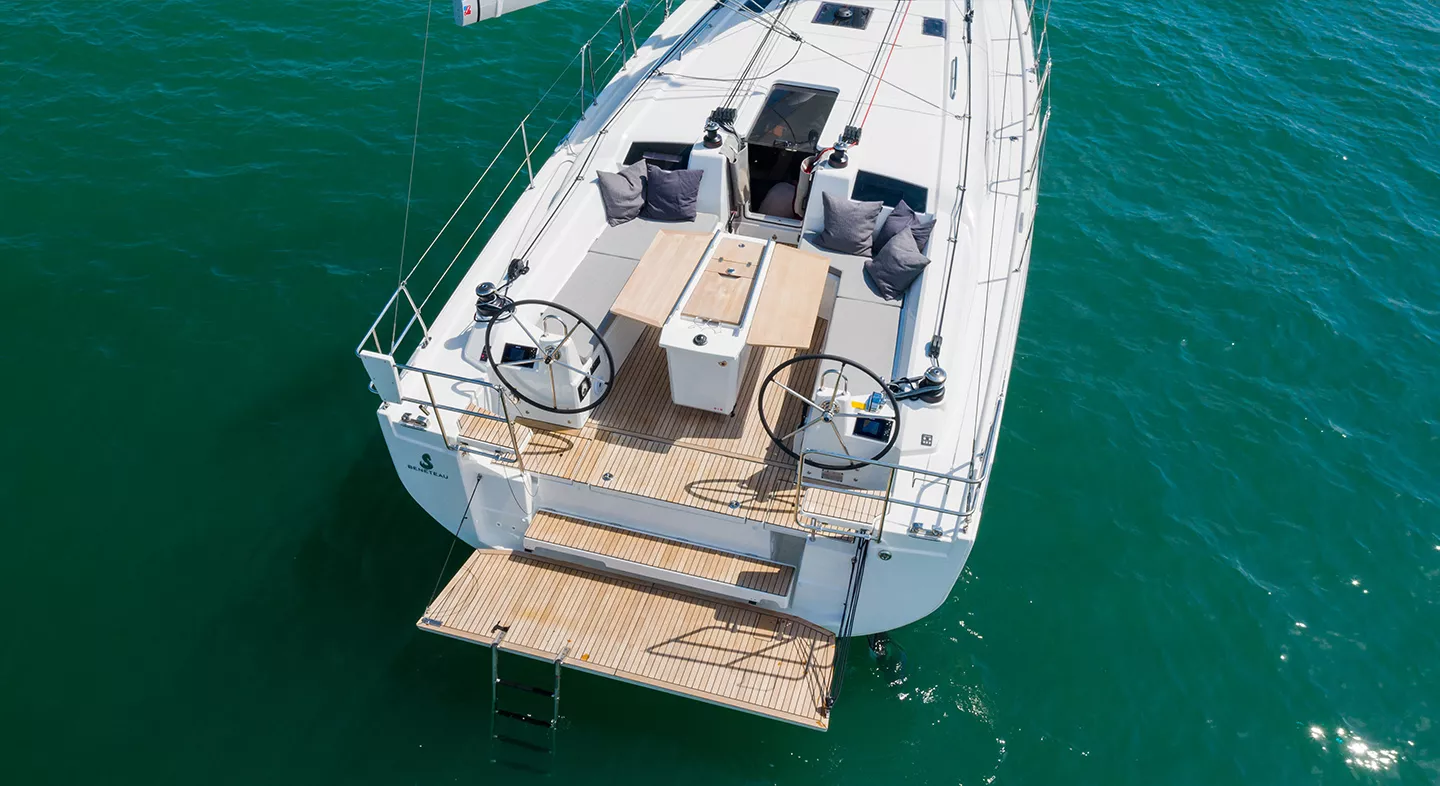
LIFE AT ANCHOR
The ergonomics and easy maneuvering in the cockpit make life onboard simple. Nothing interferes with the joy of life at anchor. Feel like splashing around the boat in an idyllic creek? The transom easily converts to an extensive swim platform, similar in size to the ones you find on the largest Oceanis cruising yachts. Having access to the sea is an integral part of life on a sailing yacht, and this model is one of a kind.
SEEKING EXCITEMENT UNDER SAIL…
As there is no one way to sail, and because everyone takes their cruising at their own pace, the Oceanis 40.1 comes in several versions. Sailors keen on performance can choose the First Line Pack, with a taller mast and a deeper draft. Alternatively, the in-mast furling system and self-tacking jib will make maneuvering easier when shorthanded. A classic mast for a semi-full batten mainsail is also available.
HEAVENS ABOVE, SO MUCH SPACE!
The hatches and the many hull and coachroof portholes, two of which face towards the cockpit, fill the boat with natural light and ventilation, making her exceptionally bright. The Oceanis 40.1 comes in 4 different versions with two, three, and four cabins to accommodate everyone’s idea of a holiday on board. Couples and large families will feel at home. The owner version has a cabin with an ensuite shower and head, and a bed easily accessible from either side. The four-cabin layout has two forward berths with bunk beds.
Equipped With SEANAPPS
The easiest way to keep your boat safe and ready to cruise anytime.
The new Seanapps app is the ultimate solution to help you indulge your passion for boating. With the touch of your finger, you can easily connect, monitor and order services for your boat – from routine maintenance, to requesting a wash or fuel or having us complete a repair.
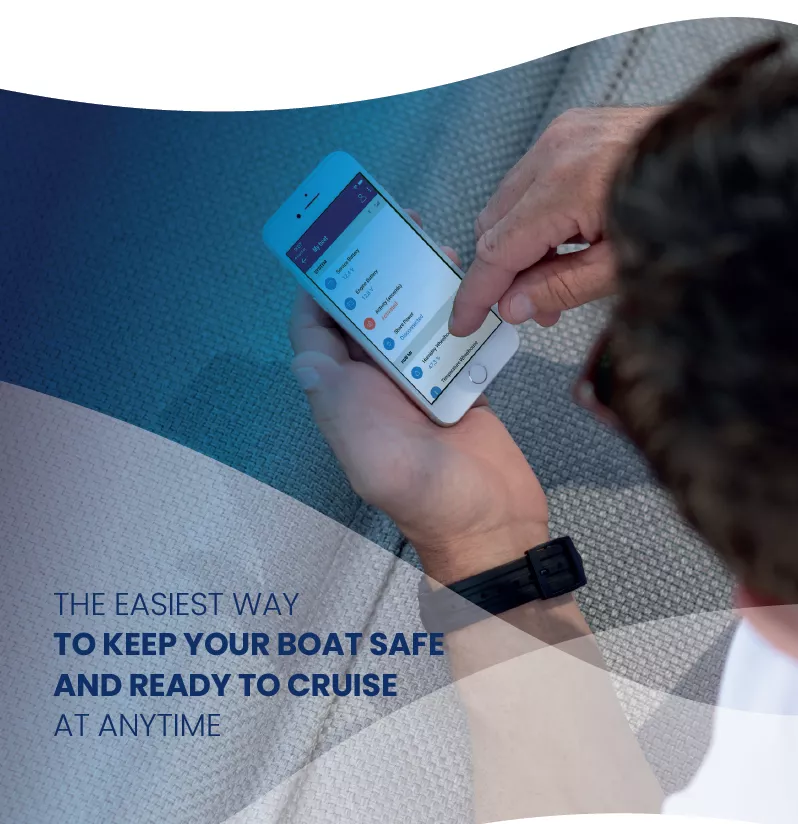
Virtual tour
The information below is intended for general informational purposes only and is subject to change without notice and does not constitute a contractual agreement. Any descriptions, representations, or statements made in this document are not to be considered binding unless explicitly stated otherwise in a formal contractual agreement.
Length Overall
Beam overall
Light displacement
Air Draft Max
Fuel Capacity
Water Capacity
Max. engine power
Cabin Number
CE Certification
A10 / B10 / C12
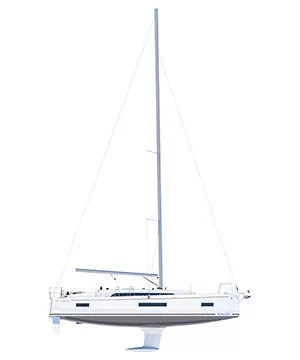
- CE Certification A10/ B10/C12 (12 passengers on board).
- Large benches seating six guests, with a fold away table.
- Two steering wheel stations each with a comfortable seat.
- First Line version: extra-long mast and bigger draft.
- Standard version: in-mast furling system and self-tacking jib.
- Large locker in 2 sections in the cockpit floor.
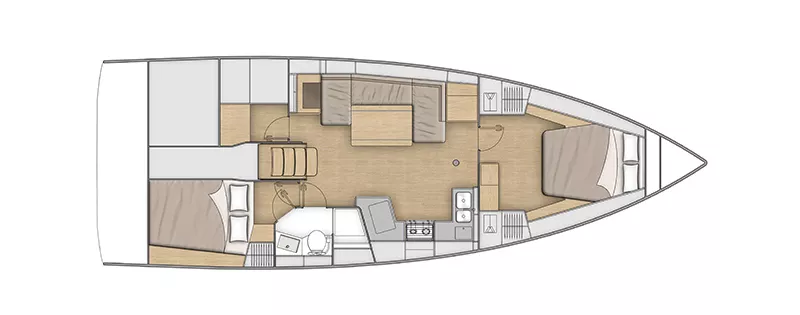
2 cabins & 1 head
- U-shaped salon seat
- C-shaped fitted galley: fridge, sink, 2-ring hob, oven, storage and worktop.
- Master cabin with double bed positioned on the boat center line.
- Aft cabin with double berths.
- Shower room with shower compartment and marine toilet.
- Several hull portholes and coach roof port lights make the space naturally bright.
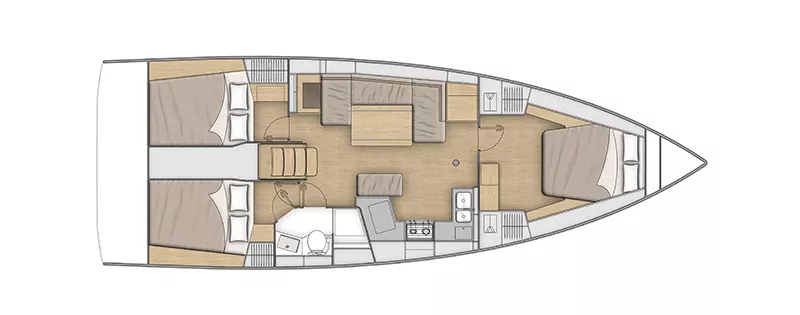
3 cabins & 1 head
- U-shaped salon seat.
- Master cabin with double bed positioned on the boat’s centreline.
- Two aft cabins with double berths.
- Shower room with shower compartment, washbasin cabinet and marine toilet.
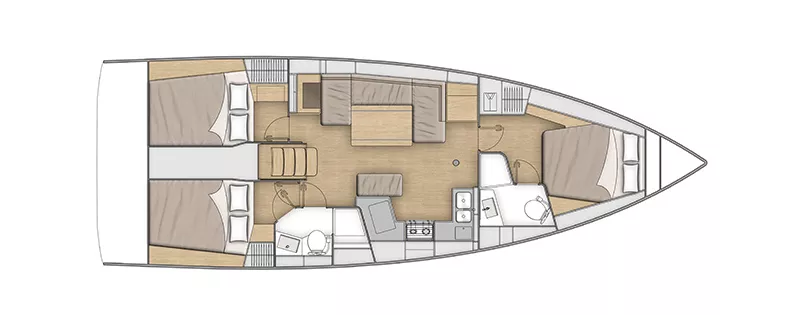
3 cabins & 2 heads
- Two shower rooms with shower compartment and marine toilet.
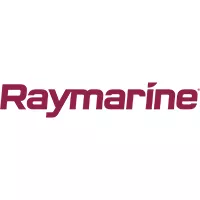
HARKEN HARDWARE

Press Reviews
Boat Review - The layout on the new Beneteau 40.1 is excellent for ease of sailhandling, notes Ewenson. Read More
Yachting Art
Boat Review - All about the coming BENETEAU Oceanis 40.1. Read More
Cruising World
Virtual Q&A - Cruising World recently sat down with Beneteau to get the inside scoop on the brand new cruiser. Read More
BOAT REVIEW: The boat is the new BENETEAU Oceanis 40.1, and it seems to be having as much fun as the crew. Read More
All Oceanis news
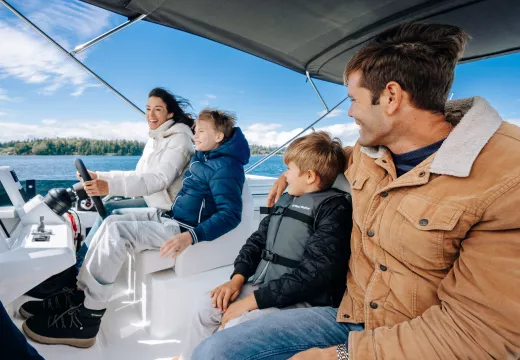
Seizing the Moment: Uncover Exceptional Value in BENETEAU Ownership
Current market conditions offer unprecedented opportunities to purchase a BENETEAU at discounted prices, with faster delivery times, and potential long-term financial benefits.
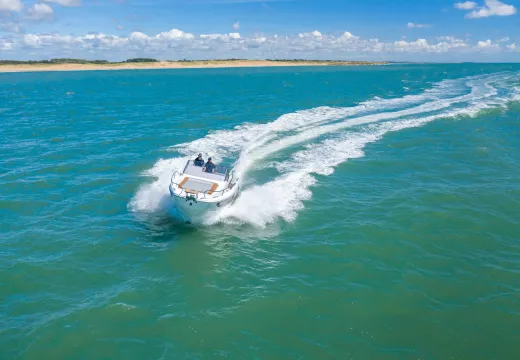
Activities to Enjoy on Your Next Sailing Yacht or Powerboat Trip
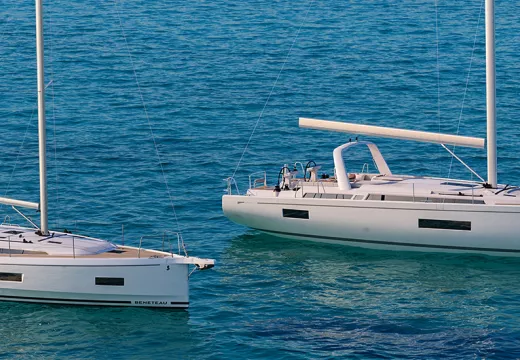
Oceanis 40.1 and Oceanis Yacht 54: The New Wave of Oceanis Cruising Yachts by BENETEAU
Customer care.
Buying a BENETEAU doesn’t have to be a daunting task. We have teams of experts to guide you through the entire process – everything from sea trials, financing, and customization to after-sale commissioning, service, and maintenance. We are proud to have one of the largest, most highly-regarded dealer networks in the world. We’re ready to provide you with the assistance and expertise needed to launch you and your BENETEAU on a lifetime of happy, rewarding, and memorable voyages.
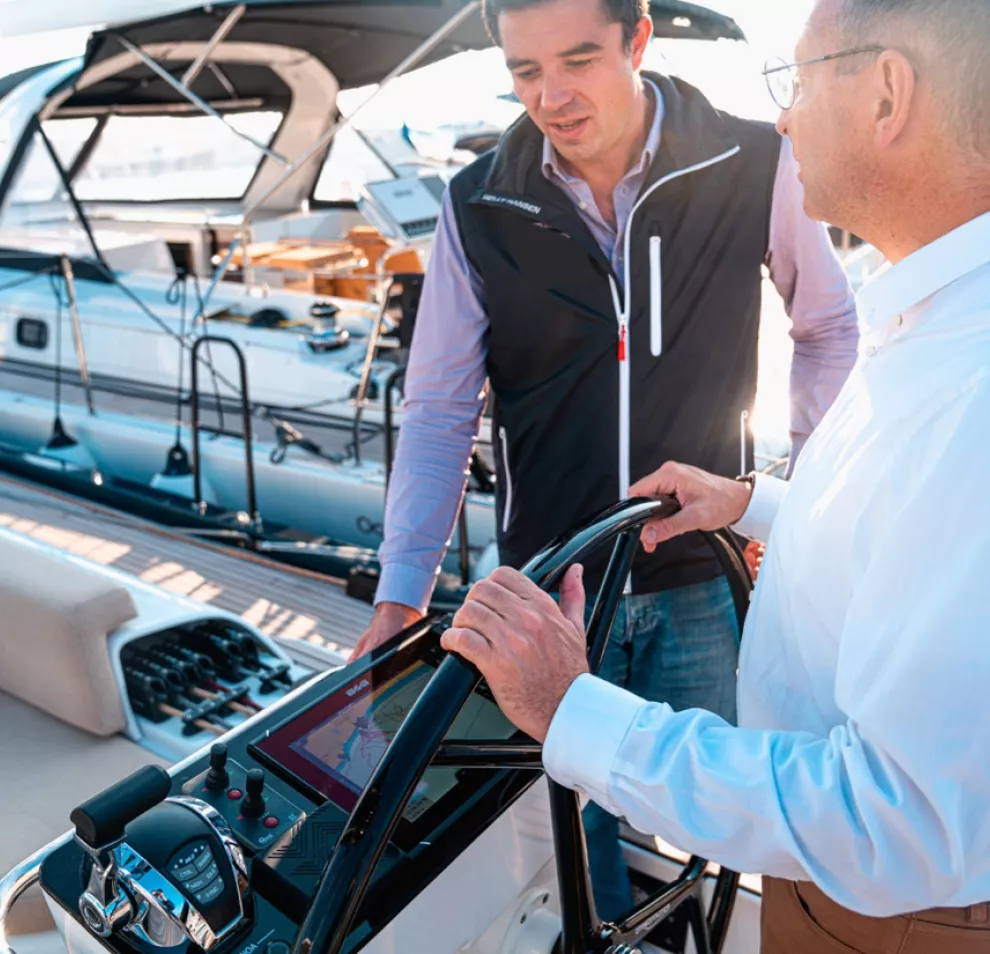
Other models in the range
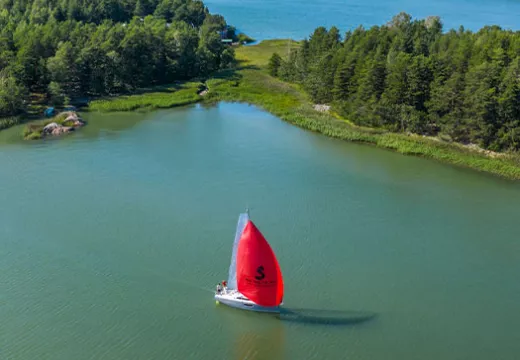
9.53 m / 31’3’’
2.99 m / 9’10’’
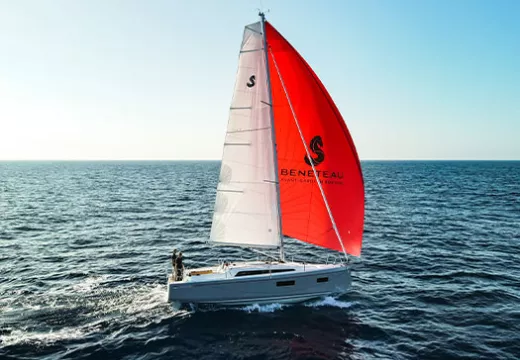
10.77 m / 35’4’’
3.57 m / 11’9’’
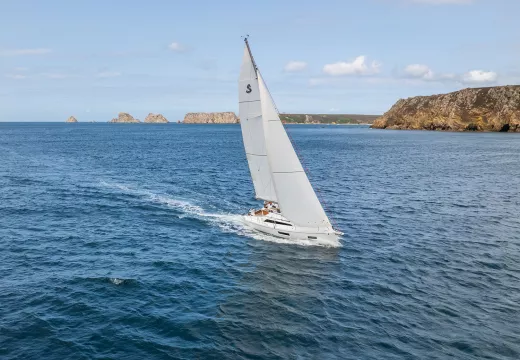
11.93 m / 39’2’’
3.92 m / 12’10’’
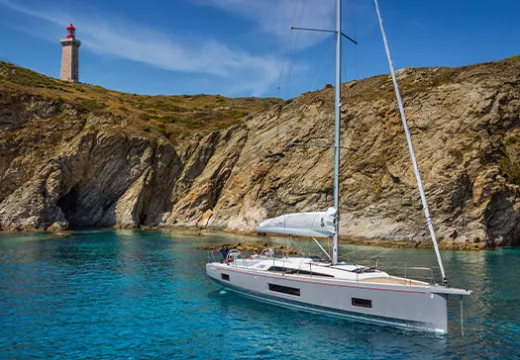
14.6 m / 47’11’’
4.5 m / 14’9’’
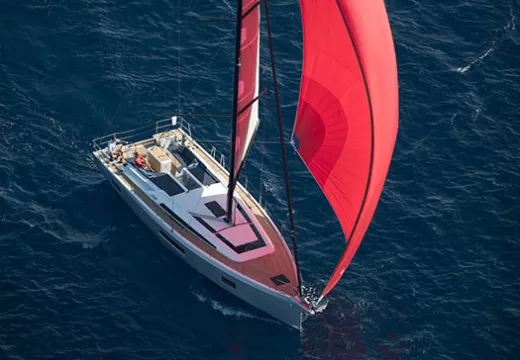
15.94 m / 52’4’’
4.8 m / 15’9’’
Select your area and your language
- Chinese, Simplified
- OC Wally Cento
- 84 Mini Maxi
- IMOCA Open 60
- Consultancy Services
- 30m Blue Water Cruiser
- 25m Explorer Yacht
- 24m Fast Cruising Catamaran
- 23m Performance Cruiser
- 20m Explorer Yacht
- 20m High Performance Cruiser
- 18m Blue Water Cruiser
- 15m Performance Cruiser
- 15m Explorer Yacht
- 12m Explorer Yacht
- Multihull Design
- 18m Explorer Yacht
- 40m Blue Water Cruiser
- 40m Cruiser Racer
- 33m Performance Cruiser
- 30m Wally Cento
- 24m ORCsy Racer Cruiser
- 24m Day Sailer
- Carbon Component Design
- Yacht Performance Development
- CFD and Model Testing
- Twin Rudder Steering Systems
- Custom Deck Hardware
- Modifications and Refit
- VPP Routing and Sail Analysis
- Classic Yacht Refit & Optimisation
- Naval Architecture
- Engineering
- Rudder Design
- Brokerage Services
- 'Seahorse Magazine' #192
- 'Divoc' #190
- Lucent #180
- Influence #171
- 'Eora' #169
- 'The Three Brothers' #168
- 'Edenred' #165
- 'BHB3' #163
- 'Teata' #148
- 'Kite' #144
- ‘Sensei’ #131
- 'Gryphon' #106
- 'Horizon' #104
- 'Sabre II' #93
- 'Letto Di Pletto' #47
- 'Mowgli' #41
- 'Graybeard' #39
- 23.8m Ultime Trimaran
- 20.7m Orma Trimaran
- 18.28m Orma Trimaran
- 16.75m Cruising Catamaran
- 16.1m Cruising Catamaran
- 12.8m Crowther Shockwave Catamaran
- 9.1m Seacart 30 Trimaran
- 26.3m Aluminium Sloop
- 21.0m Steel Schooner
- 21.0m Aluminium Cruising Ketch
- 20.0m Aluminium Explorer Yacht
- 20.0m Luca Brenta Racer Cruiser
- 19.6m Aluminium Bluewater Cruiser
- 19.2m Aluminium Lifting Keel Sloop
- 18.8m Custom Steel Sloop
- 18.23m Mylius Racer Cruiser
- 16.0m Sly Cruiser Racer
- 14.5m Aluminium Cruising yacht
- 13.87m Wooden Motor Sailer
- 11.6m Classic Pilot Cutter
- 25.25m Reichel Pugh Maxi
- 18.28m IMOCA 60 Nexans WeWise
- 18.28m IMOCA 60 'Canada Ocean Racing'
- 18.28m IMOCA 60 One Planet
- 15.85m TP52 Georgia
- 15.84m TP52 Racing Yacht 'Alizee'
- 15.25m Pegasus Open 50
- 12.8m Fast 40
- 10.89m Figaro 3
- 10.11m Sun Fast 3300
- 19.2m Lifting Keel Sloop
- 14.5m Aluminium Cruising Yacht
| It’s not surprising that Owen Clarke Design is delving into the world of the medium size IRC and ORC racing sailboats. It is after all the latest rating rule and Fast 40 designs that have steadily increased sail area, reduced displacement and so now come within our sphere of expertise. It’s unlikely any design office in the UK, and few worldwide have completed as much development and testing on hulls and appendages for high performance yachts as OC in the last twenty years. We believe we have something new to offer, a game changing winner. Any one design class yacht cannot have an advantage over a wide range of conditions. It has to have a range in which it performs best. That will always be its disadvantage when it comes up against custom or semi-custom designs optimised for local conditions and/or a particular kind of sailing. This is what is in this offering from OC for those owners who want something different and/or want to be involved in the design and build of their own custom racing yacht. reinforced our initial impressions that for races such as the Sydney to Hobart, as well as in North West Europe, the Caribbean, including Key West and some other classic regatta locations there was likely to be a strong case for a design optimised around higher mean wind speeds. Higher than those we believe most current designs are targeted at. Conservatively we estimated a target TCC of 1,22 would put us firmly in the ballpark and so we began work on optimising the two best candidates we had developed. As part of these studies the tables above show course time comparisons in different wind speeds for windward/leeward, inshore and Olympic courses, as well as the Fastnet Race for twin and single rudder candidate designs.For an explanation of the technology behind the design process go to: For an insight into our engineering and detailed design work go to: |
- BOAT OF THE YEAR
- Newsletters
- Sailboat Reviews
- Boating Safety
- Sails and Rigging
- Maintenance
- Sailing Totem
- Sailor & Galley
- Living Aboard
- Destinations
- Gear & Electronics
- Charter Resources
- Ultimate Boat Giveaway

40 Best Sailboats
- By Cruising World Editors
- Updated: May 24, 2024
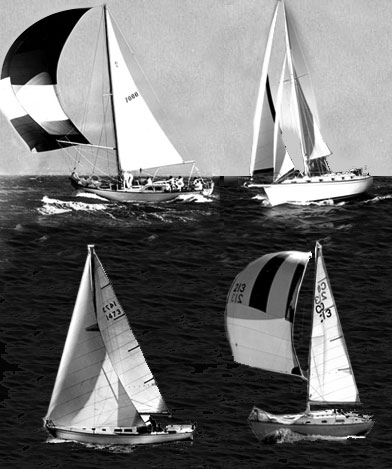
Sailors are certainly passionate about their boats, and if you doubt that bold statement, try posting an article dubbed “ 40 Best Sailboats ” and see what happens.
Barely had the list gone live, when one reader responded, “Where do I begin? So many glaring omissions!” Like scores of others, he listed a number of sailboats and brands that we were too stupid to think of, but unlike some, he did sign off on a somewhat upbeat note: “If it weren’t for the presence of the Bermuda 40 in Cruising World’s list, I wouldn’t even have bothered to vote.”
By vote, he means that he, like hundreds of other readers, took the time to click through to an accompanying page where we asked you to help us reshuffle our alphabetical listing of noteworthy production sailboats so that we could rank them instead by popularity. So we ask you to keep in mind that this list of the best sailboats was created by our readers.
The quest to building this list all began with such a simple question, one that’s probably been posed at one time or another in any bar where sailors meet to raise a glass or two: If you had to pick, what’re the best sailboats ever built?
In no time, a dozen or more from a variety of sailboat manufacturers were on the table and the debate was on. And so, having fun with it, we decided to put the same question to a handful of CW ‘s friends: writers and sailors and designers and builders whose opinions we value. Their favorites poured in and soon an inkling of a list began to take shape. To corral things a bit and avoid going all the way back to Joshua Slocum and his venerable Spray —Hell, to Noah and his infamous Ark —we decided to focus our concentration on production monohull sailboats, which literally opened up the sport to anyone who wanted to get out on the water. And since CW is on the verge or turning 40, we decided that would be a nice round number at which to draw the line and usher in our coming ruby anniversary.
If you enjoy scrolling through this list, which includes all types of sailboats, then perhaps you would also be interested in browsing our list of the Best Cruising Sailboats . Check it out and, of course, feel free to add your favorite boat, too. Here at Cruising World , we like nothing better than talking about boats, and it turns out, so do you.
– LEARN THE NAVIGATION RULES – Know the “Rules of the Road” that govern all boat traffic. Be courteous and never assume other boaters can see you. Safety Tip Provided by the U.S. Coast Guard
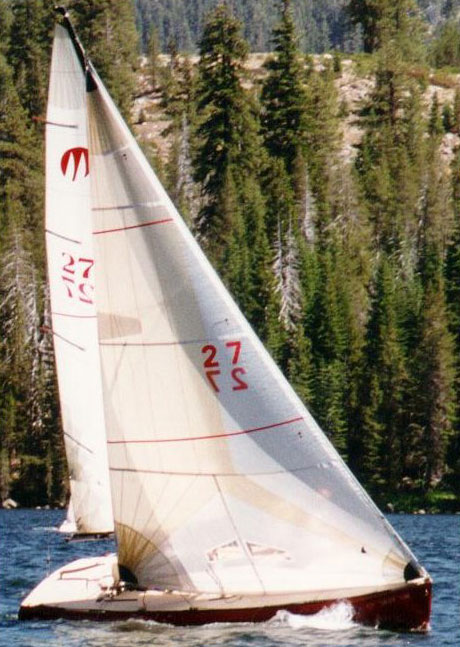
40. Moore 24
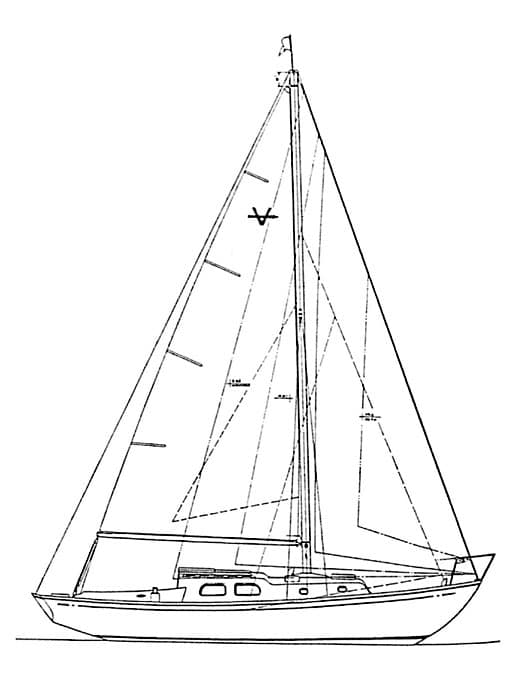
39. Pearson Vanguard
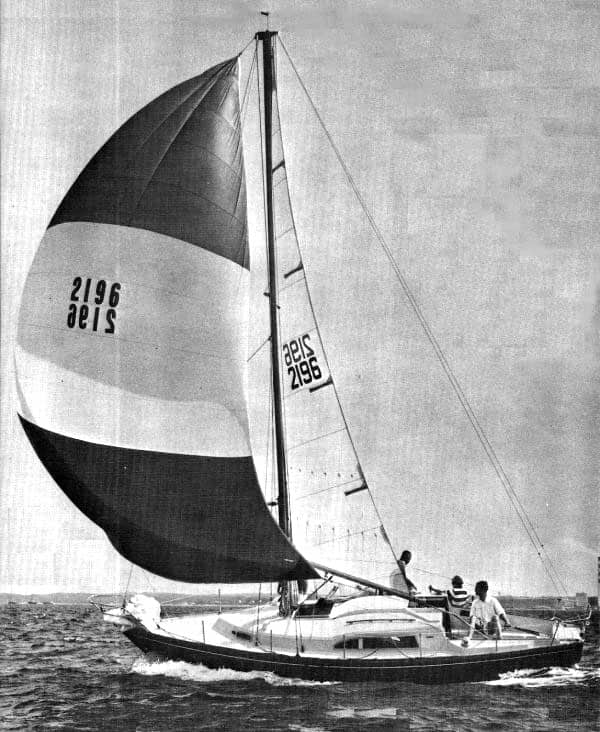
38. Dufour Arpege 30
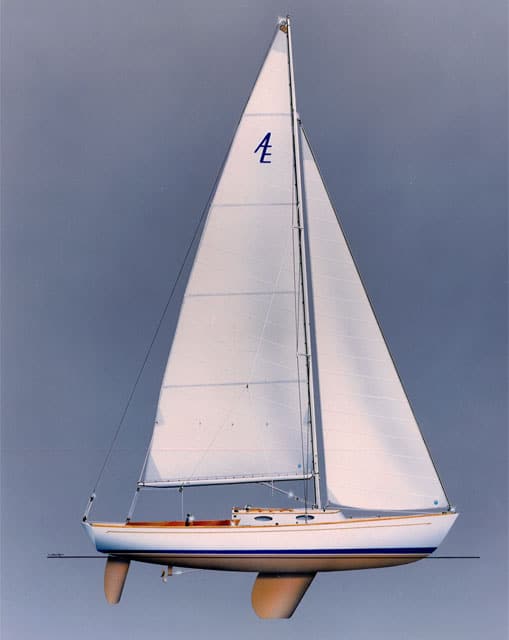
37. Alerion Express 28
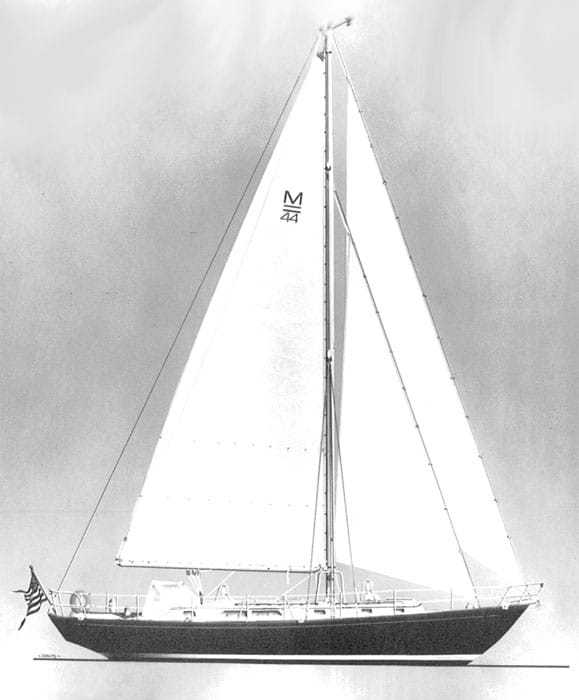
36. Mason 43/44
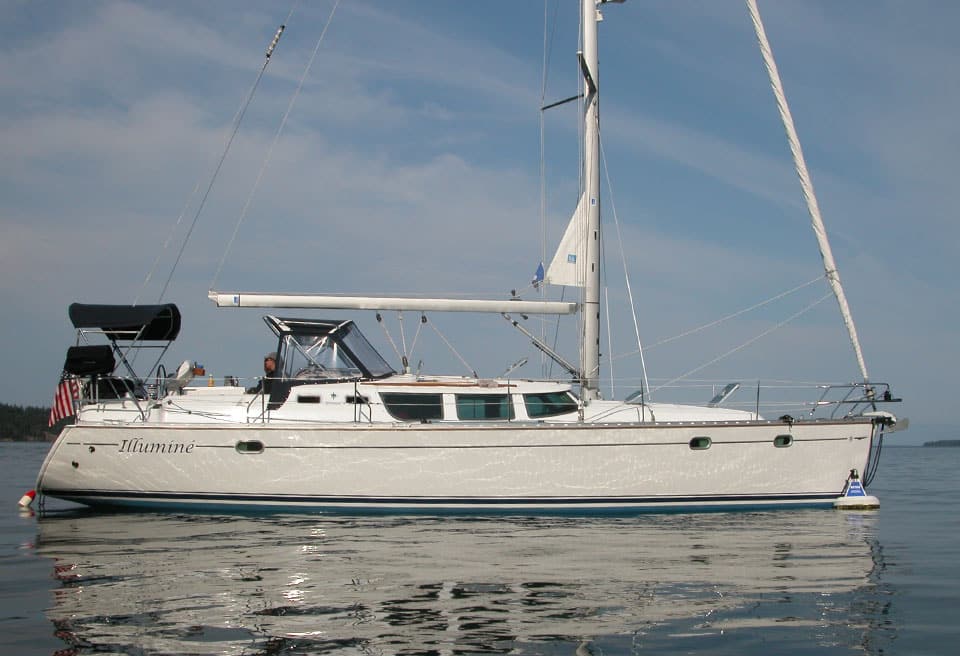
35. Jeanneau Sun Odyssey 43DS
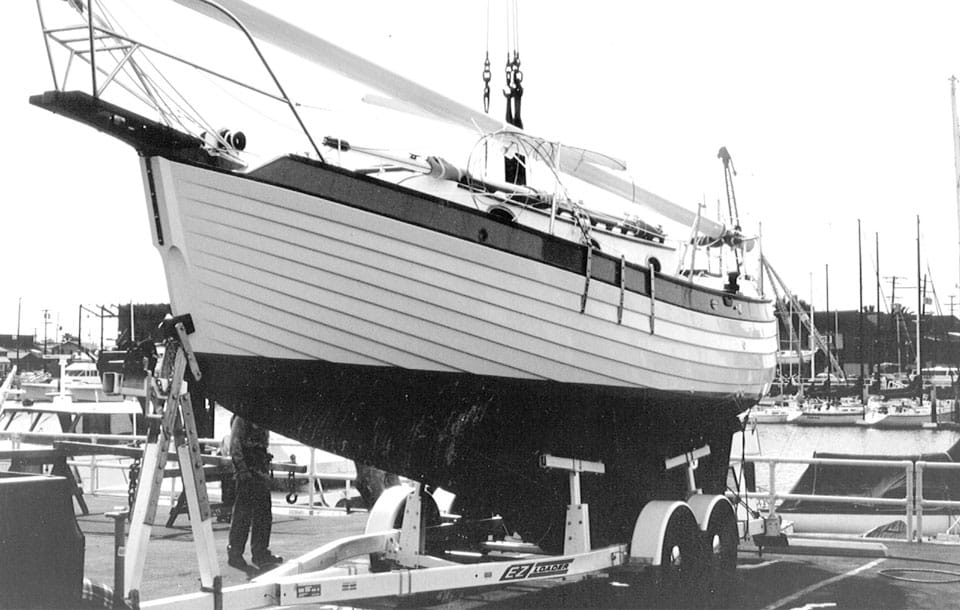
34. Nor’Sea 27
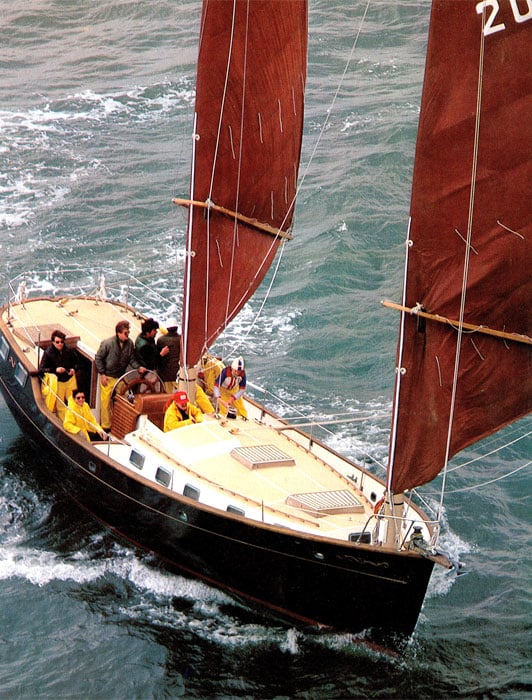
33. Freedom 40
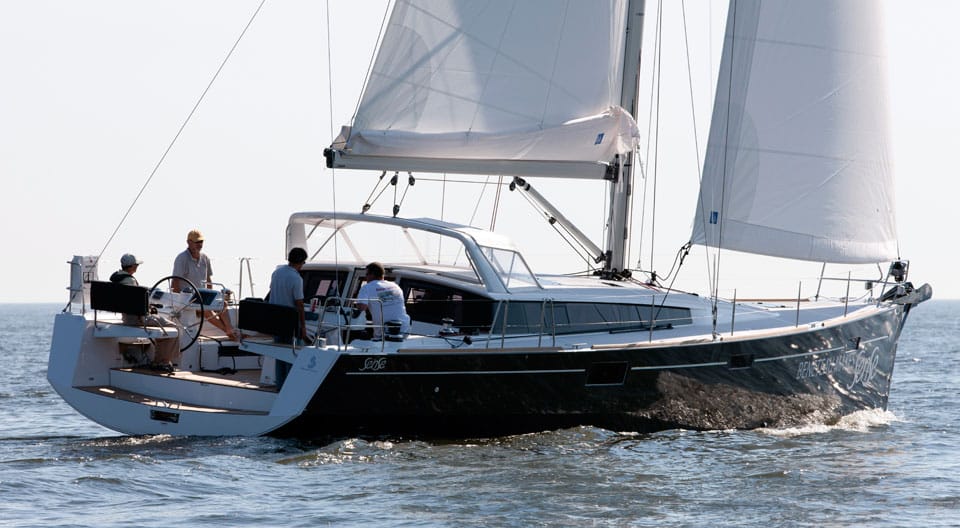
32. Beneteau Sense 50
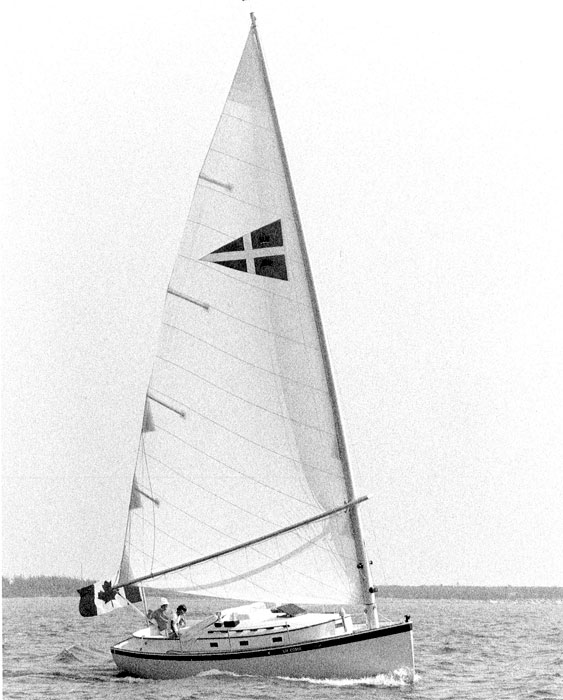
31. Nonsuch 30
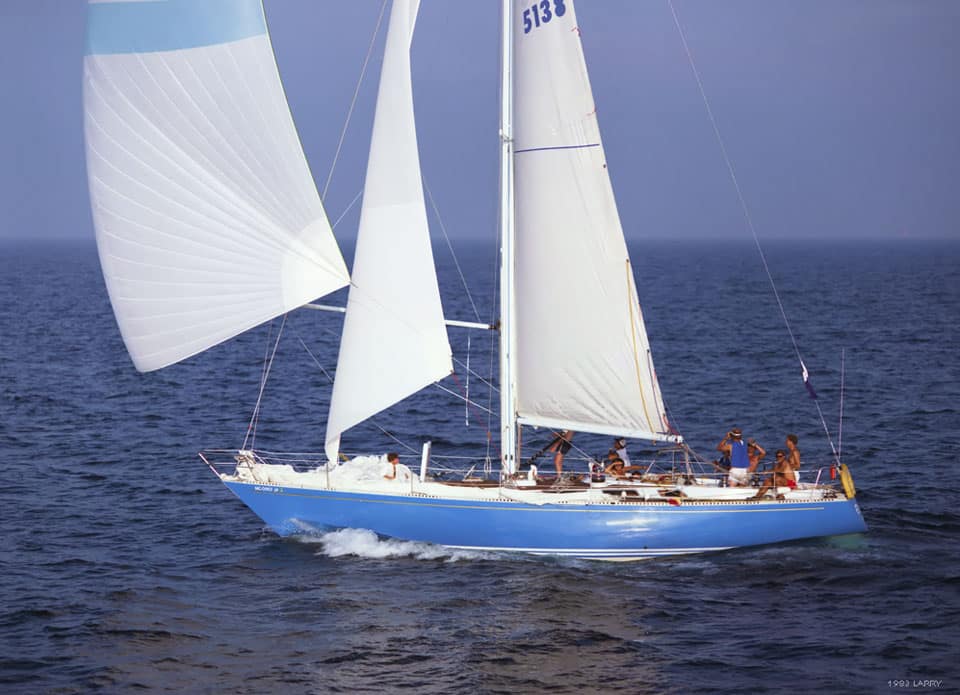
30. Swan 44
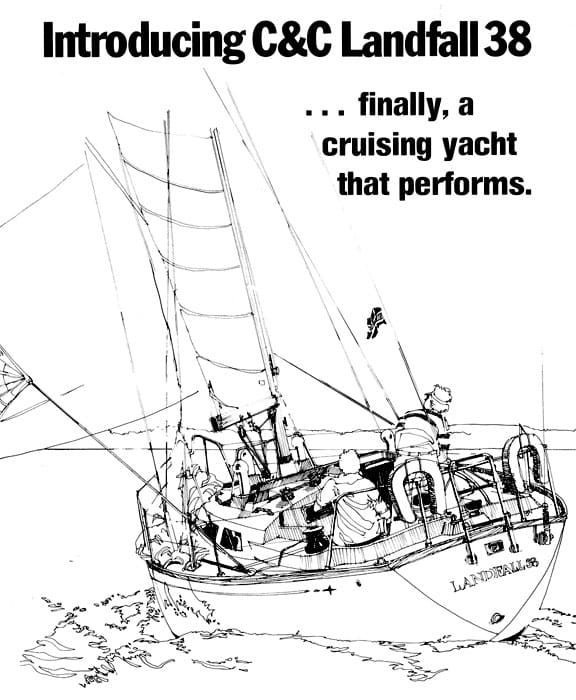
29. C&C Landfall 38
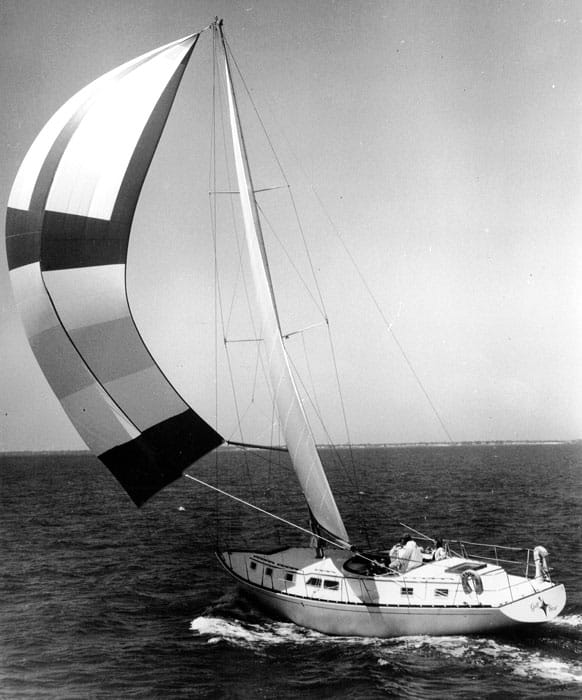
28. Gulfstar 50
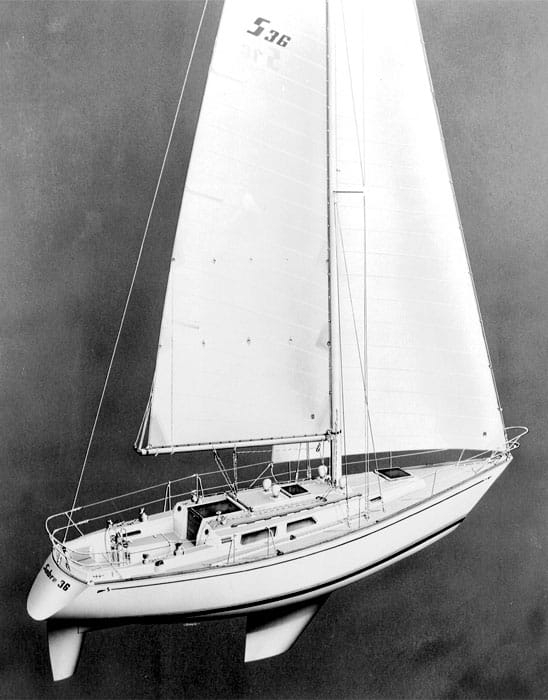
27. Sabre 36
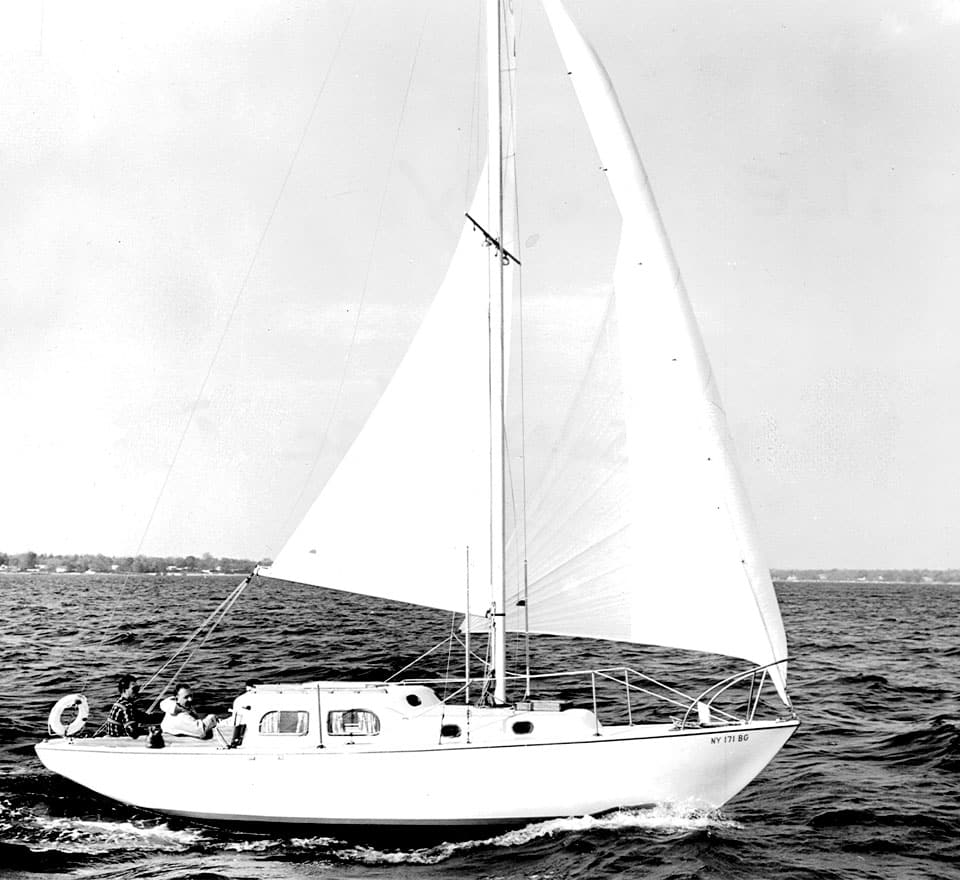
26. Pearson Triton
– CHECK THE FIT – Follow these guidelines to make sure your life jacket looks good, stays comfortable and works when you need it. Safety Tip Provided by the U.S. Coast Guard
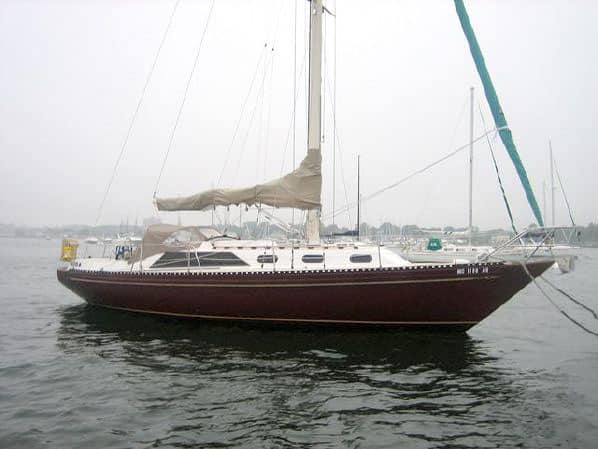
25. Islander 36
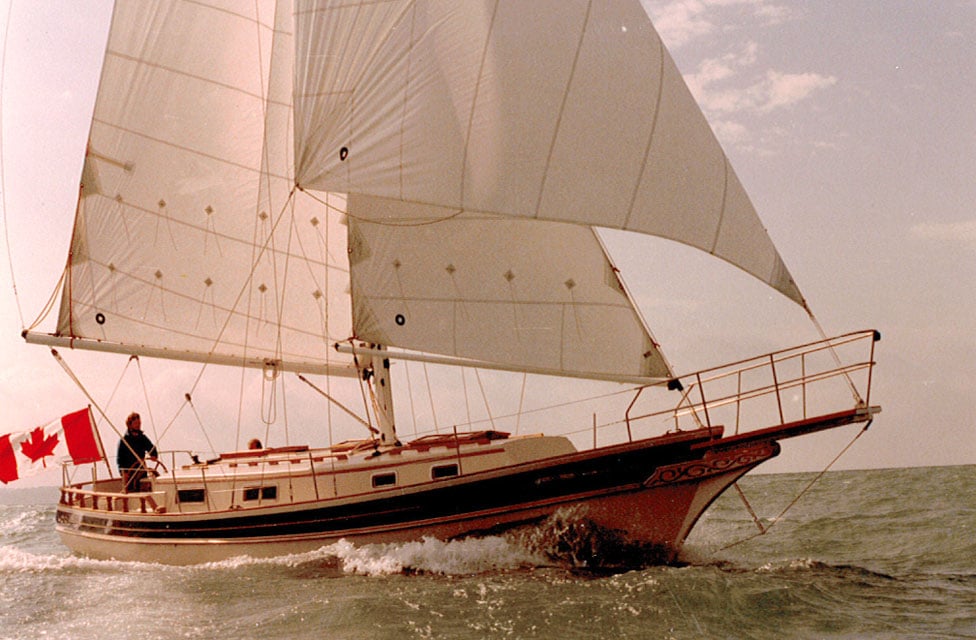
24. Gozzard 36
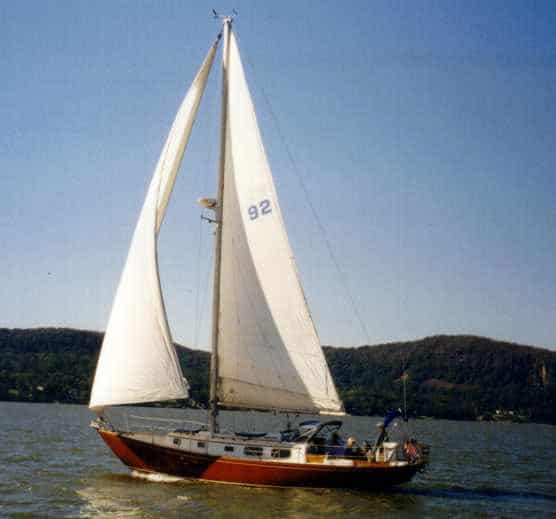
23. Bristol 40
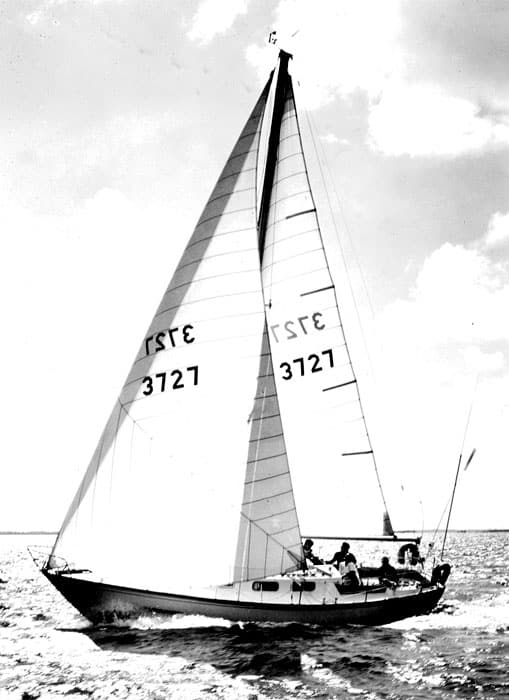
22. Tartan 34
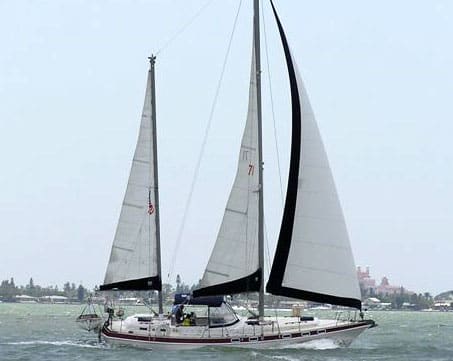
21. Morgan Out Island 41
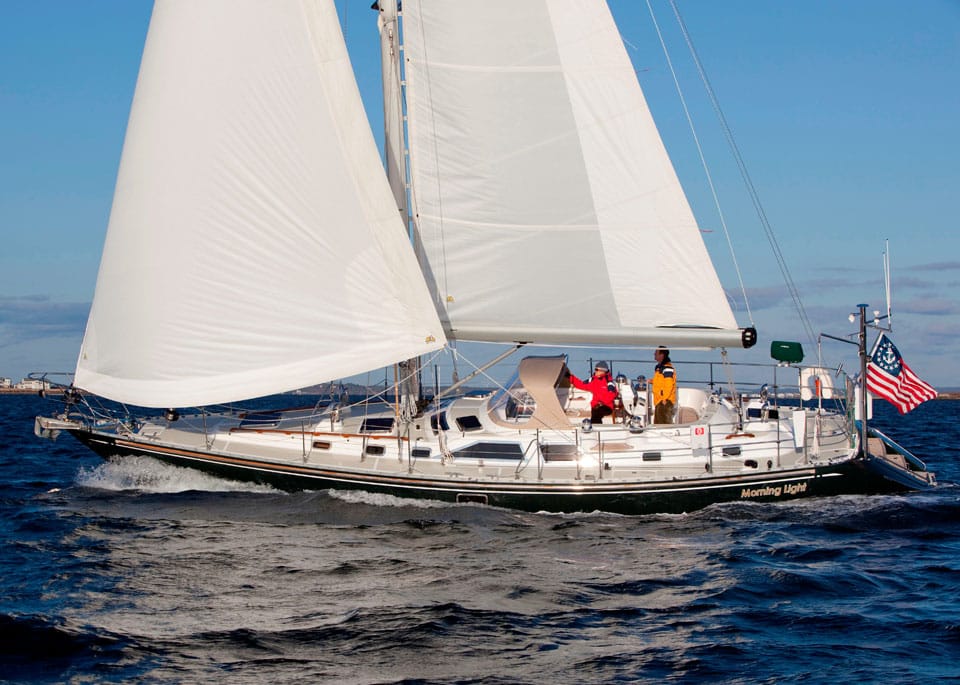
20. Hylas 49
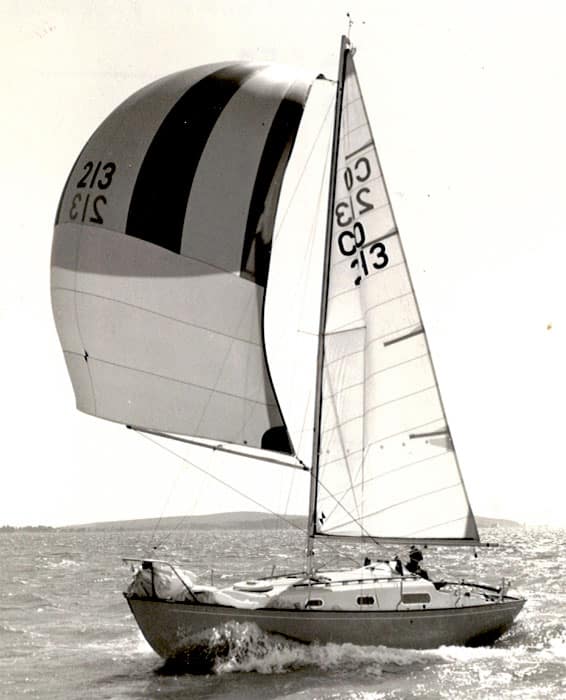
19. Contessa 26
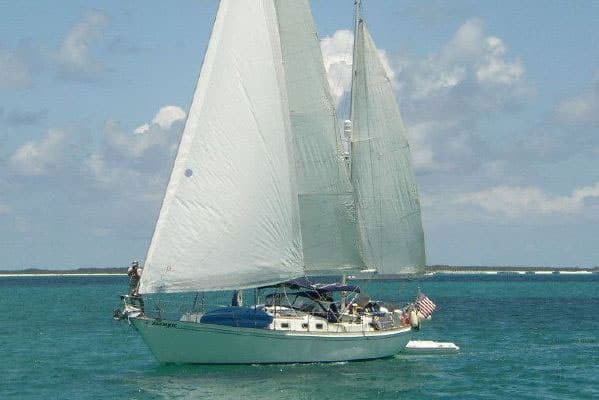
18. Whitby 42
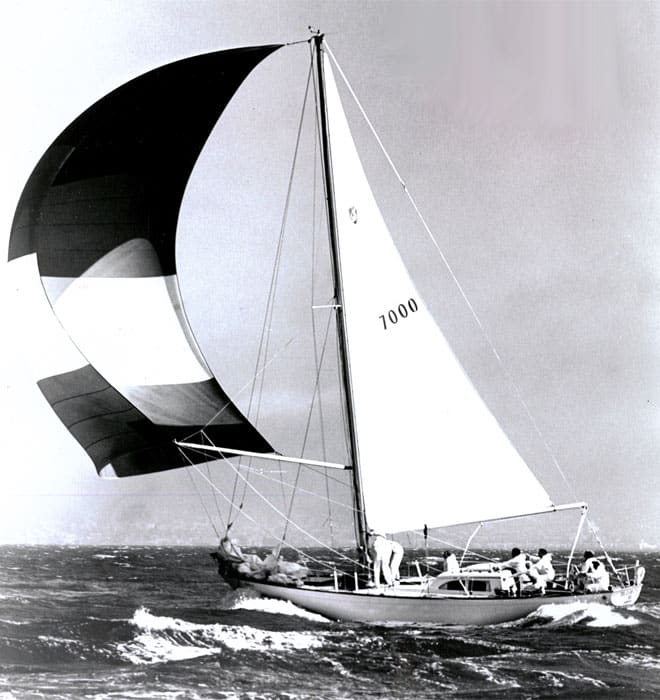
17. Columbia 50
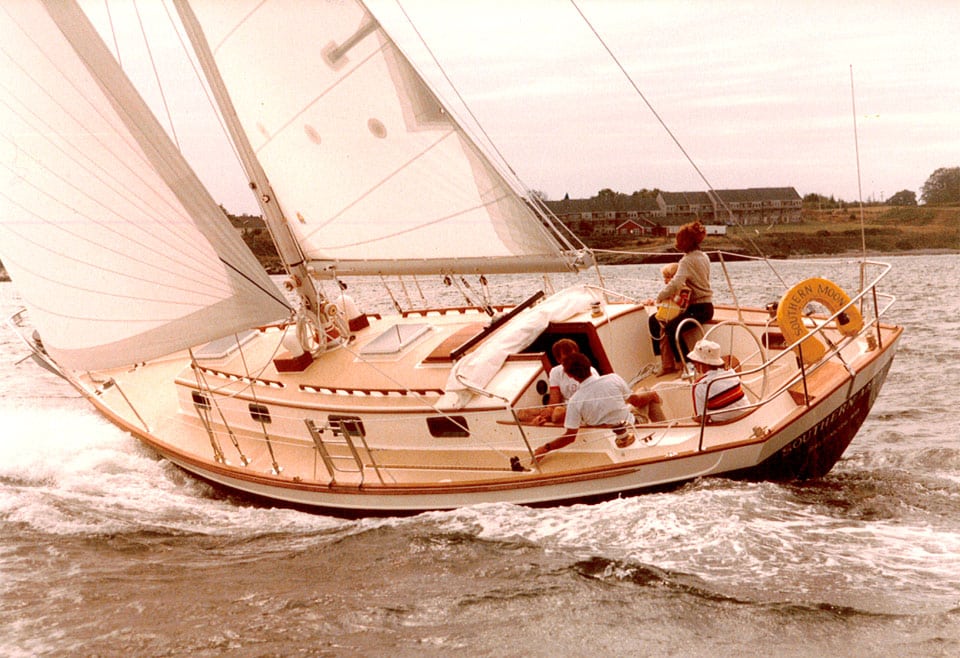
16. Morris 36
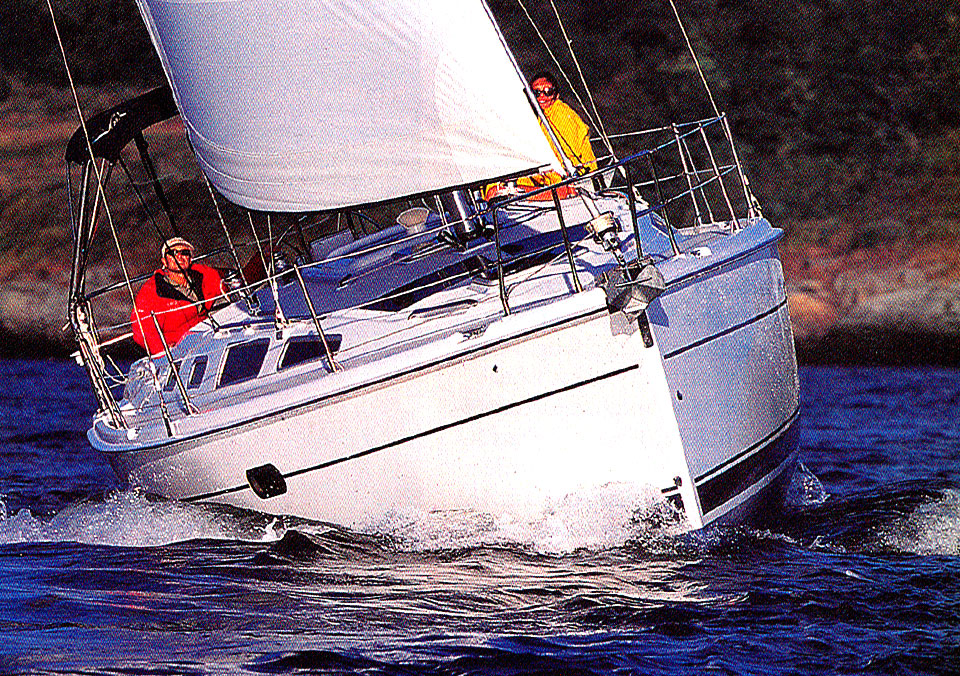
15. Hunter 356
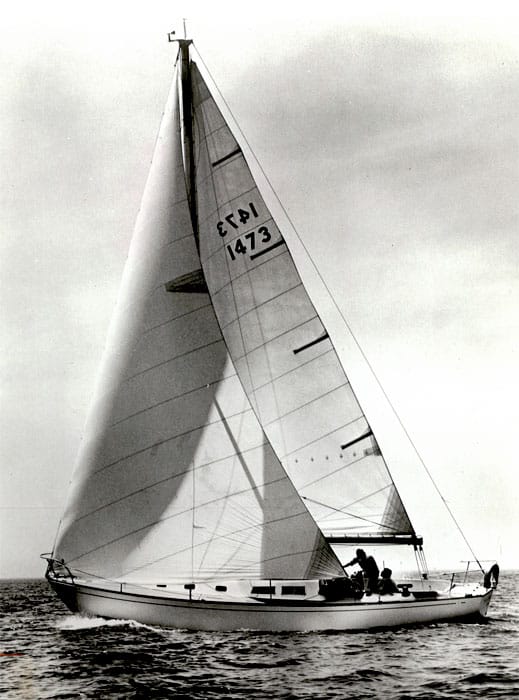
13. Beneteau 423
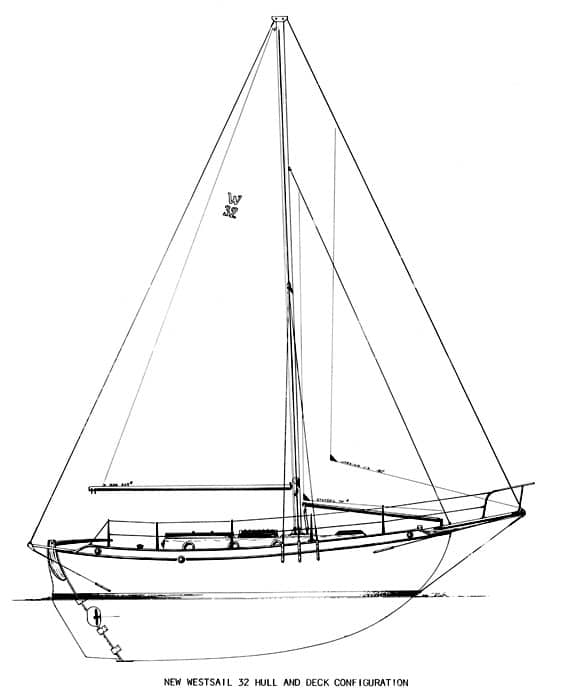
12. Westsail 32
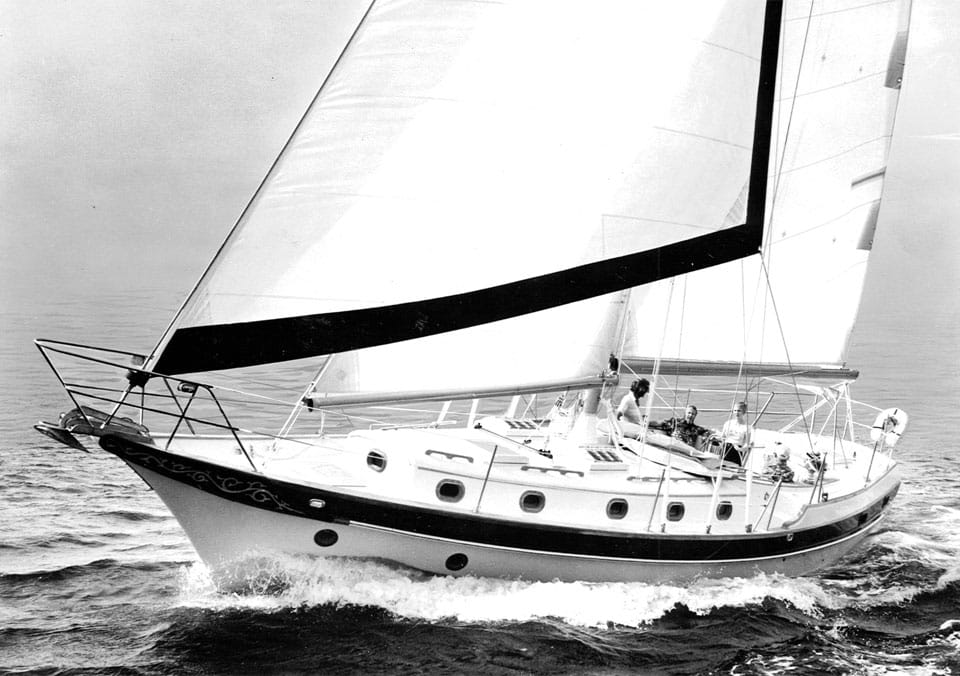
– CHECK THE WEATHER – The weather changes all the time. Always check the forecast and prepare for the worst case. Safety Tip Provided by the U.S. Coast Guard
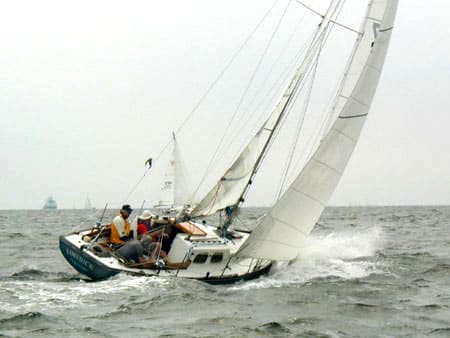
10. Alberg 30
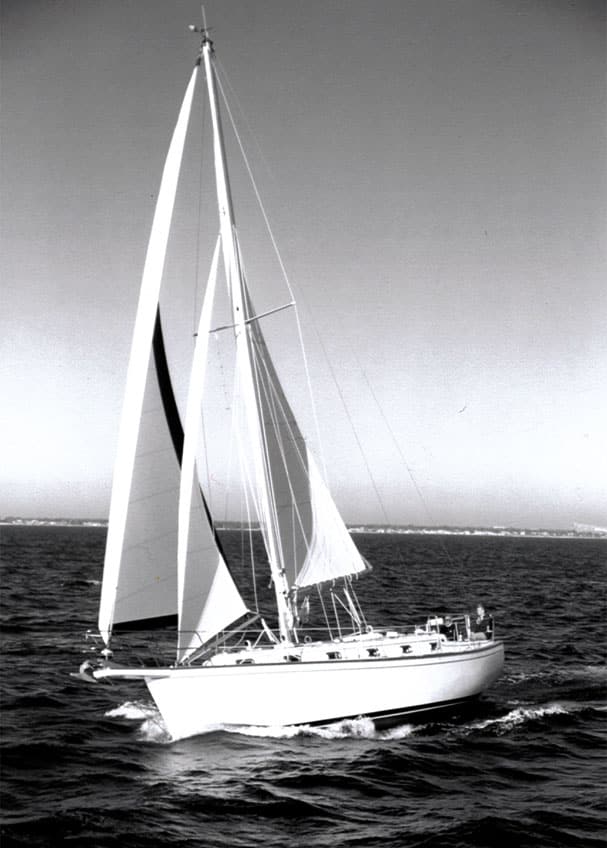
9. Island Packet 38
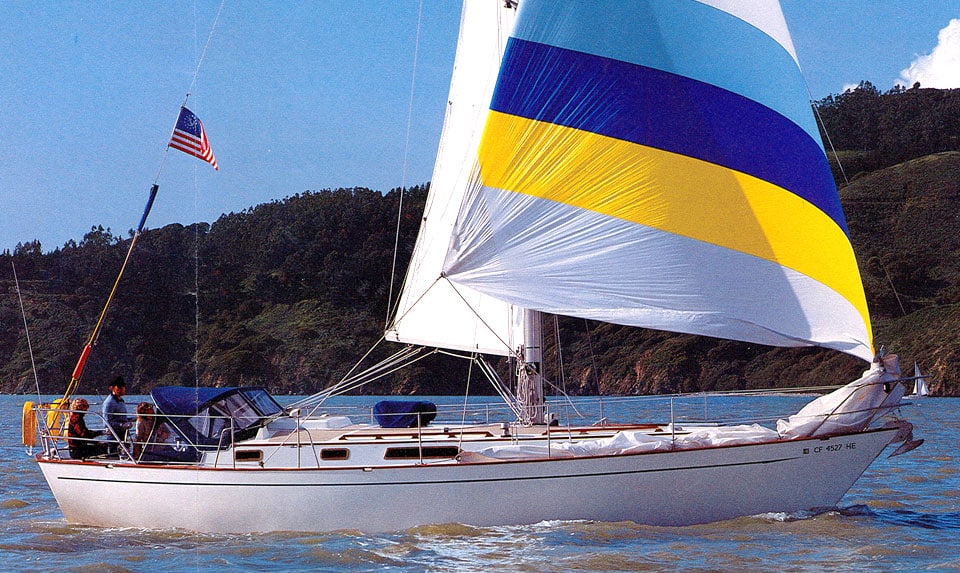
8. Passport 40
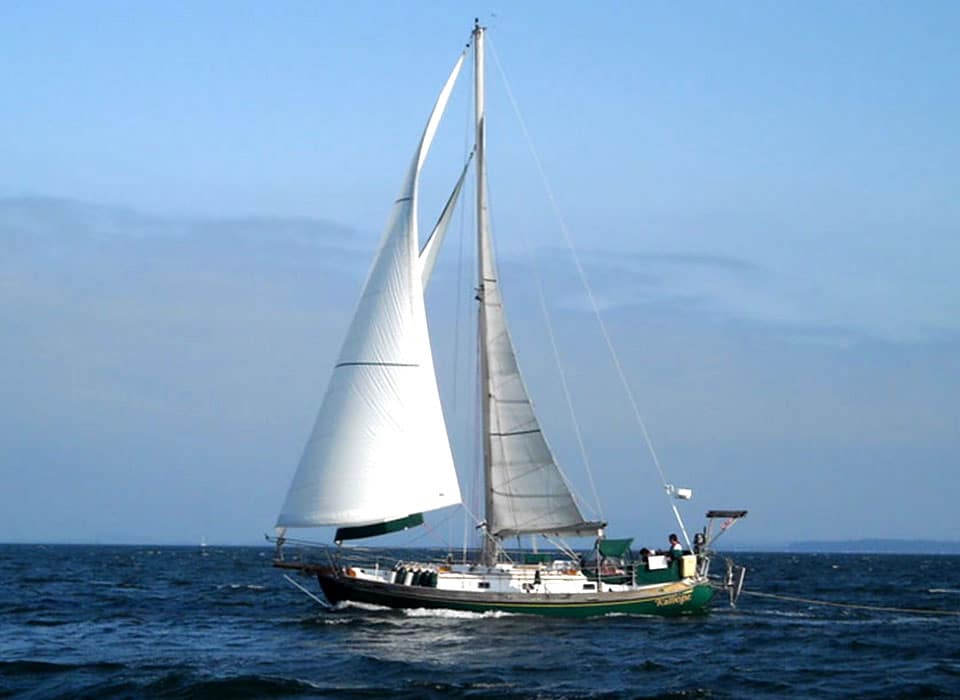
7. Tayana 37
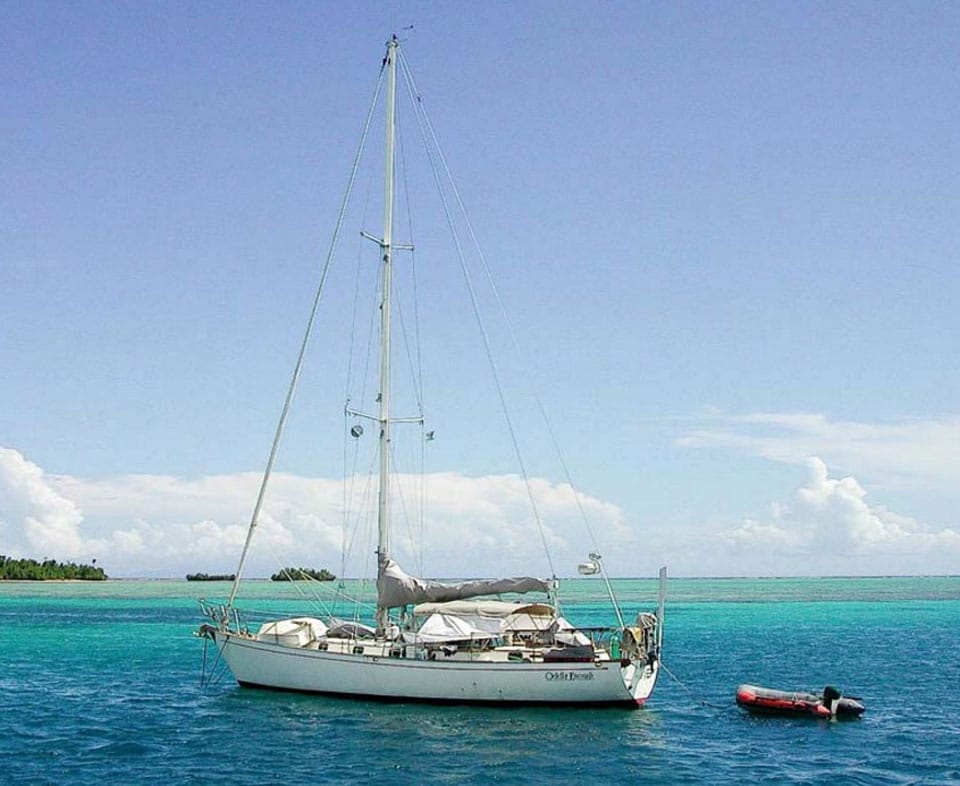
6. Peterson 44
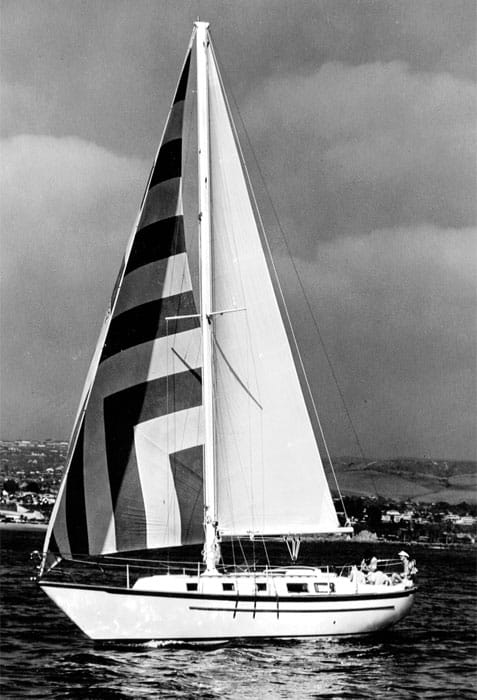
5. Pacific Seacraft 37
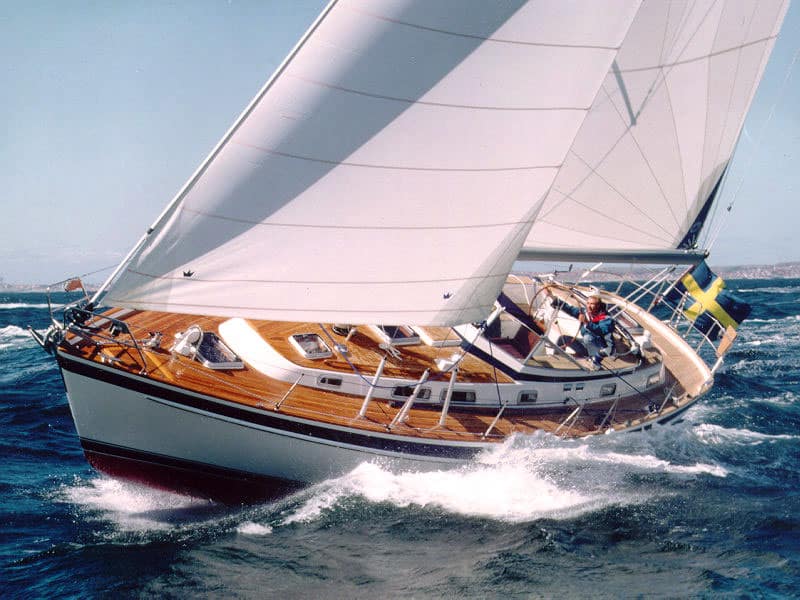
4. Hallberg-Rassy 42
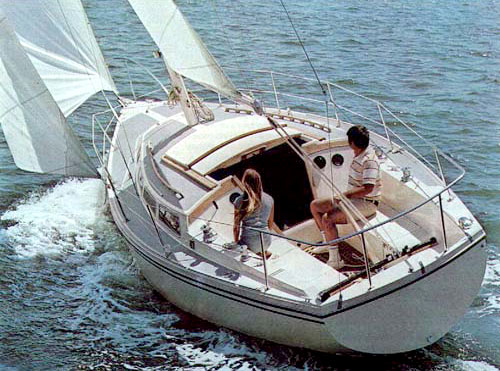
3. Catalina 30
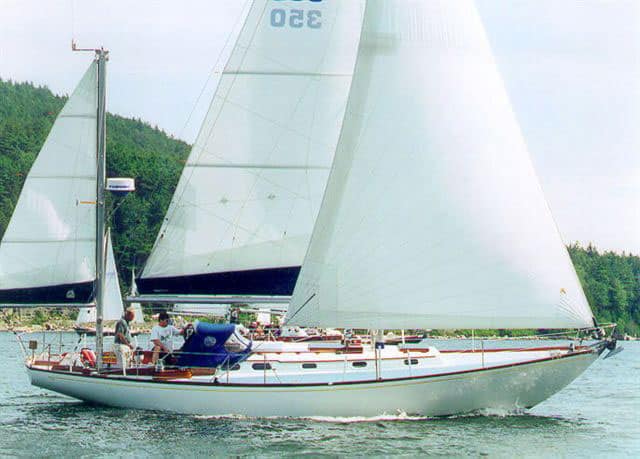
2. Hinckley Bermuda 40
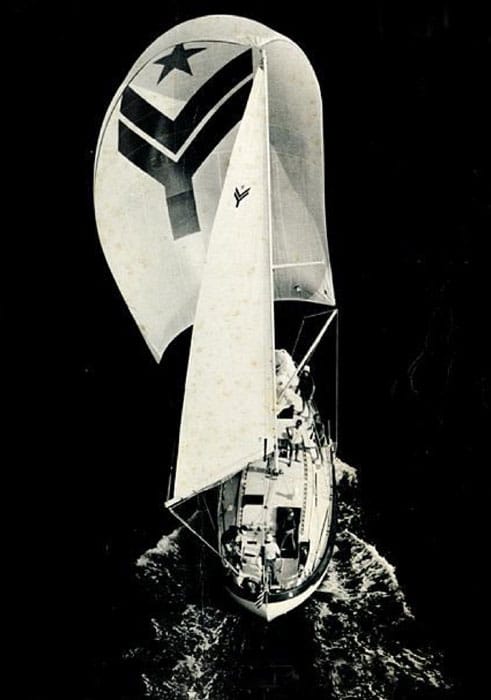
1. Valiant 40
- More: monohull , Sailboats
- More Sailboats

Sailboat Preview: Elan GT6 Explorer

For Sale: 1984 Camper & Nicholsons 58

Alubat Updates OVNI Models

For Sale: Little Harbor 63 Ketch

From Paradise to Medical Emergency: A Bahamas Nightmare Turns Lesson Learned

Free Medical Advice: The Unwarranted, Unprofessional Edition

Gatekeepers of the Waterway

Rigging Redo: Our Switch to Synthetic
- Digital Edition
- Customer Service
- Privacy Policy
- Terms of Use
- Email Newsletters
- Cruising World
- Sailing World
- Salt Water Sportsman
- Sport Fishing
- Wakeboarding

IMAGES
COMMENTS
Reviewing a Class 40 Interior. Down below a Class 40 like the Pogo 40 is a true miracle regarding space. She is a 40 ft. boat - I personally find 40 feet with more than 12.50 meters huge compared to my 33 ft. King´s Cruiser - but due to her extreme width of 4.50 meters internal space is just huge! Even with 5 adults leaving their berths ...
The last of our designs was launched in 2014 with boat number 17. The first of our fifth generation Class 40 racer design is build in South Africa and boat eighteen been ordered already.". Merfyn Owen of Owen Clarke Design. Britton Ward: "In 2009 the class was a rapidly expanding market area and one in which we felt our design capabilities ...
Class 40 is a box rule that has produced boats that are capable of racing fully crewed (typically 3-5 persons) in classic events such as the Fastnet, Bermuda Race, as well as short-handed in races such as the AZAB, TJV and Atlantic Cup. With our latest design that has changed: Dragon 2 has been specifically designed for the Route du Rhum, with ...
The Class40 is a monohull sailboat sea-oriented racing and cruising with a maximum length is 40 feet. The original goal of the class was to make offshore races accessible to amateur sailors. The success of the class has moved it beyond these parameters, with more and more professional sailors attracted to it. Part of the attraction of this ...
The Classic 1960s Ocean Racing Legend. The Cal 40 is a roughly 39-ft 4-in fiberglass production racing and cruising sailboat, of which about 155 were built in Costa Mesa, California, starting in 1963. The first mass-produced sailboat that was capable of sustained surfing on waves, the Cal 40 dominated ocean racing during the 1960s like no other design before or since.
Carbon Ocean Yachts, Bristol, Rhode Island, USA have started to build a new Owen Clarke Design Class40 for an American owner. The design team includes Clay Oliver, engineering by PURE and weather ...
Thunderbird, a Cal 40 owned by IBM president T. Vincent Learson, took first in fleet over 167 boats in the 1966 Bermuda Race. Because this was the first computer-scored Bermuda Race, Learson got a lot of gaff about the IBM computer that had declared him the winner—and about beating out his boss. Thomas J. Watson, IBM's chairman of the board ...
The Cal 40 Dancing Bear is a fine example of a design that's reached cult status with offshore sailors since its debut in 1963. Herb McCormick. You never forget your best day of sailing. Mine came in the waning miles of the 2005 Transpac Race from Los Angeles to Honolulu, screeching down the Molokai Channel under spinnaker toward Diamond Head in 30 knots of pumping trade-wind breeze, hanging ...
Design number: Year:. 2008 The first Humphreys design to the Class 40 box rule is the Orca 40 series built by Ocean Tec in Slovenia. The design is available in two versions - performance racing (optimised to hit Class 40 minimum weight and maximum righting moment) and an interchangeable standard racing / fast cruising version (with removable, modular interior units).
The all new Owen Clarke Design (OCD) Class 40 is for a new owner in the United States. She is a fully custom (although built in female production tooling) Class 40, now under construction at Carbon Ocean Yachts (COY) in Bristol, Rhode Island. Design development began in the Spring of 2014 which has allowed Owen Clarke a good deal of time as ...
But the success and longevity of the Class40 is due to its highly constrictive box rule, drafted by a group that includes wise French sailor and journalist Patrice Carpentier, which remains robust ...
The rig dimensions above are from the 1963 sail plan drawing. Current class rules (2005) allow a max of: I - 46.7'. J - 15.3'. P - 40.1'. E - 17.55'. The accolades for this particular boat are many. Certainly one of the most influential designs and successful racing boats ever. With 160 built, it was also a commercial success for Jensen Marine.
The Class 40 is a cheaper boat that can be sailed competitively in a range of conditions either short handed, by two people, or a solo sailor. The class is active in Europe, but growing in North America. Boats are built on a semi-production or custom basis. The class rules though work to keep the boat affordable, limiting exotic materials and ...
Following in the wake of her elder sister the Oceanis 46.1, this 40-foot cruiser, with a new hull design by Marc Lombard, offers unrivaled deck volume and interior space, with zero concessions to performance.The Oceanis 40.1 is available in different layouts, drafts and rig options, adapting to the most demanding sailor's cruising requirements and satisfying their need for comfort and ...
The Cal 40 is a racing keelboat, built predominantly of fiberglass, with wood trim. It has a masthead sloop rig; a spooned, raked stem; a raised counter, transom; an internally mounted spade-type rudder controlled by a tiller and a fixed fin keel. It displaces 15,000 lb (6,804 kg) and carries 6,000 lb (2,722 kg) of lead ballast.
Oct 1, 2017. Marilee's new interior artfully pays tribute to classic Herreshoff styling. Marilee is one of six New York 40s still living, sailing and racing. The yachts of this class were the Duesenbergs of the sea, representing a high point in the Golden Age of Sail. Each remaining NY40 is precious. Dennis Caprio.
The epoxy glass/foam sandwich inshore design rates 1.213 under IRC and our offshore design with the water ballast option 1.225. High performance yacht designers Owen Clarke Design have created their first mid-size IRC / ORC, fast 40 type racing sailboat design. Developed to be a winning yacht in rating rule inshore events and offshore races ...
Class 40. Class 40 is a yacht builder that currently has 20 yachts for sale on YachtWorld, including 1 new vessels and 19 used yachts, listed by experienced yacht brokers and boat dealerships mainly in the following countries: France, Croatia, United States, United Kingdom and Martinique. Models currently listed on YachtWorld span in size and ...
Winner: Elan GT5. This is going to be a tough category," said Bill Bolin of the Best Midsize Cruiser 40 to 44 Feet division. "We have three very different but very good boats in this class — the Elan GT5, the Hallberg-Rassy 412 and the Jeanneau Sun Odyssey 440.". To begin, Bolin said of the Jeanneau Sun Odyssey 440, "It's the best ...
Class 40 . www.class40.com. International Class 40 web site. Related Sailboats: Sort by: ... 5 Sailboats / Per Page: 25 / Page: 1. 0 CLICK to COMPARE . MODEL LOA FIRST BUILT FAVORITE COMPARE; AKILARIA 40: 39.96 ft / 12.18 m: 2007: JPK 40: 39.96 ft / 12.18 m ...
40 to 50 indicates a heavy bluewater boat; over 50 indicates an extremely heavy bluewater boat. Comfort ratio = D ÷ (.65 x (.7 LWL + .3 LOA) x Beam^1.33), where displacement is expressed in pounds, and length is expressed in feet. Capsize Screening Formula (CSF): Designed to determine if a boat has blue water capability.
35. Jeanneau Sun Odyssey 43DS. Designed by French naval architect Daniel Andrieu, the 43DS—for deck saloon—was one of the company's first forays with the concept of adding a raised deck with plenty of windows for interior light and visibility, as well as increased volume and living space.
Because after 40 years, that teak veneer is failing. Bubbling, peeling, stained by old leaks. Further, as we have adapted the cabin layout to better fit our needs over time, it's become somewhat patchwork. Let's call this the gift of covid: tearing into areas that needed fix (bulkhead rot) made the rest that much easier.